






Cheche Alara B.M. ’94 on how he became a multihyphenate talent, why he doesn’t give career advice, and why musicians shouldn’t forget that they are artists first.
BY KIMBERLY ASHTON
Artistry
Berklee professors and alumni consider the brave new world of music in the age of AI.
BY MICHAEL BLANDING
The Latin Grammy Cultural Foundation, along with prominent artists, has awarded Berklee students more than $5 million in scholarships. BY KIMBERLY ASHTON
Music educators from elementary schools to high schools are using a wider repertoire, and technology, to engage an increasingly diverse student body.
BY REBECCA BEYER
FACULTY FEATURE
Enrique Gonzalez Müller Creates the Pedagogy Arts Collective BY
MARK SMALL
Faculty Notes 41
FROM OUR ALUMNI COMMUNITY Alum Notes 48
ALUMNI PROFILES Laufey 51 BY CHESTON KNAPP
Edward Moreta 53 BY DARRY MADDEN Final Cadence 54
Coda Representation Counts in Jazz Faculty BY
LYNE CARRINGTON AND AJA BURRELL WOOD
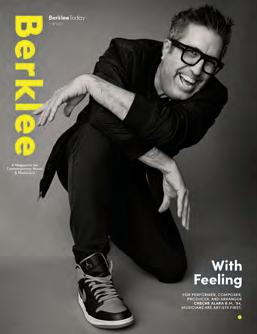
EDITORIAL DIRECTOR OF BERKLEE TODAY
Kimberly Ashton
CONTRIBUTING WRITERS
Rebecca Beyer, Michael Blanding, Terri Lyne Carrington, Cheston Knapp, Darry Madden, Mark Small, Aja Burrell Wood
DESIGN
Patrick Mitchell, André Mora
MODUSOP.NET
COPY EDITOR
Diane Owens
CONTRIBUTING ARTISTS
Ari & Louise, Kelly Davidson, Matt Kalinowski, Greg Mably, Helena Pallarés, Anthony Russo, Brian Stauffer
Berklee Today | Fall/Winter 2023
A PUBLICATION OF THE COMMUNICATIONS AND MARKETING DIVISION
CLAIRE MACHAMER, SENIOR VICE PRESIDENT
EDITORIAL DEPARTMENT
DIRECTOR
Nick Balkin
SENIOR COMMUNICATIONS MANAGER
Bryan Parys
COMMUNICATIONS MANAGER
John Mirisola
PROOFING MANAGER
Lesley O’Connell
OFFICE OF INSTITUTIONAL ADVANCEMENT
SENIOR VICE PRESIDENT INSTITUTIONAL ADVANCEMENT
Erin Tunnicliffe
SENIOR DIRECTOR
ALUMNI AFFAIRS AND ANNUAL GIVING
Joseph Dreeszen
ASSOCIATE DIRECTOR
ALUMNI AFFAIRS/LOS ANGELES
Dana M. James B.M. ’09
As the alumni-oriented magazine of Berklee College of Music, Berklee Today is dedicated to informing, enriching, and serving the extended Berklee community. By sharing information about college matters, music industry issues and events, alumni activities and accomplishments, and musical topics of interest, Berklee Today serves as a valuable forum for our family throughout the world and a source of commentary on contemporary music.
Berklee Today (ISSN 1052-3839) is published twice a year by Berklee College of Music’s Communications and Marketing Division. All contents ©2023 by Berklee College of Music. Send all address changes, press releases, letters to the editor, and advertising inquiries to Berklee Today, Berklee College of Music, 1140 Boylston St., Boston, MA 02215-3693, +1 617-747-2843, kashton@berklee.edu. Alumni are invited to send in details of activities suitable for coverage. Unsolicited submissions are accepted. Alum Notes may be submitted to berklee.edu/ alumni/forms/alumni-updates. To manage print or digital subscriptions, go to college.berklee.edu/ alumni/bt/subscribe. Visit us at berklee.edu/berklee-today.

angel investors.


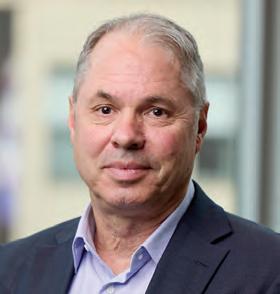
David Bogen Interim President & Provost
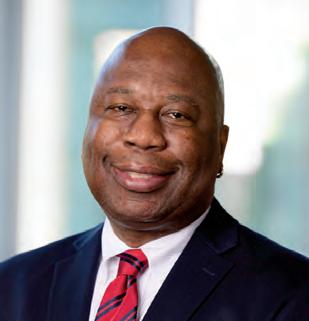
I want to congratulate Ron Savage on his appointment as the inaugural vice president and executive director of Berklee College of Music. Ron brings over 40 years of experience at Berklee to this role—as a student, a faculty member, and in various leadership roles. As dean of the Professional Performance Division, he led a number of successful initiatives around curriculum development, diverse hiring, faculty support, and student recruitment, and is the cofounder and cochair of the Black Scholars Initiative (BSI), established in 2017 to foster community, support, and a sense of belonging among Black and African American students.
This fall, we also launched a mission, vision, and strategic planning process that will engage students, faculty, staff, parents, and alumni from across our entire community—the Conservatory; the College; Pre-College, Online, and Professional Programs (POPP); Berklee Valencia; Berklee NYC; and Berklee Abu Dhabi. You can follow the progress at berklee. edu/strategic-planning.
Thank you to everyone in our community for your ongoing engagement, interest, and support. Together, we will build the future of learning at Berklee.
Ron Savage Vice President & Executive Director
It is my honor and privilege to write to you as the inaugural vice president and executive director of Berklee College of Music.
As alumni, you are the heartbeat of this institution. Your lived experiences keep us grounded, inspired, and informed as a family of artists, shaping Berklee’s legacy.
As Berklee’s reach continues to expand globally, we are embracing some new things unfolding in Boston:
3 An independent recording and production major boasting 400 students in just one year.
3 The launch of the new Black music and culture major in fall 2022, led by the dean of the Africana Studies Division, Dr. Emmett G. Price III.
3The inaugural year of the Berklee Somos LatinX preorientation program.
3 A reimagined Screen Scoring Department offering degrees in film and media scoring, and game and interactive media scoring.
3 Twelve institutes, including the Berklee Institute of Jazz and Gender Justice, the Berklee Global Jazz Institute, and the Berklee Institute for Accessible Arts Education continue to enrich the student experience.
3 A Career Center providing real-life industry opportunities to bridge the gap from classroom knowledge.
I encourage you to stay connected to fellow alumni and our on-campus community. Until next time...keep swinging!
SONGWRITING MAJOR KATE KIBBY PERFORMS AT THE NEW STUDENT ORIENTATION SHOW ON AUGUST 23 AT THE BERKLEE PERFORMANCE CENTER.
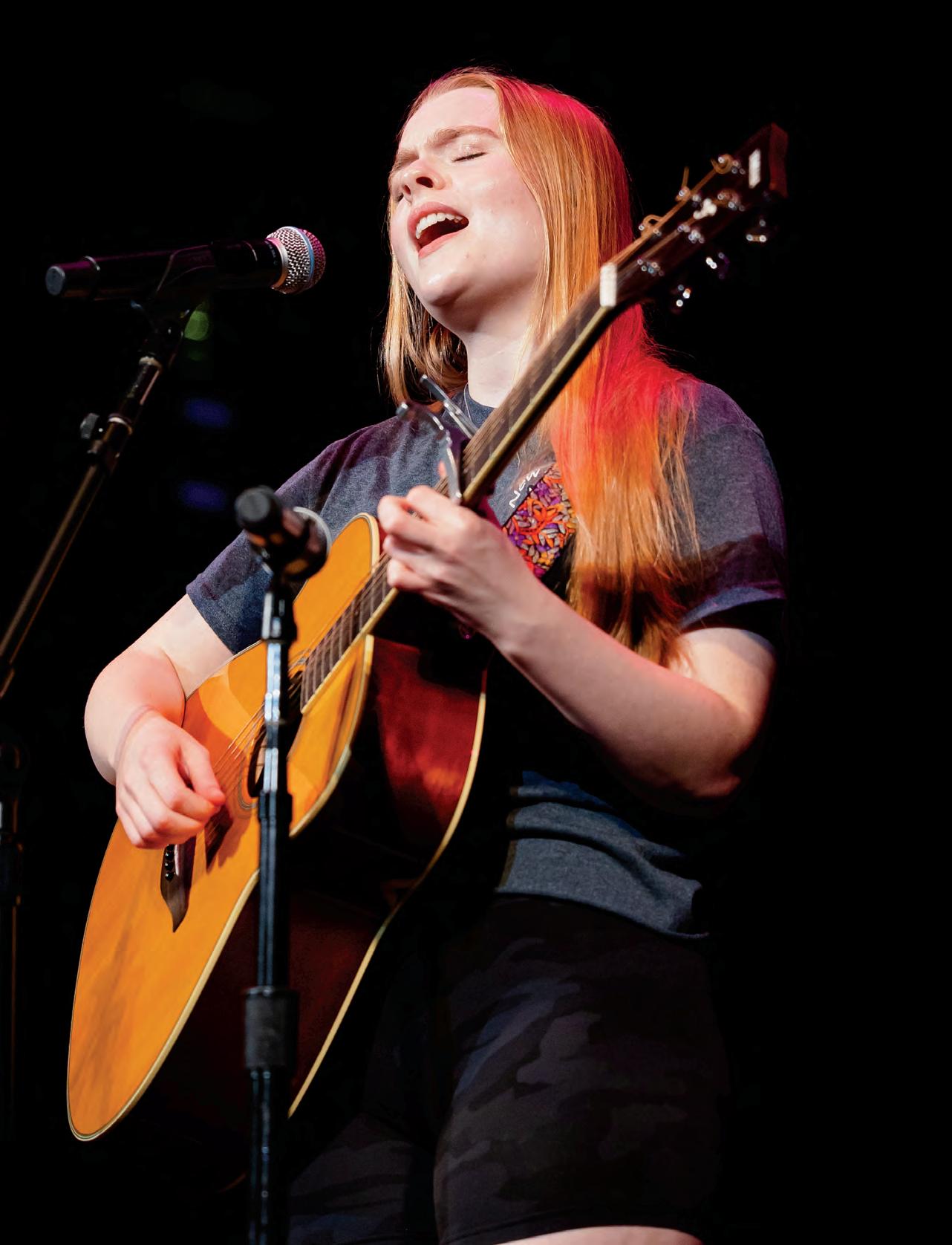
BY KIMBERLY ASHTON
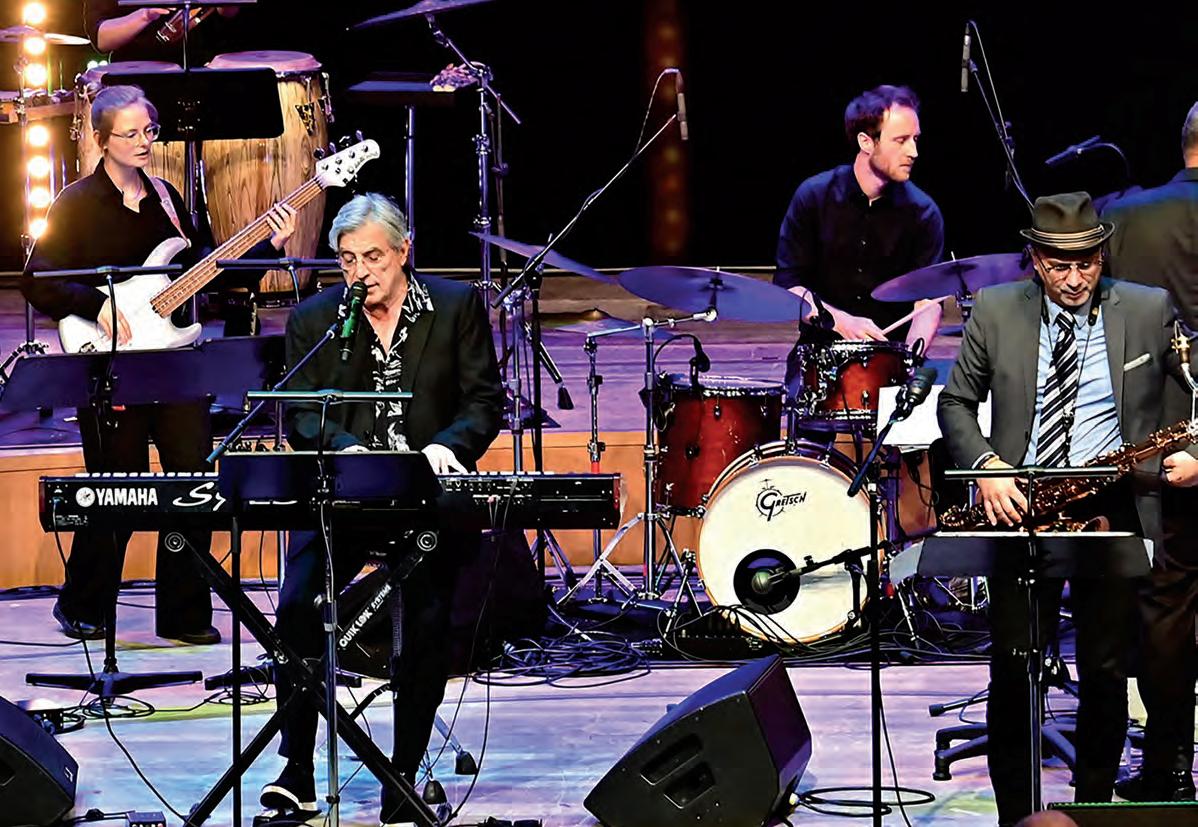
MARCO PIGNATARO recalls being in the audience this summer when German jazz guitarist Elias Prinz and his trio took the stage at Munich’s Isarphilharmonie concert hall. Prinz, a 23-year-old student at the Jazz Institute at the University of Music and Performing Arts Munich, had just won first place in the institute’s renowned Kurt Mass Jazz Award competition, and his set followed high-octane jazz displays by the competition’s second- and third-place winners. But as Prinz settled in and began strumming his opening chords, the tone of the evening shifted.
“When he started playing, I was like, ‘What? What is this?’” says Pignataro, the artistic director of the Berklee Global Jazz Institute (BGJI). “And then I was like, ‘Oh, wait a second. This is really special.” In contrast to the performances earlier in the evening, Prinz’s music was intimate and unusual, influenced by the
music of Django Reinhardt.
“I felt he was bringing something not just that he loves but that he identifies [with] in a way that was extremely convincing,” Pignataro says. “So it wasn’t like hearing something nostalgic from the past. To me, he made that music really in-the-moment. He made it very relevant.”
After the set, he says, the audience went crazy. “[Prinz] was playing in a way that everybody could really connect with the emotions…it was how musical he was, how brilliantly expressive he was with his own music.”
As first-place winner, Prinz earned a full scholarship to Berklee’s Aspire: Five-Week Music Performance Intensive this past summer. Now in its 10th year, the biennial competition honors the legacy of KURT MASS ’65, a jazz pioneer who for years was the exclusive distributor of Berklee publications in Germany and who founded and developed the Jazz Institute in Munich.
“He was the guy who started academic jazz education in Munich,” says CAMILO DORNIER ’81, who confounded the award with institute chair Claus Reichstaller and funds the prizes.
In the late ’70s, Dornier had been a student of classical music when he took a noncredit class for jazz enthusiasts that Maas taught. On Maas’s recommendation, Dornier came to Berklee to further explore jazz.
When Maas died in 2011, Dornier wanted to find a way to honor him. The following year, he and Reichstaller came to Boston, where ABRAHAM LABORIEL SR. B.M. ’72, ’05H connected them with then-President Roger Brown, who liked their idea for the Kurt Mass Jazz Award.
Now, as Dornier and Reichstaller eye the future, they are working to expand the award program. Two years ago, they began developing partnerships with two Brazilian schools, including Berklee academic
partner Faculdade e Conservatório Souza Lima, and now offer scholarships that send two Brazilian students to Munich for four weeks. This year, part of the award ceremony concert was dedicated to Ivan Lins, a superstar of Brazilian music who, along with Pignataro, performed as a special guest artist.
In addition to building out the Brazilian program, Dornier and Reichstaller are looking to deepen the institute’s involvement with Berklee. Their goal is to offer first-place winners a semester at Berklee, and possibly to develop a student and faculty exchange. Pignataro says such a program would be valuable not only for the Munich institute but also for the BGJI.
The possibilty of benefitting from such an exchange was one of the reasons Prinz took part in the competition, which is open only to Jazz Institute students. He had been playing guitar since he was 5 and studying Reinhardt
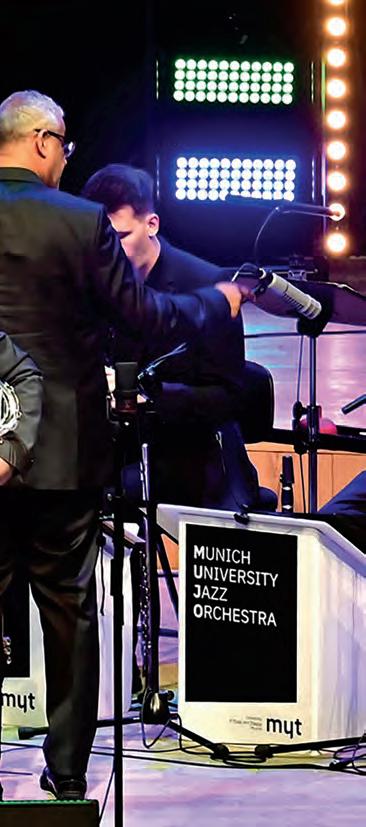
since the age of 12, and wanted to come to Berklee to deepen his knowledge of other jazz genres. He arrived in Boston freshly graduated from the Jazz Institute in Munich, but he still found a level at Five-Week that was well-suited to him. “I can improve [upon] everything I learned the last four years. And because it’s so intensive, I feel like I learned very, very quickly,” he says. After the program, Prinz returned to Germany to work on his first album. In the meantime, he’ll continue to play in Munich and share his influences from Berklee.
It’s this type of sharing and enrichment that will keep jazz alive, Dornier says. “I think we have to be aware that jazz on the global scale is a very small, tiny percentage of music. To be strong, to keep this whole thing running, we have to think internationally, we have to cooperate, we have to exchange, and we have to work together.”
BY DARRY MADDEN
Brenda Friend Brandt met John “Arch” Ellsworth in 1972, when he was gigging around Massachusetts with his band, Eliza Moon. He was a self-taught guitarist and she was on the verge of her college years.
“Arch and I were love at first sight,” BRANDT B.F.A. ’76 says. He encouraged her to follow her dream of becoming an actress and enroll at Boston Conservatory. She, in turn, inspired him to enroll at Berklee.
Though their romantic relationship didn’t last, their friendship did. When Ellsworth died in 2015, Brandt wanted to find a way to honor him. She teamed up with his children, Avery and Anna Victoria Ellsworth, to create the John “Arch” Ellsworth Endowed Scholarship in 2021. Together, they’ve raised $38,750 of the $50,000 needed to fully endow the fund.
“Establishing a scholarship in memory of a loved one ensures that person’s passion for music lives on through the students who receive this support,” says Ginny Fordham, senior managing director of Berklee’s office of Institutional Advancement.
ELLSWORTH B.M. ’77 was a passionate musician who found incredible joy and camaraderie in his years at Berklee. The fund will support students who are financially and academically deserving and have the potential to make a significant contribution to society through music. Preference will be given to instrumentalists, composers, or arrangers—especially those who are the first in their family to pursue higher education—and will emphasize diversity, equity, and inclusion. Brandt is asking both her and Ellsworth’s fellow alumni to help her complete the fund.“I don’t think there is a better way to show the love and support we have for the schools that started us on the journey than to know we are securing their future.”
To make a gift please contact Ginny Fordham at vfordham@berklee.edu.
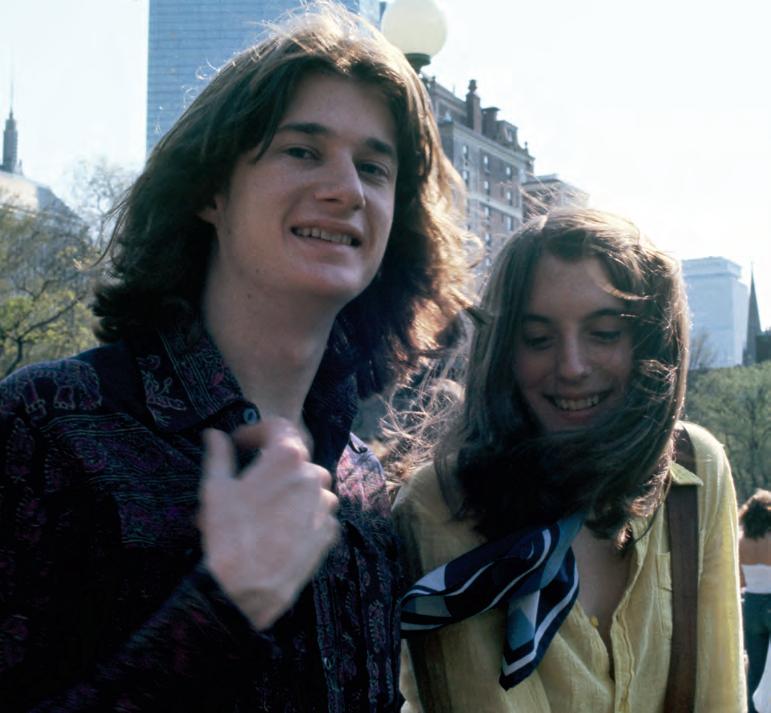
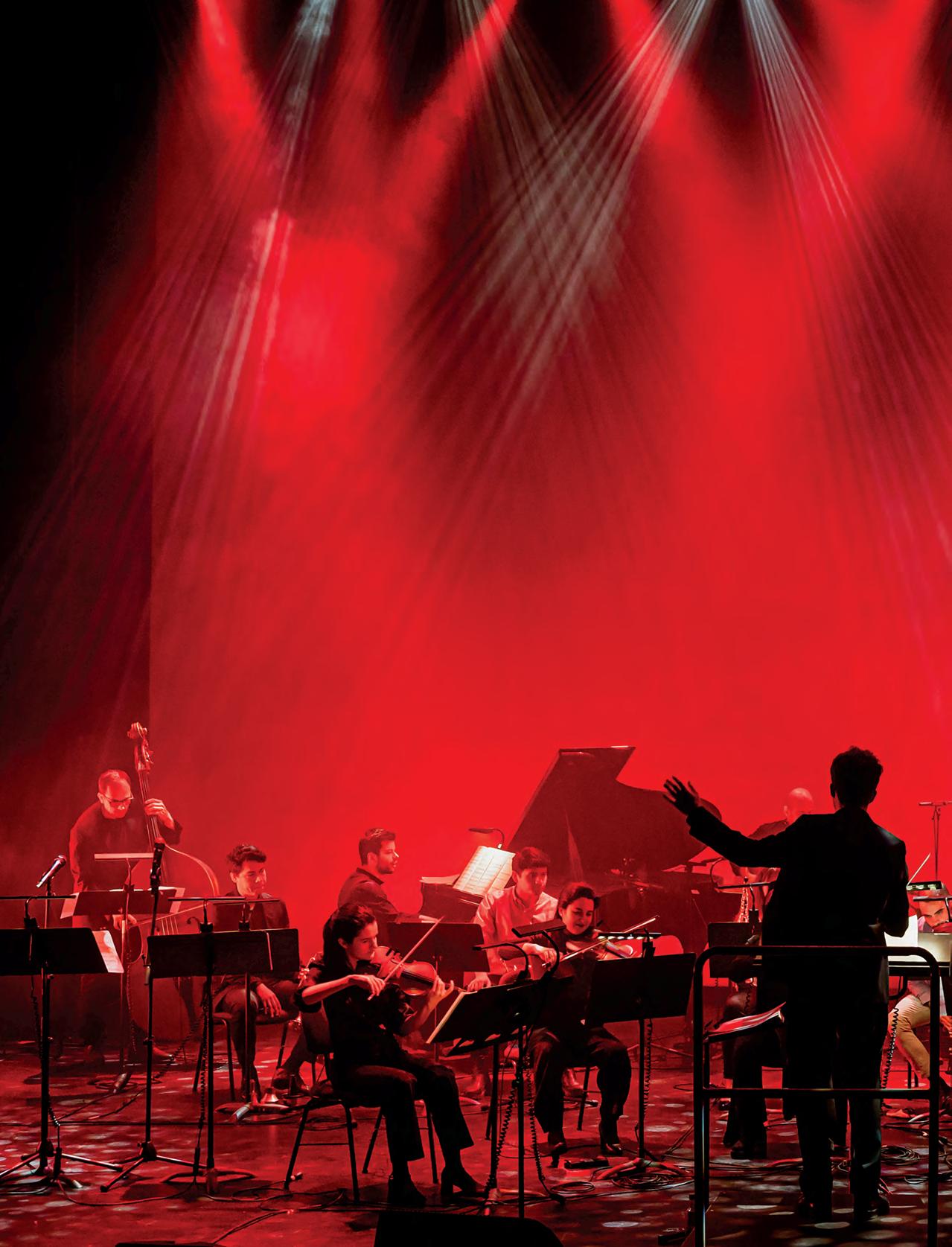
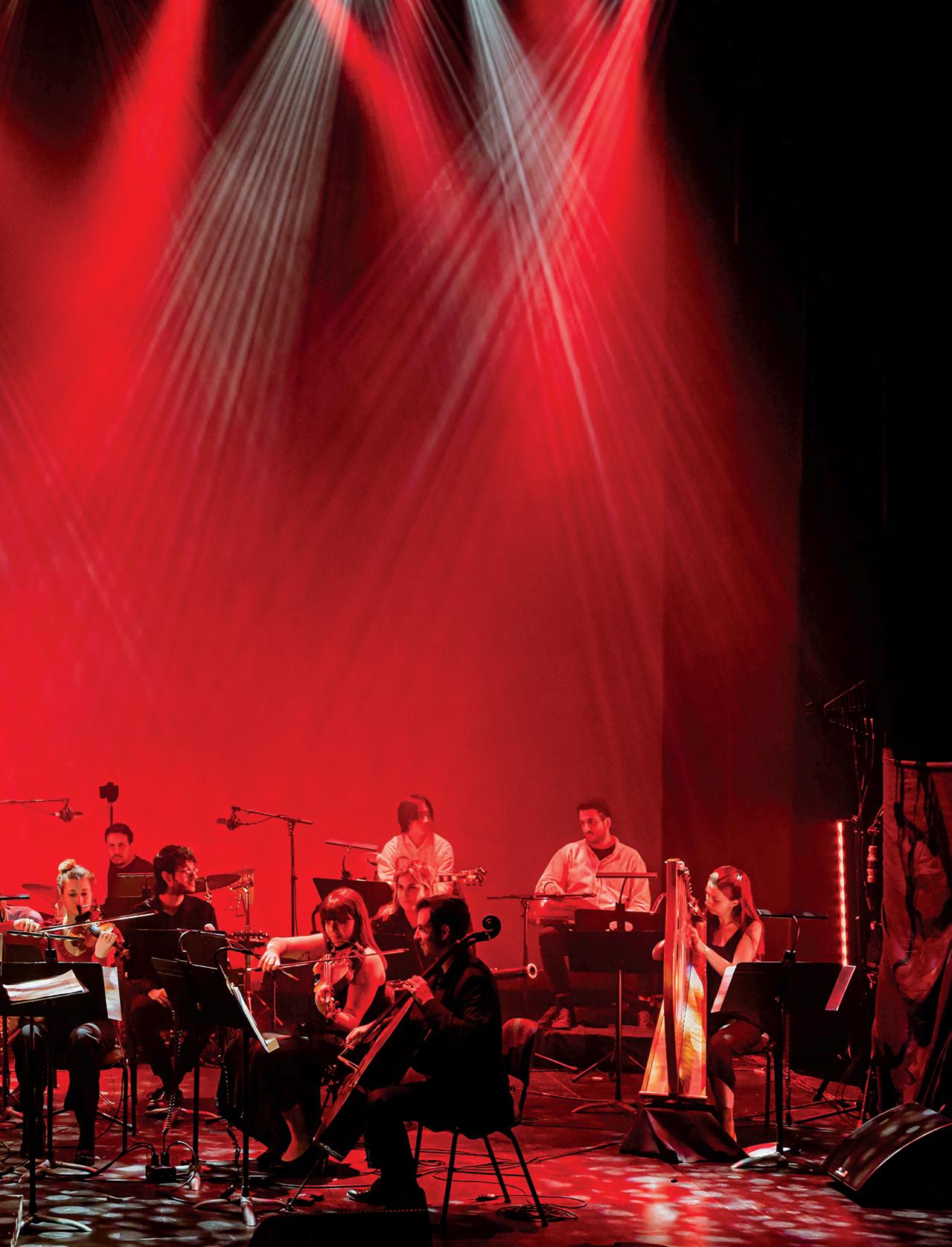
EVENT: De Norte a Sur, de Este a Oeste: Berklee Valencia and Reina Sofía
DATE: Tuesday, February 28, 2023
LOCATION: Teatre Martin i Soler, Palau de les Arts Reina Sofía, Valencia, Spain
DETAILS: NATHAN BIEBER M.M. ’23 conducts a concert featuring students from Berklee Valencia and the Escuela Superior de Música Reina Sofía.
BY KIMBERLY ASHTON
The 30th annual gala celebration benefiting scholarships for City Music students was held on October 21 at the Westin Copley Place and featured celebrity guests Malcolm Jamal-Warner and MC Lyte as well as performances by Eguie Castrillo Salsa Orchestra, Upper Structure, and Liam Purcell & Cane Mill Road, among others.
The event, which had been called the Encore Gala in years past, was renamed Amplify Berklee Gala this year. Organizers say the new name was inspired by the fact that the programs the gala supports amplify creativity and amplify voices of the past through
arts, and that City Music and Berklee grads alike use their skills and talents to amplify the potential for social change, for good in the world, and for the power of community.
City Music, an initiative to provide underserved public school students with music education, serves nearly 2,000 students regionally and more than 62,000 young people nationwide. The program has provided more than $30 million in scholarship support since its inception.
Actor and musician Jamal-Warner emceed the evening, which included a seated dinner followed by the opportunity to explore a series

of music rooms spanning a diverse array of musical styles and cultures reflective of Berklee’s global community. In honor of the 50th anniversary of hip-hop, the evening closed with a DJ dance party spun by MC Lyte, a legendary hip-hop artist and pioneer of female rap.
MC LYTE (LEFT) AND MALCOLM JAMAL-WARNER (RIGHT) WERE THE CELEBRITY GUESTS AT THIS YEAR’S GALA.
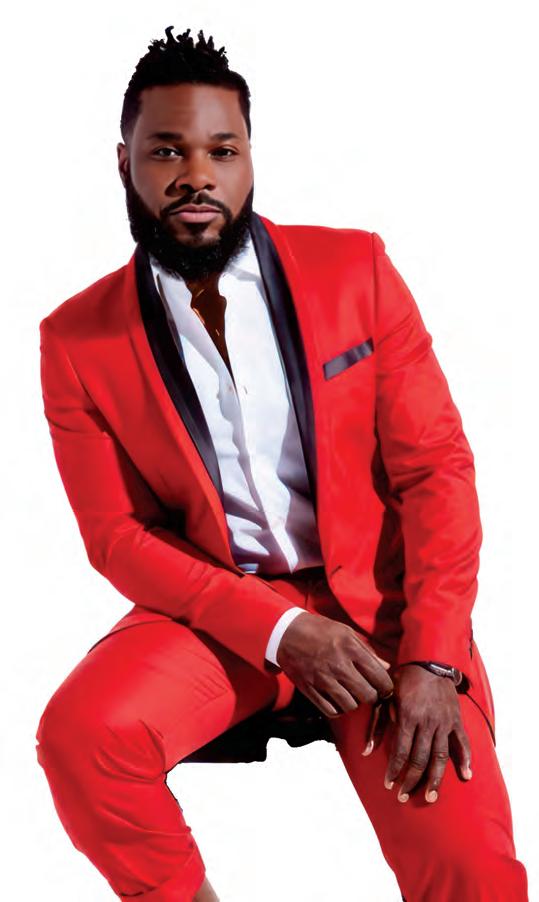


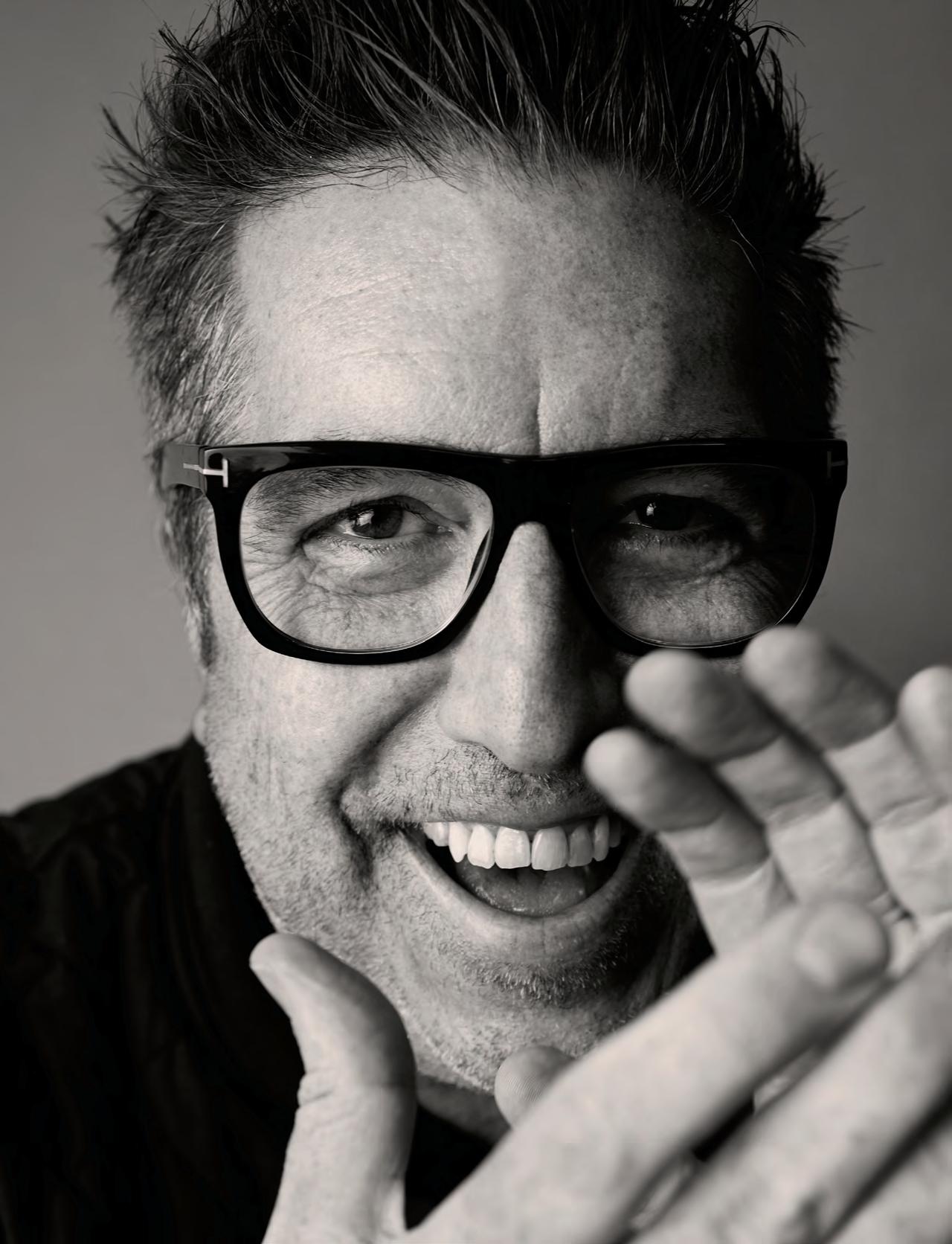
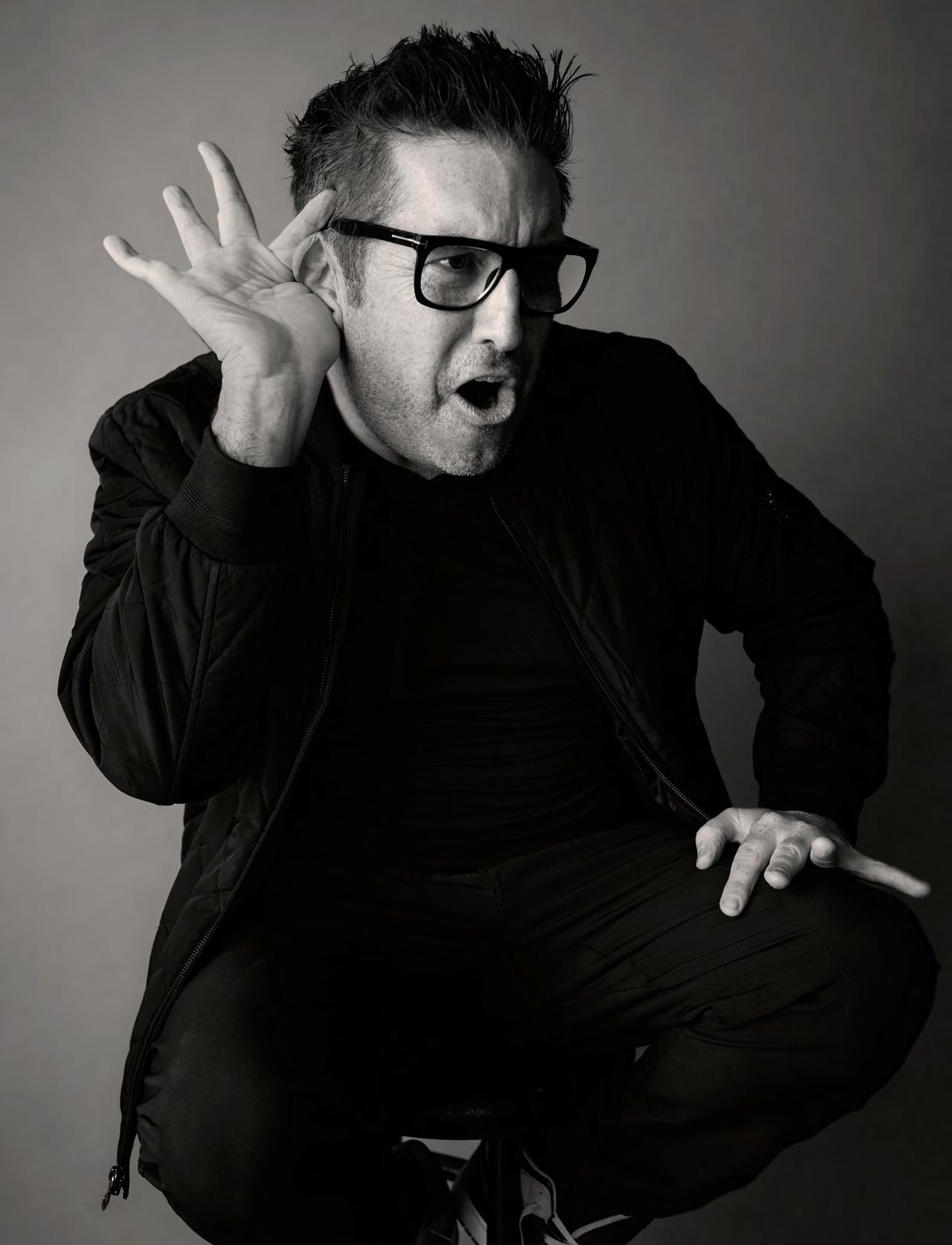
Grammy winner Cheche Alara on how he became a multihyphenate talent, why he doesn’t give career advice, and why musicians shouldn’t forget that they are artists first.
“Christina went from not being a household name to around two, maybe three, months later I had friends of mine calling me from Argentina, going, “Oh, my god! You’re playing with Christina Aguilera?”
When Cheche Alara, a multihyphenate artist who’s worked with everyone from Christina Aguilera to Barbra Streisand, talks to groups of music students, he often asks for a show of hands: “In the last year, while you’ve been at school [who’s heard] the word network?” Everyone’s arm shoots up.
He’ll follow up with a question about the words brand and personal brand. Again, hands fly skyward. Then he’ll drop this question on the crowd: “How many times have you heard the word emotion?” The room grows quiet.
“And I’m like, okay, we have a problem here,” ALARA B.M. ’94 says, but in a tone that’s affable rather than chastising. “Network and brand are very important, but we’re musicians. We’re artists.” For him, the core of what an artist does deals in the realm of feelings, of making people want to cry or to shake their booty. Staying engaged with these emotions, and exploring where they take you, he says, is what’s going to keep a musician growing both personally and professionally.
It’s a philosophy that has led Alara into several roles throughout his career—from keyboardist to arranger to music director to producer to composer—and to remarkable success. He’s won a Grammy, for Best Latin Pop Album (Claudia Brant’s Sincera), and two Latin Grammys, for Best Folk Music Album (Natalia Lafourcade’s Musas Vol. 1 and Musas Vol. 2) and has been nominated for several others. He’s served as music producer and music director for the Grammy Awards Premiere Ceremony several times. Just the highlights of his production, composition, and music directing accomplishments run pages long. Recently, he talked with
Berklee Today about his background and how it prepared him for a serendipitous opportunity that changed his life; his mild allergy to the terms music industry and music business; Latin music and culture in the U.S.; and why he doesn’t think there is “advice that anyone can give to a younger musician when it comes to their career.” What follows is an edited and condensed version of that conversation.
Tell me a little about the environment you grew up in. Did you come from a musical family?
So I come from an artistic family, with the only musical element being my great aunt [who was] a pianist and an amazing teacher. She gave me her piano as a gift when I turned 4. She was my first piano teacher. But as far as the family…my dad is a writer and my mom is a painter. So I grew up surrounded with a lot of artistic life experiences. Not necessarily musical, but music was always part of the house—always, always, always. And Buenos Aires [Argentina] is a city with a lot of culture, so I used to go to jazz concerts, classical concerts with my parents when I was a little kid. My parents have been the biggest, most amazing influences in my life, and [they’ve been] extremely supportive since I was a little kid. And, quote-unquote, “letting me go” when I was 18 to go to another country. Back then it was a big deal, and they faced a lot of real criticism from close friends.... It was a different time and a different culture.
Why did you want to go to Berklee?
[In the late ’80s, early ’90s,] Berklee was doing outreach seminars. GARY BURTON [’62, ’89H]
would go and give weeklong workshops that were amazing. So I enrolled in quite a few of those. The first one that I enrolled with, my mom had to ask for a waiver because I think I was 11 or 12. I remember being in awe of everything. When I finished high school I took one of the seminars and I got a scholarship to go to Berklee. So that was the final push that I needed to say, “That’s it. I’m going.” It was a big deal, and I was equally excited as I was petrified. It was a big, big shock, big cultural shock. It was the first time that I was living away from my city. But, yeah, it was great. The Berklee years are an essential chapter of who I am as a person and as a musician.
How did they shape you as a person?
It was kind of like a connective portal between growing up in one culture and coming to a new one. The biggest thing that I can recall is that I started making deep friendships with people from other countries, mostly Latin America. [We] were all helping each other understand what we were going through, and helping each other figure out all these changes. And it was beautiful. Many friendships that I made in Berklee are still some of my closest friends.
Did you come to Berklee as a keyboardist?
I came as a keyboardist. I had quite a shock when I first got to Berklee by the level of other students. I was, like “Oh, I got this. I’m going to be part of the top of the….”—no, top of the nothing! [Laughs.] It was like, “Oh, my god!” The level was outstanding. So basically I enrolled as a keyboard player, and to my surprise I tested out of most of the core
courses. I was not expecting that at all. I ended up enrolling in what at the time was called commercial arranging [now contemporary writing and production]. And that was great. I graduated in about two years with my major, and then I stayed an extra year doing my own electives. But the performance part I kept doing on my own…I kept doing a lot of playing in ensembles, whether it was for credit or not. But it was basically developing both sides: the performing and the writing, arranging, composing, and producing.
At the time, did you know what you wanted to do professionally?
I don’t think I had a clear idea. I knew that I wanted to do more than play. The way that I have approached my career since the Berklee days is rather than switching directions, I expand into new things. So I still do the things that I started doing, but as the years went by, I added new areas that pique my interest and my passion.
What was your plan right after Berklee?
I was convinced I was going to move to New York. That was my plan. I was taking classes with a couple of people at Julliard. [But the University of Southern California] let me send a demo, and gave me a scholarship. When I moved to L.A...I was pretty much on my own. And I was like, “Okay, what do I do in this big, massive monster of a city?” [Laughs.] But again, [being in school] gives you a structure… and then if you make friends, “Oh, we’ve got plans for the weekend, or we have a couple of gigs,” or they recommend you to do this or that.
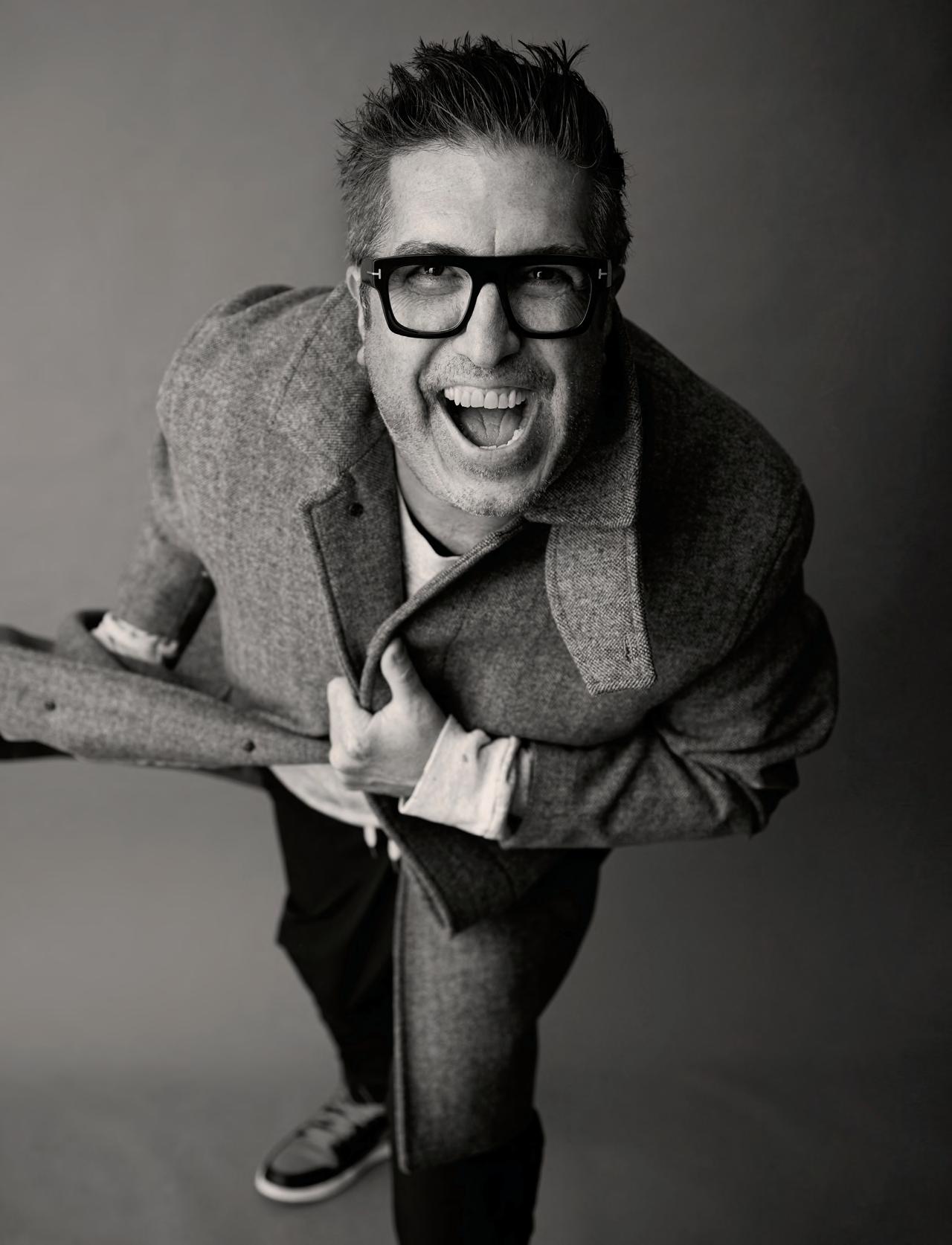
And then you started getting into the industry in L.A.?
Okay, I would love to talk to you about the word industry later on because I have an issue with that. [Laughs.] …So fortunately for me, while I was at USC I was gigging a lot. I played most nights of the week, in completely different, eclectic situations. I was playing at a jazz club called the Baked Potato here in L.A. It’s very, very famous. And someone came after a show and was like, “Hey, we’re putting together a band. We’re holding auditions for a new singer, would you like to play?” At the time I thought it was a Latin artist...“Oh, you know, Aguilera, that’s a Latin last name.” Little did I know she was doing pop, in English! [Laughs.] And I got the audition, and that was a time where it was like a pivot point. It was quite a drastic change that enabled me to, careerwise, make a lot of connections and all that but also to legally be able to stay [in the U.S.] and to build the next chapter, not as a student but as a professional musician. So that was a big deal.
Probably one of my biggest real-world learning experiences, not academic, was to witness how…Christina went from not being a household name to around two, maybe three, months later I had friends of mine calling me from Argentina, going, “Oh, my god! You’re playing with Christina Aguilera?” And it was an amazing learning experience because I had firstrow center seats to witness how something like this happens. I witnessed that with Christina [and with] Destiny’s Child. So I saw Beyoncé going from one of the singers in Destiny’s Child to dear god!
So you started as a
keyboardist with these different artists and then started branching out?
I started as a keyboard player with Christina; I ended up doing assistant musical director duties. I started doing a bunch of arranging. I realized—also early on in my touring years—that I wanted to become a music director, just to be able to put more of a personal stamp on the projects. So, in about three years or so…I basically expanded it into music direction. And I loved it. Still to this day, music directing and conducting is one of the favorite things that I do. It gives you more of a chance to have more of a personal relationship with the artist, to be more involved with the project as a creative. The transitions that I made careerwise are: I started as a keyboard player, I became an arranger at Berklee…then I toured as a keyboard player, also utilizing the arranging skills that I had, and then I became a music director. And then I expanded into album production. And then I expanded into composing for both album production and for media, for film and TV. And it’s been always, again, expanding, not stopping.
Yeah, there are a few people I can think of who’ve worked in so many aspects of…and I do want to talk about the word industry.
You know, whenever I do a master class or a talk with students—we have gotten so used to referring to the music industry. And we talk about industry and the industry…. I look at what we do as a chain of things, and each link is preciously important, because without it the chain breaks, right? A link is your training, your formative
“It’s so important that we make people aware that we are artists. We deal with emotion. We deal with feelings.”
years, personality, awareness of what you want to do with your life and everything professionally. I think one of the links of what we do as musicians, and professional people that make a living through music, is 100 percent a business. But it’s just one of the links. You need to be very aware of that link, because without that link you don’t have a chain and you’re in deep trouble, but it does not define what we do. I’m very, very, very passionate about that because I think it’s so important that we make people aware that we are artists. We deal with emotion. We deal with feelings.
Do you see this awareness missing in some musicians?
A lot. And there’s an issue with that because we are having people go through life as artists and not necessarily being aware of that. And that’s a shame. I talk to a lot of young people who are like, “Oh, you know, I want to look at my brand, build my following, build up my business, work out these deals.” And it’s like, “Sure. And I applaud you for that, but you have to remind yourself that at the core of that is art. Because, if not, what are you doing?”
To me, it’s like a yin-yang thing. If you make that aspect of things more important than the craft…then it’s not yin-yang, then it falls apart. As musicians, in particular, I don’t think this yin-yang has been properly presented for many, many, many generations. So you have one of the parts overtaking the other. So technique, technology, network, branding, blah blah blah. Yeah, great. You can go through life that way. And it’s gonna be okay. It’s just kind of like you’re missing out on the root. And interesting enough, I think that it happens to musicians way more
than to other types of artists. It is very common to find musicians that are extremely skilled, successful—people that we look up to as musicians—that have very little or no knowledge about other artistic disciplines. There are a lot of amazing musicians [to whom] you’ll mention something about theater, literature, ballet, paintings, and they’re clueless. [But] most people that do sculpture, for example, will probably have a really, really advanced knowledge of music.
So what do you do to feed your inner artist, outside of music?
I love cinema. I love reading. It doesn’t happen that often, but when I travel I try to plan my trips to find as much time off as possible within the trip. I’ll find out, okay, there is this museum, there is this part of town that has all these different things that I don’t get to see in my daily life, and I go for that. Down to something that can be superficial but it’s also not, something like food. So my traveling becomes an enriching experience usually, besides what I’m doing. I was in Mexico City with Natalia [Lafourcade] last week, and we started working at noon. Every morning, I would wake up early and go walk. …I want to experience, like, what do people do in Mexico City at 8:00 in the morning? How does that feel?
I wanted to ask about your experiences as music producer, music director, and arranger over the past seven years for the Grammy Awards Premiere Ceremony, the live show where most of the Grammys are handed out.
The [Recording] Academy and the Latin [Recording] Academy
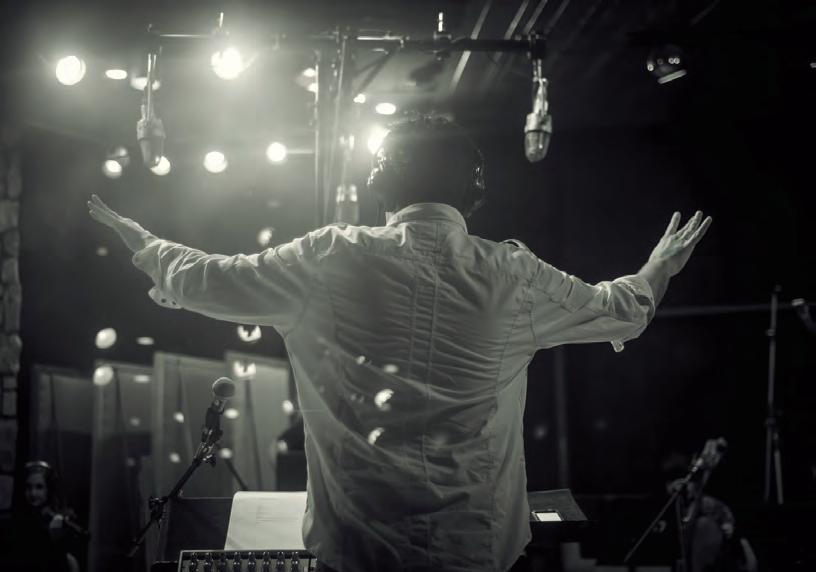
have been places where I’ve been given the opportunity to raise the bar and to do things in wonderful ways.
I’ve done a lot of music direction and conducting of shows and big award shows and everything. By far—by far—the most complicated show is the Grammy Premiere. Nothing comes even close. We play about a hundred songs, 100 percent live, in every single style of music that you can imagine. We play everything from straight-ahead jazz to hip-hop to Latin, classical, country, gospel, blues, everything. There are no backup tracks, and everything is backto-back. …It’s like the Super Bowl of live music events.
As someone who’s part of the Latin and the Englishspeaking musical worlds, what do you make of the rise of Latin music in the U.S.?
Basically, like with anything else in life, you have to look at history to probably find out a lot of what’s going on right now has happened before. But with Latin music there were cycles—or waves, if you will—in which Latin music became more popular and more mainstream throughout the decades. Back in the day, we would have things like Santana, TITO PUENTE [’95H] . Later on, you had things like GLORIA
, Miami Sound Machine. In the early 2000s, there was a pretty big Latin crossover, “Latin explosion” as they call it, with Marc Anthony, JLo, Ricky Martin, where you would see all these Latin artists in mainstream media. That went away for a second, and then this current wave started building exponentially fast and big. And I think it ’s fantastic. I think it’s great to have cross-cultural growth, whether it’s Latin music, or whether it’s K-pop, or whether it’s African pop.
It does seem that Latin music, though, has a special place in the U.S., because the Latin population here is so important and we have such a connection with Latin America.
I agree. And that is a beautiful thing, because in many other aspects the Latin population in the U.S. is not properly represented and is closer to being invisible. ...The amount of very hard work—farming, service industry—that is performed by Latin people that I see on a daily basis. Yet that isn’t properly represented as far as politics, social construction of the daily life, movies. It’s almost like there’s a whole layer of our society that is there yet we don’t talk about it. So I’m happy that music
has given more of a voice and a presence to the Latin community, because...as an American society, we need to recognize how vital it is.
So music can act as a portal through which the wider U.S. community connects with the Latin community here?
Exactly. Last year I produced Karol G’s segment at Coachella… and it was like thousands of people singing in Spanish. And I was like, “This is something, this is different. What is it and what do we do with it?” I hope that we seize the opportunity—I’m not just talking as a Latin person but as an American citizen—I hope that we seize this opportunity to make it count for something else than money and record streaming on Spotify.
You’ve had such an eclectic career. What advice would you give to musicians who are developing their careers?
You just asked one of my two favorite questions that you can get asked in an interview. I’m going to give you my very sincere answer: I don’t think there is music advice. I don’t think there is advice that anyone can give to a younger musician when it comes to their career. I think anyone that gives advice is probably
coming from a good place, but I don’t think they’re giving you anything that is going to be useful for you in particular. The reason is there’s so many paths. I always tell people, “You can finish Berklee, be at the top of your class, be a fantastic musician, move to New York, and within a week you’re going to land the best project and be successful for the rest of your life. Or you can move to New York, again, being at the top of your skills and really good, be there for five years, and nothing happens.” There’s so many variables. You could meet the right person right away. You could meet the wrong person six months from now. There’s not a clear path to what we do. So I think the only thing that you can do is to keep yourself on this internal journey that’s going to carry you through your life as a person, as a musician, and as a professional musician. Those you can try your best to control. The rest, you know…
What’s your other favorite interview question?
The other question has to do with gear. When people go, like, “Hey, tell us, what kind of gear do you use?” I’m like, “Okay, stop right there. It’s not about the gear.” What we do has very little to do with gear. It’s about how you use it. You can have the world’s worst computer and crappiest keyboard and make the most amazing music. And particularly when you talk to people that are in other parts of the world…this advice about gear is really harmful because people don’t have the money. So it’s not about that. It’s about, hey, try to get a hold of any gear that you can get a hold of and get to know it well. And then it’s going to be what it’s truly about: the music, the art.

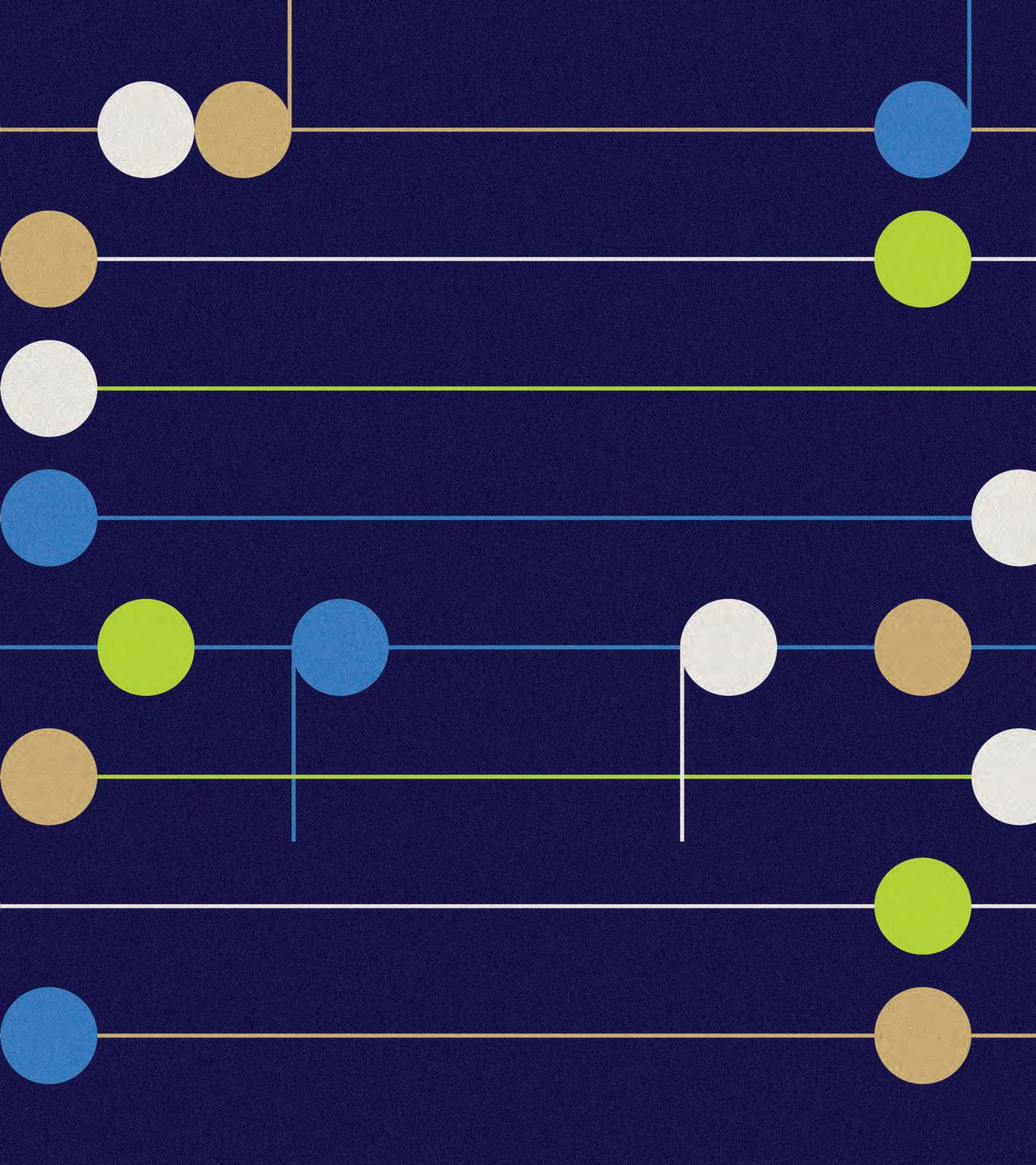
Berklee professors and alumni consider the brave new world of music in the age of AI
STORY BY Michael Blanding
A few months ago, Associate Professor BEN CAMP, who teaches in Berklee’s Songwriting Department, was working with a recent graduate on a tricky lyric for a new album. She wanted to convey the sense that she could create magic, and to urge listeners to get in touch with their own inner powers instead of being afraid of them, recalls Camp (they/them). “And the context for this line was like the mood of the witches that open Macbeth.” Later, Camp sent her a potential lyric: “In the witching hour’s hold / Do you hear the stories told? / Do you fear the magic yet to unfold?”
“I read it to her and she loved it,” says Camp, who says she only changed one word—“unfold” to “unfurl.” Camp then revealed that they actually hadn’t come up with the line—it was generated by ChatGPT, the large language model trained by arti-
ficial intelligence (AI). “She was like, ‘Oh my God, I hate you,’” Camp says, chuckling.
The anecdote captures the ambivalence songwriters and musicians are feeling about artificial intelligence, says Camp, who has begun introducing ChatGPT and other AI tools into their classes. “I’ve gotten everything from ‘I need to go home and throw out my computer,’ to ‘It’s okay, but it doesn’t have the spirit and soul a human has,’ to ‘Thank you for making me use AI. I did a way better job than I would have without it.’”
As generative AI and machine learning get better and better at mimicking human creativity—and at making original music—the technologies have been greeted by musicians and music fans alike with mixed emotions, including a healthy dose of fear. This spring, when an anonymous composer released the song “Heart on My Sleeve,” claiming they used AI to generate passable versions of the voices of Drake and the Weeknd, the so-called “Fake Drake” alarmed musicians everywhere, who feared that their talents could simply be ripped off.
It was the second time in a matter of months that AI had crossed the line into what had been exclusively the territory of musicians and songwriters. In February, DJ David Guetta cre-
ASSOCIATE PROFESSOR BEN CAMP (THIS PAGE); ASSISTANT PROFESSOR MARK SIMOS (OPPPOSITE PAGE)
ated a song using AI to generate lyrics along with the voice of Eminem. Getting ahead of the trend, in April Grimes gamely told creators they could freely use her voice in compositions “without penalty.” (That’s easy enough when you’re a multimillion-dollar artist who has children with the richest man in the world.) So far, such experiments seem little more than musical pranks. But as the technology continues to improve, it’s quickly forcing musicians and songwriters, including Berklee faculty and alumni, to grapple with its implications.
“These are still early days,” says JONATHAN BAILEY ’08, former chief technology officer of iZotope, a company using machine learning in part to create software for recording, mixing, and mastering music. “But there are a number of startups right now in an arms race to productize AI technology for music that we’ll start to see in six months to a year.” One of iZotope’s big breakthroughs was using AI to remove background noise from an audio recording—a feat that is normally hard to do.
“Separating out the speech content from noise is really dif-
ficult, but it’s actually a pretty easy problem to solve using deep learning,” Bailey says. The same principles that can label sounds as speech or noise are now being applied to identify drums, guitars, and other instruments—and will eventually be able to generate those sounds, Bailey says.
“If you’re a singer-songwriter, you can record your voice and guitar in your bedroom and then automatically enhance the quality to sound like you recorded it in a professional studio. Then what if you could add a bass track and drums to that? Right now, it seems in the realm of fantasy, but this could become more and more possible.”
In a sense, such technologies are an extension of the democratization of music recording, continuing the trend of software such as GarageBand or Autotune that have made advanced tools more accessible to amateur musicians. “It used to cost a million dollars to create an album, then $10,000, and now $1,000,” Bailey says. “To me, generative AI is just a point on that curve, the next evolution of enabling more people to be creative.”
That democratizing trend in AI doesn’t bother MARK SIMOS, an assistant professor in Berklee’s Songwriting Department. “It’s part of a whole progression of technologies to help nonskilled
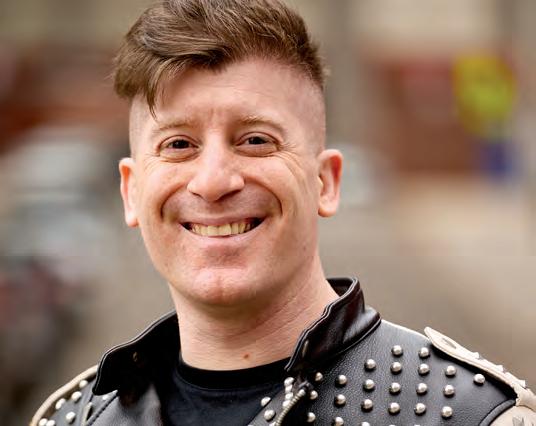
“These are still early days, but there are a number of startups right now in an arms race to productize AI technology for music that we’ll start to see in six months to a year.”
JONATHAN BAILEY ’08
FORMER
IZOTOPE
CHIEF TECHNOLOGY OFFICER
musicians to be able to write songs,” he says. “That’s not likely to fundamentally change the nature of the industry.” On the other hand, he does see a danger in professional musicians using AI to generate songs out of whole cloth.
Decades ago, Simos worked in software with expert systems, a precursor to AI. More recently, he’s judged several AI songwriting contests, and has noticed a disturbing trend of musicians using AI as a shortcut to creativity. “When you ask ChatGPT to spit out a song on a certain topic in a certain study, that’s not how real songwriting works,” Simos says. “Much of real songwriting is nonlinear; it’s not just reaching into some oracular space in your head and out pops the song.”
What AI can’t replicate—at least not yet—is the combination of music and lyrics that makes a song truly great. “You see a lot of people saying, ‘We used this technology to generate lyrics, and this technology to generate a melody, and then kind of slapped it together,’” Simos says. “But the slapping it together part is where the magic really happens.”
In songwriting classes, he says, faculty place a lot of emphasis on something called prosody. “It’s the way that all of the different parts of the song are
telling the same story and communicating the same emotional truth,” Simos says. “That hasn’t been the focus of any of the AI songwriting research I’ve seen, but that’s the kind of stuff real songwriters and the people who teach real songwriters wrestle with.”
Simos worries that the increasing prevalence of AI music may degrade the quality of music as a whole. “You throw enough of that into the industry, and eventually you start eroding people’s ability to tell the difference.” He’s working on a project now to adapt his 2014 book Songwriting Strategies: A 360-Degree Approach for writing with AI, in order to help songwriters more realistically understand what the technology can and can’t do, and to suggest ways that AI may help the songwriting process without dumbing it down.
That’s the approach that his colleague Ben Camp has taken as well: intentionally introducing ChatGPT and other AI technology into his courses so students can learn to use them as tools rather than seeing them as threats. “There is a lot of fear that AI is going to take our jobs—but at least in its current form, AI is not self-directed, so it’s not going to do anything other than what a human tells it to,” Camp says. “It’s really important to me to make sure that my stu-
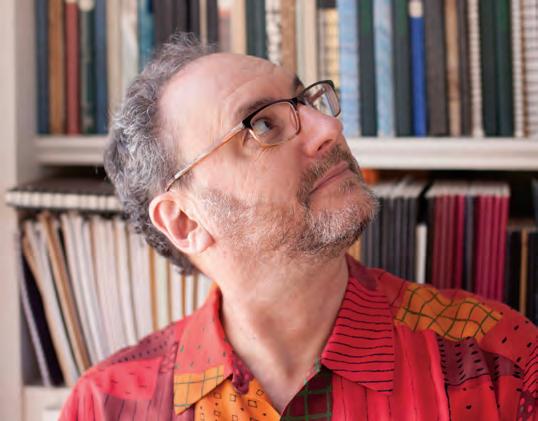
dents become the humans who have those skills to know how to talk to AI and get those jobs.”
At this point, Camp finds AI most helpful in the brainstorming phase of musical composition. “I think creatives of all fields are familiar with the problem where you’ve got like 80 percent of it figured out but there’s this one thing that stumps you,” they say. Maybe it’s a lyric that needs to rhyme with one you already have, or one that possesses a certain number of syllables while expressing a complicated emotional sentiment. That’s when Camp will turn to a large language model such as ChatGPT, which works by generating random variations on statistical prompts. “I’ll say, ‘Give me 20 options for this line,’” Camp says. “And if they all end up sounding the same, I’ll then say, ‘Give me 20 more options that have nothing to do with each other, to make them as diverse and strange and unexpected as possible.’”
Oftentimes, they say, that’s enough to get their creative juices flowing. “I’ll see something I never would have thought to come up with in a million years—and that’s not quite it, but it leads me to a solution.” As
for the ethics of using a computer to help compose a song, Camp sees it as no different from the way musicians for centuries have looked to other songs for inspiration. “All of music is a history of chained thoughts and expressions leading up to where we are now,” Camp says. “The entire methodology of teaching music is to play a song, analyze it to see why it does the thing it does, and then be able to do that thing.”
Nevertheless, there is a gray area when it comes to credit. “It’s hard to know when it’s the artist’s duty to disclose,” Camp says, adding that they will probably note ChatGPT’s contribution to the lyrics for the song composed with their student.
As much as they are excited about the potential of AI technology for songwriting assistance, Camp worries, as Simos does, about the potential of AI to generate whole songs, especially when this capability is paired with a streaming service such as Spotify, which has the ability to use machine learning to curate a feed of customized music for listeners.
“Algorithms are getting so good they create a very specific funnel that can become a bit of an echo chamber,” Camp says. Taken to extremes, that kind of individualized music generation could deprive us of the commu-
“When the drum machine emerged in the ’80s, people said we won’t need drummers. But drummers were able to manipulate this new technology, and together with the sampler it arguably created hip-hop.”
PROFESSOR GEORGE HOWARD BERKLEE’S MUSIC BUSINESS/MANAGEMENT DEPARTMENT
nal aspect that fosters connections among people who listen to music together. “Have you ever been to a concert where the entire crowd is singing songs back as one?” they say. “I shudder to think of a world in which everybody has their own songs, and the crowd couldn’t chant together the end of ‘Hey Jude’ for minutes on end.”
That potential for personally generated music also worries GEORGE HOWARD , a professor in Berklee’s Music Business/Management Department. But his concern lies mostly with AI’s commercial implications. Cofounder of the media investment and advising company Acme Innovation, Howard has long worked to create technologies that give musicians and songwriters more control over their own music; these include blockchain technology that accurately and effectively tracks when and how songs are being used so that creators can be properly compensated.
For more than a decade, Howard has criticized music streaming services for the downward pressure they’ve put on payments to artists. “They’re making the end-user customer feel
that music should be free,” he says. “I see it every semester with my students, how very few of them have any expectation of making any type of money from Spotify—and very few do.”
Meanwhile, Spotify and other services have curated playlists to the extent that listeners barely even know what artist they are listening to. “[Streaming services] would rather have users searching for playlists of music to cook to, to relax to, to have sex to, or whatever,” Howard says. “As AI-generated music becomes—while not necessarily equal to human-made music— sufficient, in certain cases, we can’t be putting our heads in the sand.”
The issue, he says, is not so much that AI-generated music can mimic established artists such as Drake or Eminem—it’s that the massive datasets of music AI uses to train its generative models are entirely composed of music that people created and own. Existing copyright law, says Howard, is clear that you are not allowed to create music based on someone else’s song. “That’s known as a derivative work, and the copyright code stipulates you can’t do that,” says Howard, who is trained as a copyright attorney. “You have to get permission from the original owner.”
As AI scrapes the internet for songs to use in its training mod-
PROFESSOR GEORGE HOWARD (RIGHT); JON SABILLÓN M.A. ’18 (OPPOSITE)
els, he says, it is “infringing like crazy.” The question is how to stop it. Since the training models are virtual black boxes, it’s very difficult for an individual artist to know when generative AI technology is using their work, and how. Howard predicts that eventually there will be massive class-action lawsuits trying to get compensation for artists and labels. “Some plaintiff’s attorney will find someone who can say, ‘Yeah, my music’s in it and I didn’t give them authorization,’ and they’ll build a lawsuit out of that.”
The problem, of course, is that such a lawsuit will take time to wend its way through the courts, and an outcome favorable to human creators and owners isn’t guaranteed. In Howard’s assessment, it would be more effective to pursue an entrepreneurial approach to the problem. He’s working on a company that would proactively license music that could then be used to train an AI model. Using blockchain technology, it would then be possible to tell exactly how much the model relied on particular songs to generate its music, enabling compensation for the original artists who created the works.
But so far, Howard has struggled to get people in the industry to focus on the issue. “I’m pretty much alone in the entrepreneurial world in building this, and I’m
competing against people who don’t care about it at all,” he says. “I’m putting my own money and time into it, because it feels very desperate and dire to me.”
Whatever happens with the music industry, it’s clear that AI will inevitably alter it, and in ways that may not even be clear at present. Other industries have faced threats from technology that have transformed their trajectories. “Photography was supposed to kill painting, but it allowed painting to become something different, more abstract and impressionistic,” says Bailey. Camp notes that “[computer-generated imagery] scared animators, but it led to Pixar.”
Even in the music industry, technology has spawned new opportunities. “When the drum machine emerged in the ’80s, people said we won’t need drummers,” says Howard. “But drummers were able to manipulate this new technology, and together with the sampler it arguably created hip-hop. Technology is generally sort of agnostic—it’s really the intent that goes into it that determines how it will be used.” As AI continues to make its presence felt in the music industry, that intent is everything—determining how music will respond to this new technology, and what we all will be listening to in the years to come.
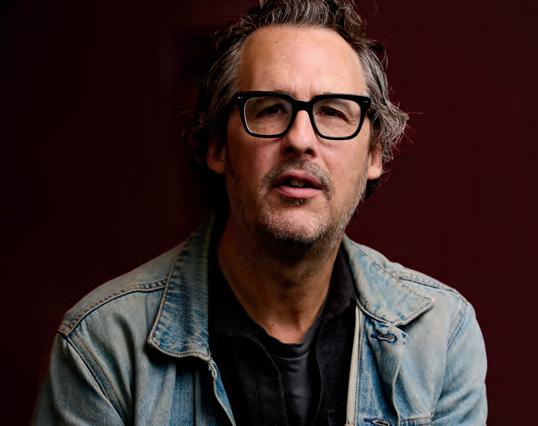
If you go to the website for JON SABILLÓN ’s record label, Aigg, you probably won’t be able to listen to any of the music. That’s because the site is protected by a “reverse captcha” requiring visitors to prove that they are not human to enter. “My thesis at Berklee was to create the world’s first music label for robots,” says SABILLÓN M.A. ’18 , who graduated from Berklee’s campus in Valencia, Spain, with a master’s degree in global entertainment and music business. “Machines make the music—and are also the audience.”
In part a thought experiment to explore the boundaries of artificially generated music, the label might be ahead of its time. Sabillón figures if robots are going to become more prevalent in the future, they should have a way to entertain themselves. “I think that there will be a degree of nonhuman culture that is perpetuated in the future, and I can’t imagine them not becoming conscious,” he says. “To that end, there should be something servicing these new entities.”
He admits that his venture is often greeted with fear by his human colleagues—especially his fellow musicians—but he hopes to help people ultimately overcome that emotion. “Humans have never been the only ones to make music,” he says, noting that birds and other animals have long played their own melodies and beats—and robots should be no different.
In 2019, the label created its first AI artist, Rey1, which Sabillón guided as it created its own unique form of music, including a futuristic-sounding synthesized string composition called “Theophany.” The artist even performed in its own online show last year. “When people actually experience it, they are amazed,” he says. “They can’t believe a nonhuman made it—they are like, ‘I thought this was years off.’” Admittedly, not all of Rey1’s songs are hits. “I would not consider 90 percent of them
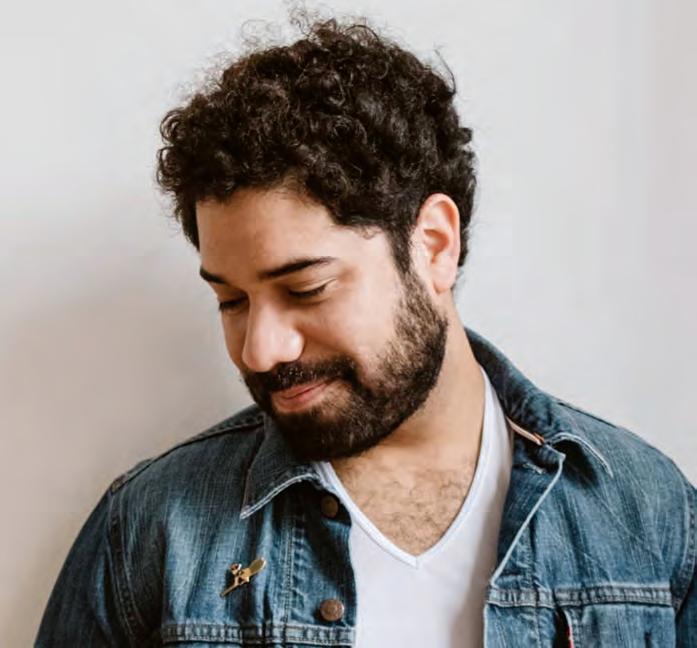
commercial-ready,” Sabillón says. But you could say the same thing about the Beatles or Rihanna, he adds. We only hear the polished compositions of our favorite artists, not their failed ideas.
As for the threat that AI presents to human performers, Sabillón takes the radical view that AI models don’t owe anything to the humans whose works it uses to generate music. After all, everyone is influenced by someone. “Say you learned to play the piano by only listening to Elton John,” he says. “You buy all his songbooks and learn all his songs, and then you make original music that is obviously influenced by Elton John. If you want to pay him, sure—but you owe him nothing.” Robots, Sabillón argues,
shouldn’t be treated by different rules.
Fear of an AI music takeover is driven by economic concerns, and probably rightly so, he says. “People will lose their jobs because of this. It’s just inevitable.” And it’s probably only a matter of time, he says, before AI can create music as well as humans can. “Ultimately, your sense of why you’re making music has to go beyond skill or wanting to make a living,” Sabillón says. “This might sound overly poetic, but for me and many of the people I went to Berklee with, making music has to do with a communion with the eternal, something at its core that is ineffable and difficult to talk about, but it’s why we are moved by music and why we do it.”
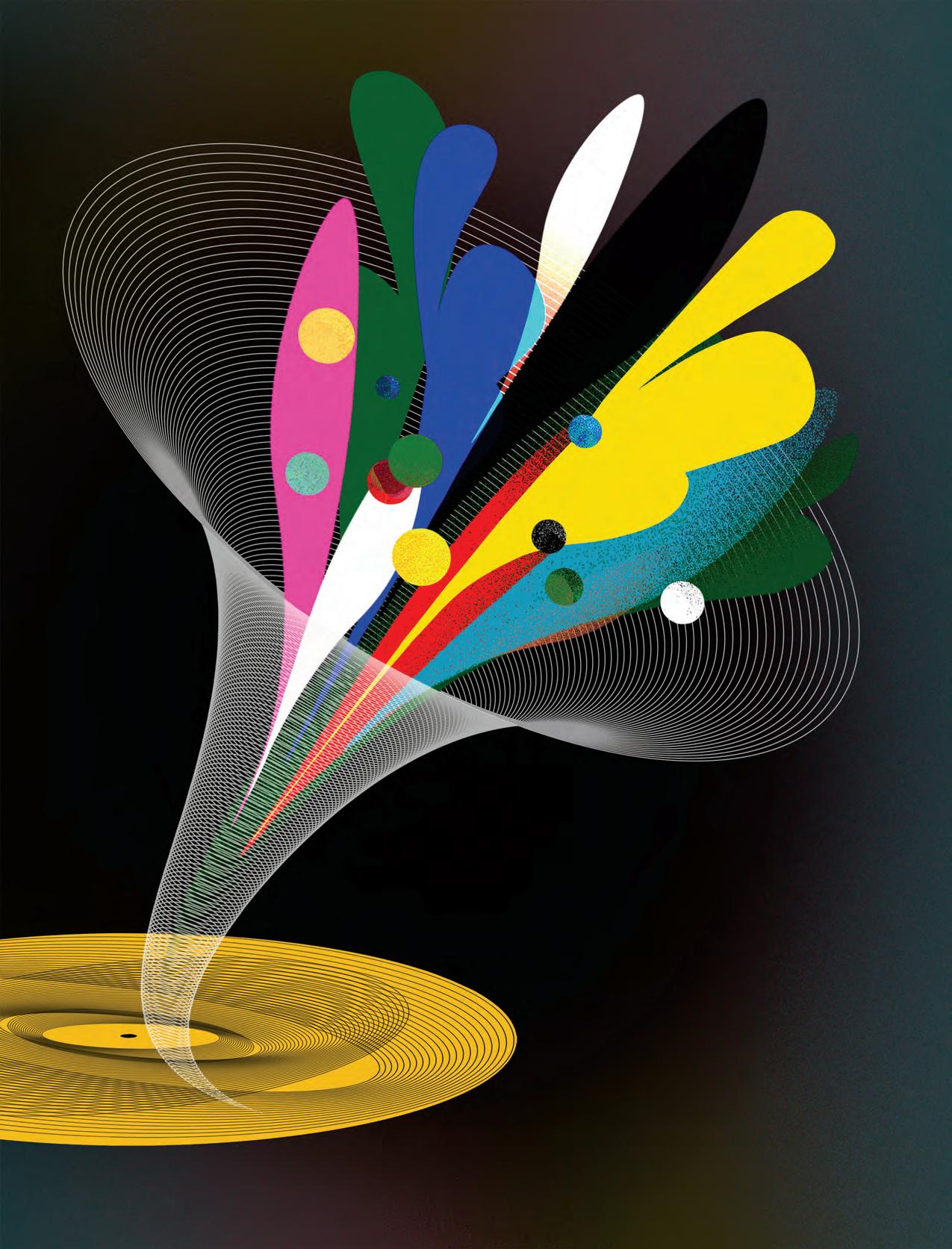
The Latin Grammy Cultural Foundation, along with prominent artists, has awarded Berklee students more than $5 million in scholarships since 2015.
tzel Reyna’s obsession with jazz started suddenly. She was 16 and had no background in music when she went to see a documentary about the genre. What she heard in that Mexico City movie theater sounded to her like freedom.
“Jazz was really like a revelation,” REYNA B.M. ’19 , now 30, says. She went home and told her family she needed a saxophone. “My family was like, ‘But…really?’ It was like out of nowhere,” Reyna recalls.
What followed over the years was an intense dedication to the instrument—one that led her to getting an associate degree in Mexico, to attending Berklee’s

Five-Week summer program, and to eventually landing the first Latin Grammy Cultural Foundation Prodigy Scholarship, the Enrique Iglesias Scholarship.
Established in 2015, the $200,000 scholarship covers a student’s tuition and room and board for all four years at Berklee and is cosponsored by the Latin Grammy Cultural Foundation and a prominent
Latin artist. The artists change each year and have included Iglesias; JUAN LUIS GUERRA ’82, ’09H; Miguel Bosé; Carlos Vives; EMILIO and GLORIA ESTEFAN ’07H; JULIO IGLESIAS ’15H; Juanes; and Sofia Carson.
The 2023 Prodigy Scholarship, which was awarded in Miami in August to Dominican pianist LEOMAR CORDERO CASTRO, was sponsored by Puerto Rican reggaeton star Nicky Jam.
During the Miami award event, a video was played of the Zoom call notifying the Cordero family that Leomar, 20, had won the award. The call started with a split screen showing NANNETTE VÉLEZ B.M. ’06 , the foundation’s senior director of programs; Raquel Egusquiza, its executive director; and Cordero.
“We have a member of the committee who’s going to join the call now to ask you a question,” Vélez told Cordero. At that moment, Nicky Jam appeared to share the news. Cordero and his father, seated next to him, broke out in smiles and hugged. Nicky Jam, whose mother hails from the Dominican Republic, said it fills him with pride that a Dominican will attend one of the best colleges in the world. He also joined Cordero and past scholarship recipients on stage in Miami.
On the Zoom call, Cordero thanked him for the award and for “motivating not only me but also a large number of young people who are passionate about Latin music and our culture.” In doing so, he underlined the mission of the Latin Grammy Cultural Foundation, which was created by the Latin Recording Academy to further awareness and appreciation of Latin music’s contributions to world music and to provide educational opportunities that advance Latin music and its heritage.
A large chunk of those educational opportunities are realized at Berklee. Of the $9.3 million in scholarships and other aid the foundation has awarded since its inception, about $5 million has gone to Berklee students. The Prodigy Scholarship is the largest of the annual awards but the foundation also gives out 43 other scholarships each year: three worth $100,000 each and 40 at $10,000 apiece. The vast majority of students who receive these awards attend Berklee.
To be eligible for the Prodigy Scholarship, a student must have been accepted to Berklee, be between the ages of 17 to 25, have financial need, and have a passion for Latin music. Applicants do not need to be Hispanic or Latin, and they can be from any country.
A committee of accomplished musicians around the world reviews roughly 1,000 applications each year and flags a few candidates for the top award. Of the candidates who have the highest scores, the sponsoring artist chooses which one will receive the Prodigy award, taking into consideration the applicant’s musicality, technique, tone, rhythm, musicianship, originality, and overall performance.
Berklee’s collaboration with the foundation goes back to the foundation’s beginnings, when the college helped it establish a process to identify talent, merit, potential, and need. The foundation was also able to look at Berklee’s structure for educational outreach and programming as a blueprint for how to build a multinational network that serves as many promising students as possible.
The shared goal of Berklee and the Latin Grammy Cultural Foundation is to create more accessible pathways to educa-
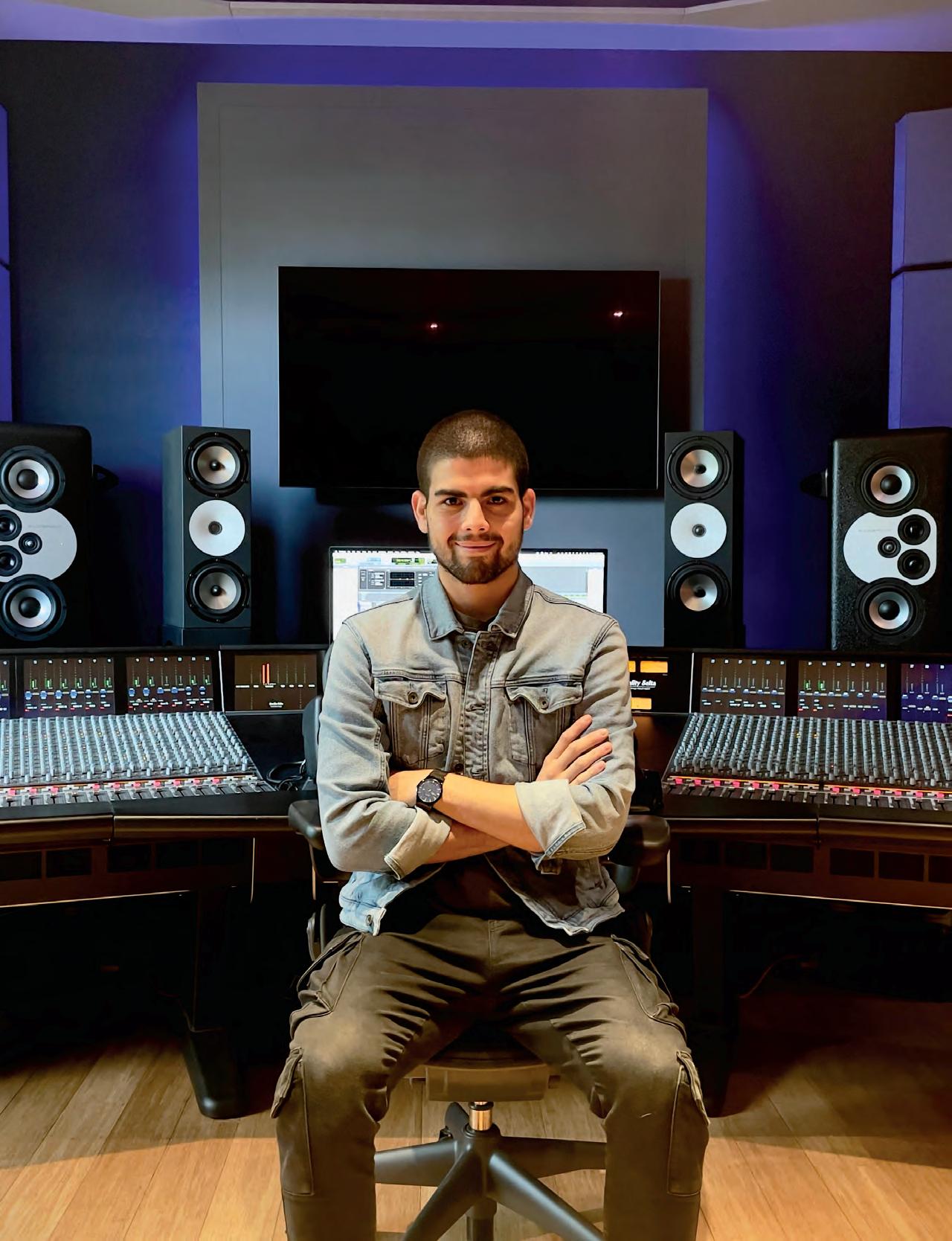
tion and to career opportunities, says JASON CAMELIO, Berklee’s assistant vice president of Global Initiatives. The scholarship program is part of that collaboration, but other programs to expand access are also being developed, he says.
Meanwhile, the foundation recently announced two new initiatives. One, the Leading Ladies of Entertainment Connect Together Mentorship program, was established to mentor women interested in careers in the music industry. Another is the Latin Grammy Cultural Foundation Scholarship Alumni Network, in which scholarship recipients can share their expertise with each other, mentor current students, network with industry pros, and gain access to exclusive events and resources.
The alumni network’s members, and those eligible for membership, are a testament to the success of the foundation’s efforts over the years. For example, there’s Venezuelan music engineer and Grammy nominee ALEXIS SOTO B.M. ’19, who won Tuition Assistance Scholarships from 2016 to 2018 and who now works in Miami as the chief technology officer at acoustic design and consulting company LAB Acoustics and does consulting work for tech company iZotope. And there’s ESMIRNA ORTIZ B.M. ’17 , who won Tuition Assistance Scholarships from 2015 to 2017 and became the first Dominican woman to work as a professional sound engineer. Or there’s Colombian saxophonist JESÚS MOLINA ’20 , who won the Juan Luis Guerra Prodigy Scholarship in 2016 and who has a flourishing career on the international jazz scene.
Reyna, the saxophonist from Mexico City, says she plans to join the alumni network. Meanwhile, she’s continuing to grow
her career by teaching adults and children, mostly online; working as a session musician; collaborating with visual artists on nft (nonfungible token) projects; and preparing her ep for a January release. She’s also looking into getting an artist visa to come back to the U.S. and establish herself as a jazz performer, a career that had seemed unthinkable to her all those years ago in a Mexico City movie theater.
“Jazz was really like a revelation... It was like out of nowhere.”
ITZEL REYNA B.M. ’19
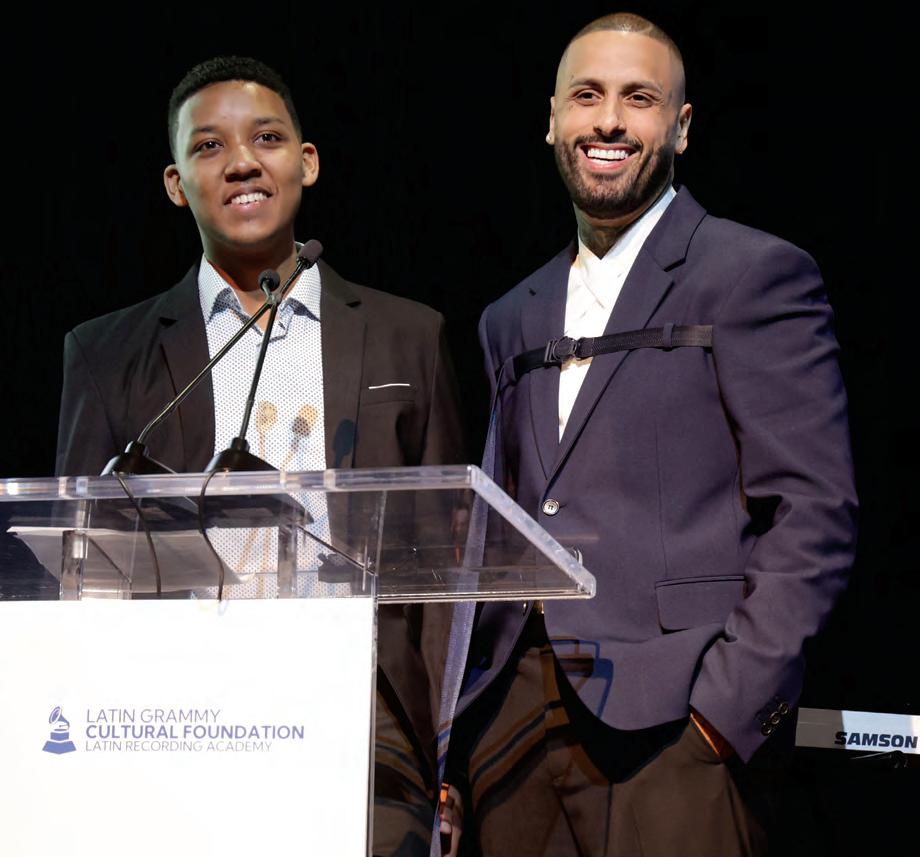
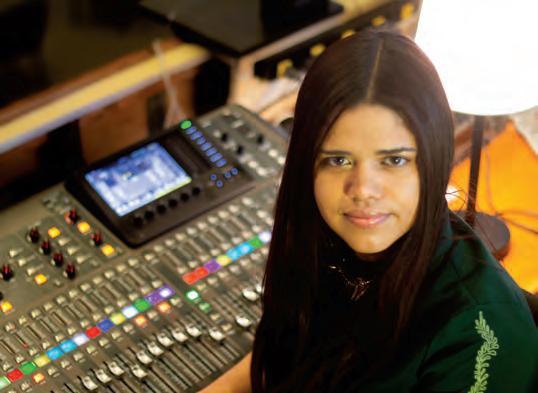
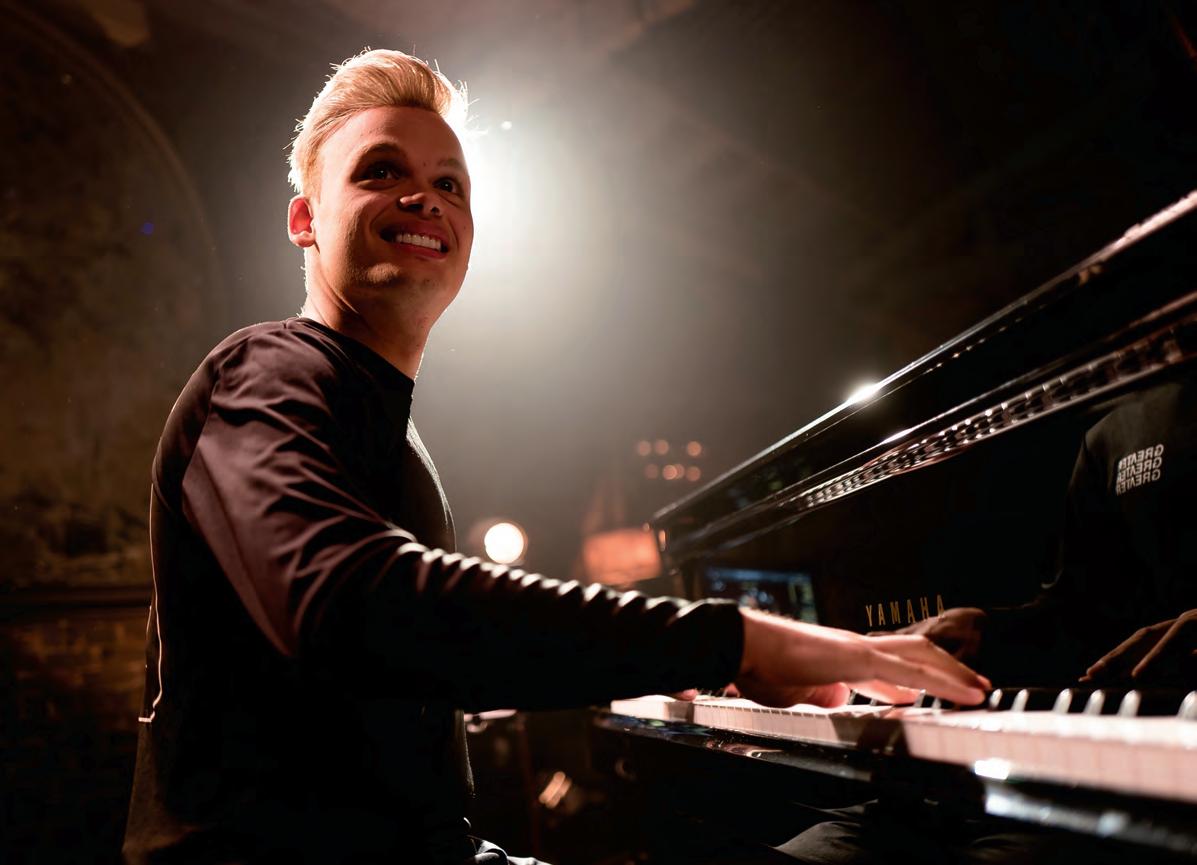
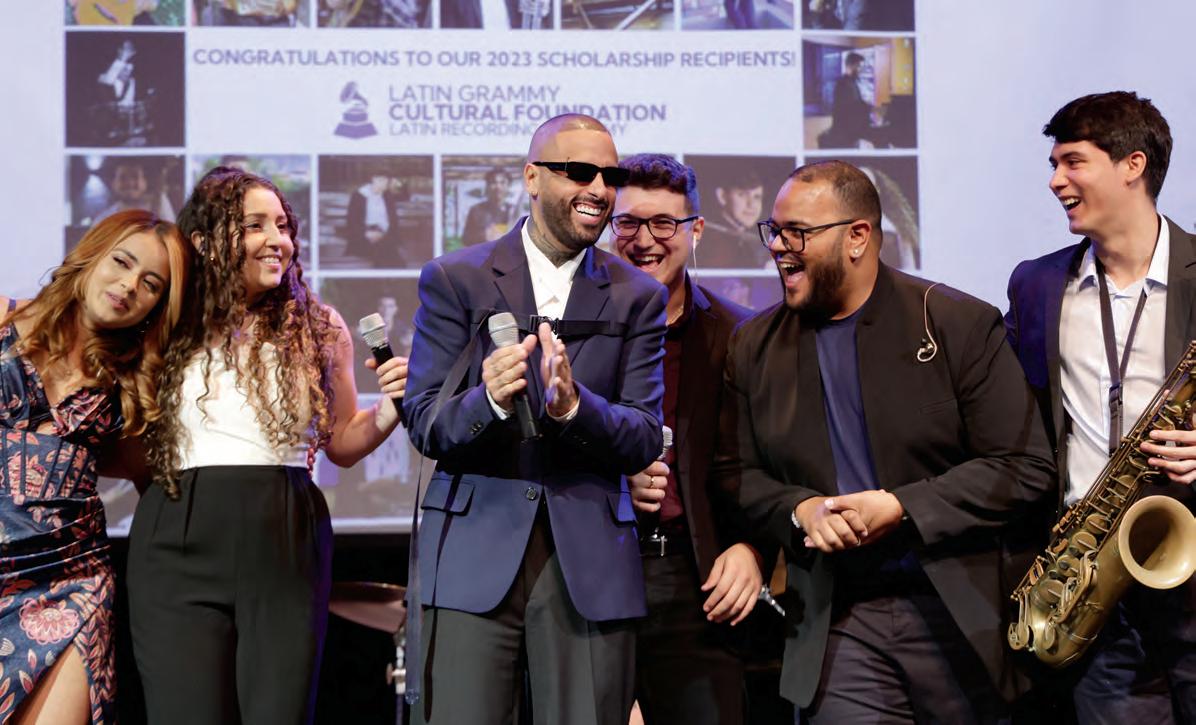
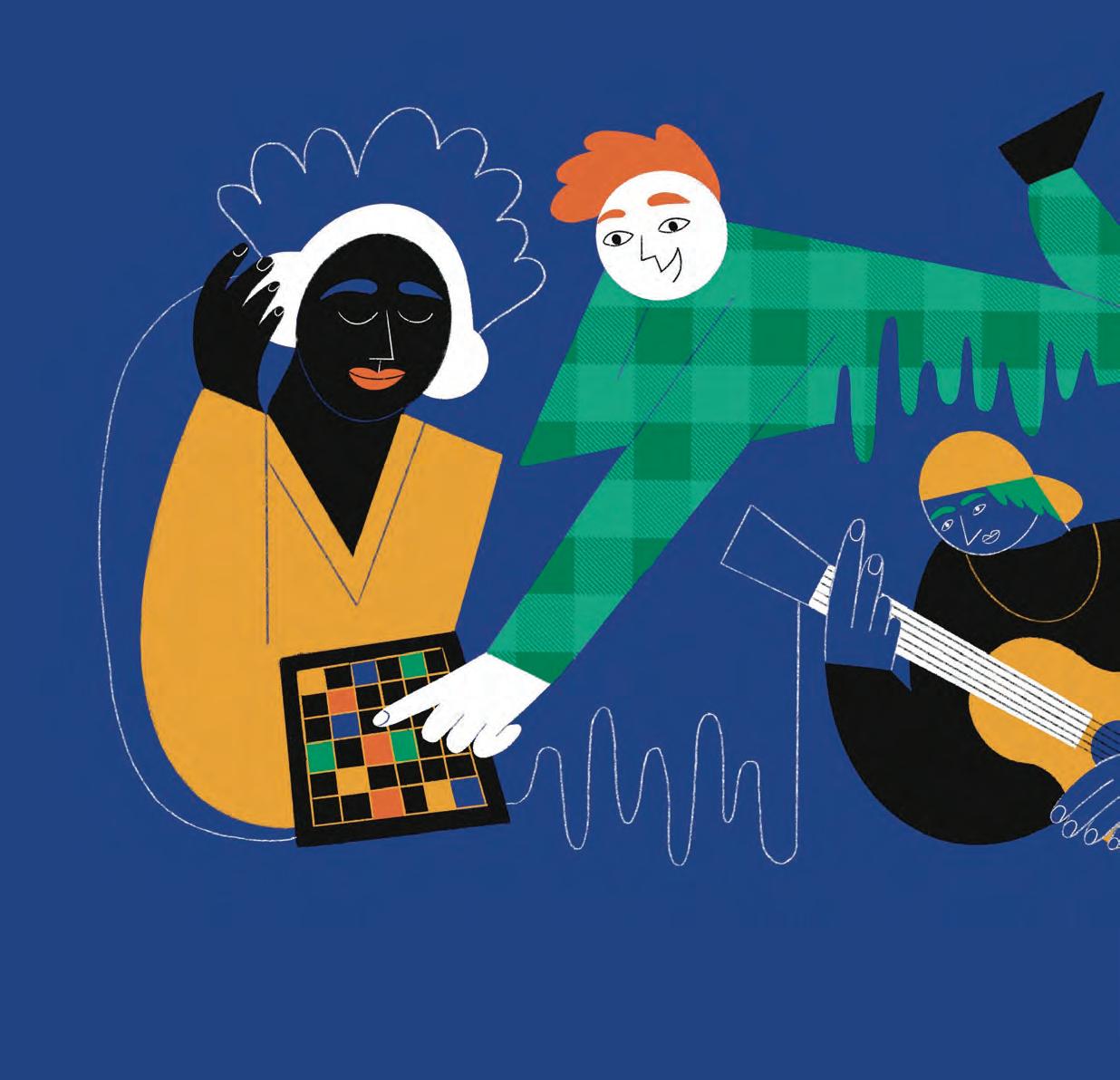
Music educators from elementary schools to high schools are using a wider repertoire, and technology, to engage an increasingly diverse student body.
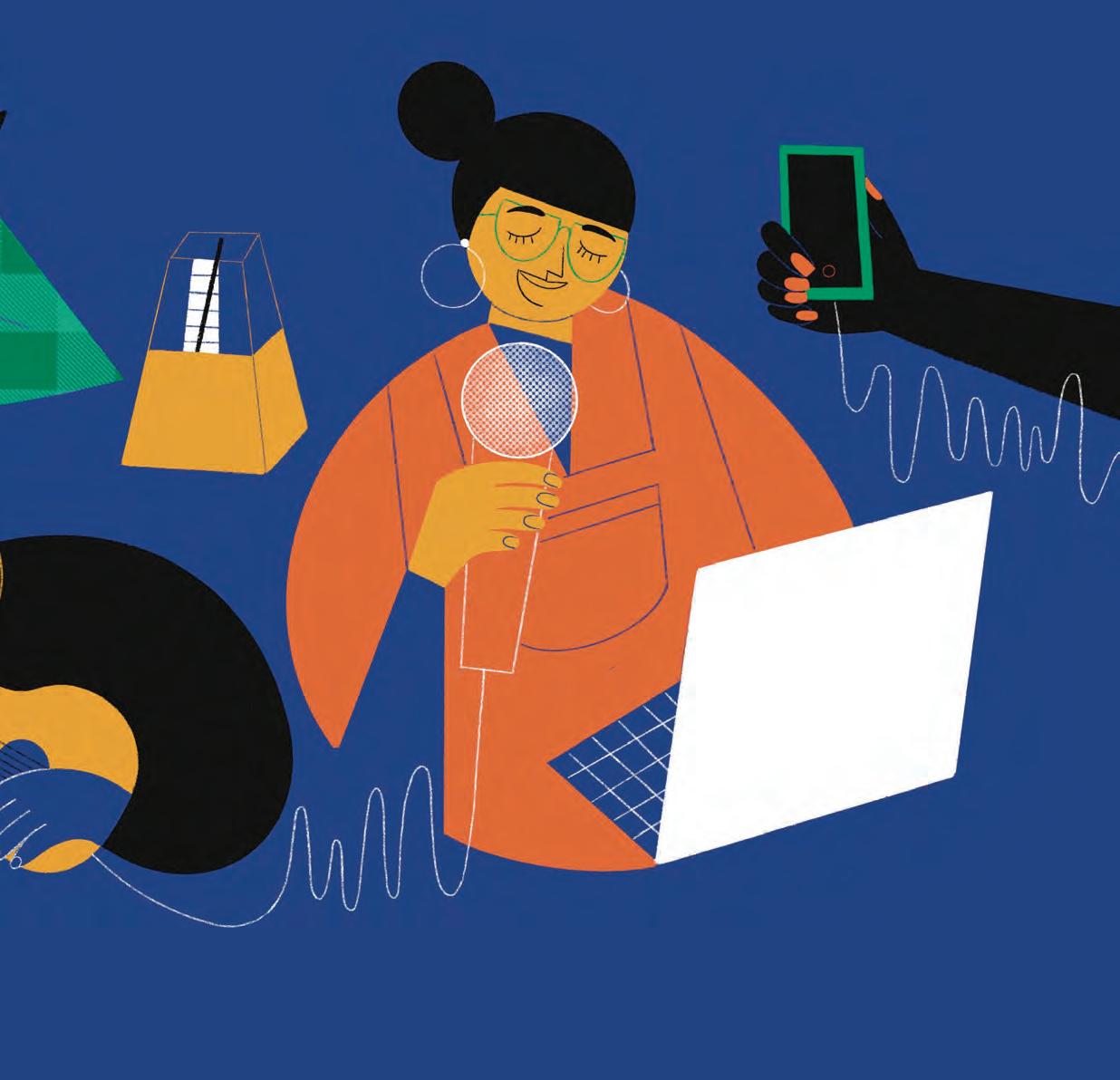
Playing “Hot Cross Buns” on a recorder is nearly universal in American
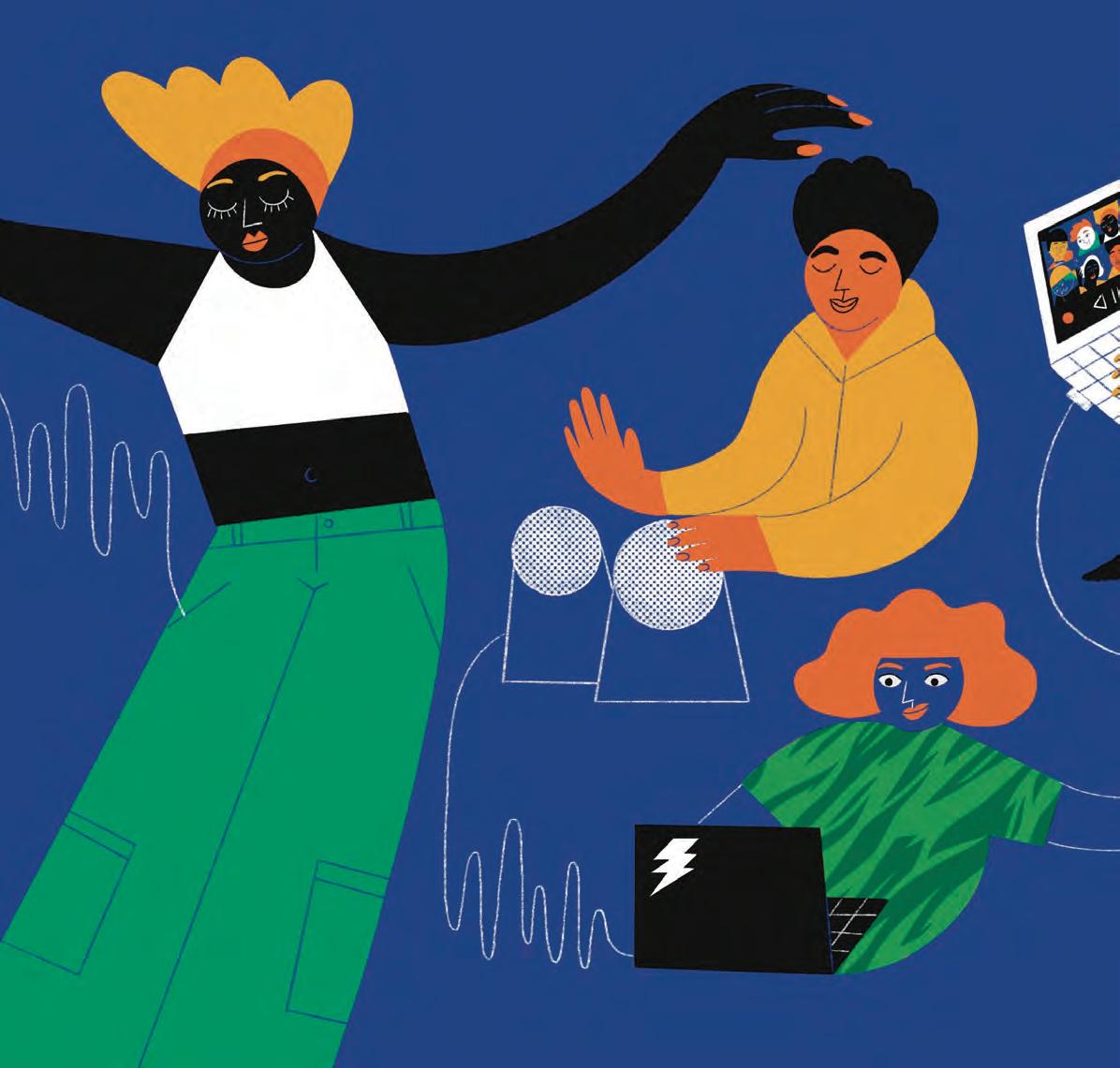
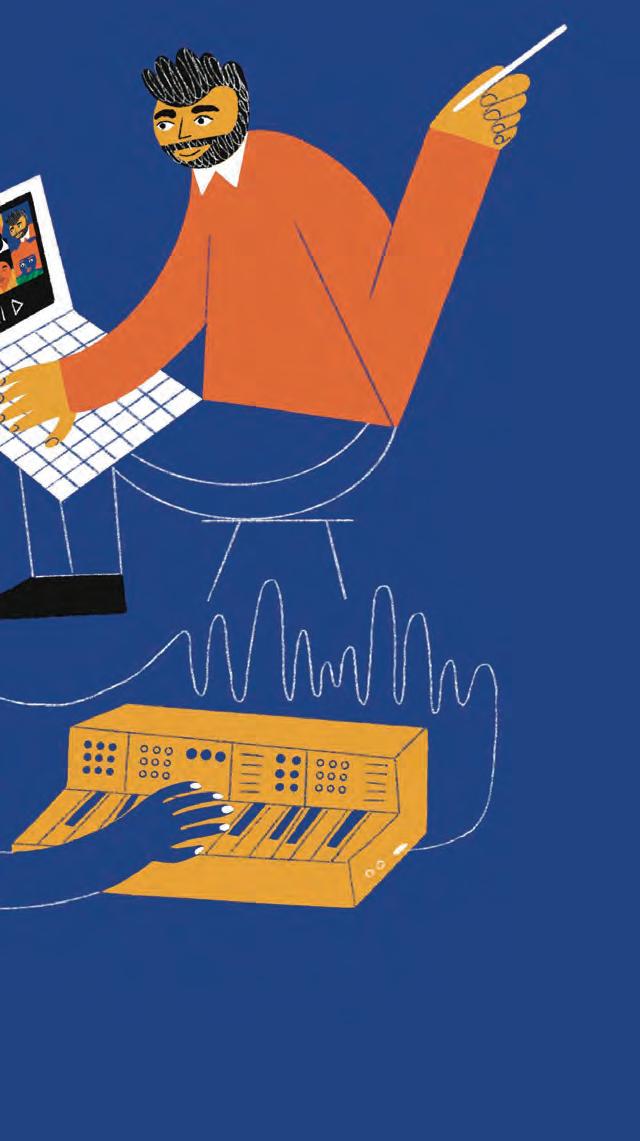
“We’re not just teaching about dead white guys anymore. Our [Berklee] students need to know and listen to and appreciate and understand the music their K–12 students are interacting with.”
RHODA BERNARD (RIGHT), ASSISTANT CHAIR OF BERKLEE’S MUSIC EDUCATION DEPARTMENT AND MANAGING DIRECTOR OF
sounds a little different in the classroom of PATRICK PATE B.M. ’08, M.M. ’22. That’s because, in an attempt to appeal to his fourth-grade students’ more modern tastes, Pate created a collection of reggae-style beats—heavy on the bass—that he plays during their first foray into woodwind instruments.
Instead of dismissing the original melody as too childish, they hear the accompanying track and say, “‘Ohhh, I like this groove,’” says Pate, who works at the Carroll School, a private school for students with language-based learning differences. The basic B-A-G arrangement is suddenly more appealing.
That’s the idea.
An awareness of the need to meet students where they are— culturally and developmentally—has been a major change in pre-K–12 music education in
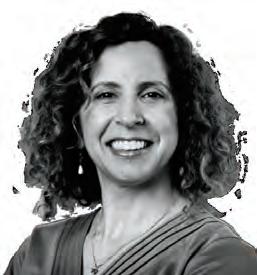
recent years, part of a broader shift in society and in education more generally to prioritize diversity, equity, and inclusion.
“We’re not just teaching about dead white guys anymore,” says Rhoda Bernard, assistant chair of Berklee’s Music Education Department and managing director of the Berklee Institute for Accessible Arts Education, which provides programs, support, and resources to expand opportunities for people with disabilities in all aspects of performing and visual arts education. “Our [Berklee] students need to know and listen to and appreciate and understand the music their K–12 students are interacting with.”
Pate’s efforts are emblematic of another trend as well, one that was accelerated by the global pandemic: an increasing incorporation of technology into music instruction. In addition to teaching traditional music education staples, such as singing, playing instruments, and movement, Pate regularly includes assignments on Soundtrap, an online digital audio workstation (DAW) that lets students create and record their own music.
The importance of music education was legally enshrined
in the 2015 Every Student Succeeds Act, which included music instruction in the definition of a “well-rounded education.” And though the law, signed by President Barack Obama, set a national standard, in practice its implementation looks vastly different from state to state and even from district to district, depending on tax revenues, budget priorities, and parent and school board preferences. Still, across the country, schools have generally tried to expand their musical offerings, says Cecil Adderley, chair of Berklee’s Music Education Department. TV shows like Glee and musicals like Hamilton led to an increase in show choirs and musical theater classes. Teachers have also started mariachi ensembles, modern bands, and hip-hop groups.
“The beauty of those ensembles is that you can serve a lot of kids with one teacher,” Adderley says. “That’s provided opportunities for students who might not be interested in traditional band or orchestra.”
JOHN KENDALL B.M. ’93, a teacher at Sarasota Middle School, has seen this happen firsthand. About three years ago, he created a modern band class through the nonprofit Little Kids Rock (now known as Music Will), which offers free instruction and instruments to public school districts across the country. The
class has proved popular—demand exceeds the approximately 22 spots each year—but his choir, traditional band, and orchestra classes remain full, with about 110, 120, and 30 students each, respectively.
In other words, the modern band course isn’t taking students away from more conventional music classes. Instead, it draws in “a different clientele,” Kendall says.
Greater awareness of the need to connect with students across different ethnic, socioeconomic, and learning backgrounds is also growing. In 2022, MARKEISE R. RUSSELL B.M. ’15 returned to the high school he had attended to become its assistant principal for teaching and learning. When he was enrolled at Chicago’s Saint Patrick High School between 2007 and 2011, he had been one of the only Black students; today, he is the first Black administrator to lead the 162-year-old school, which now has a majority Latino population. One of his goals for the choir he leads—which grew from four kids to 30 in his first year—is to incorporate different styles of music in the “name of promoting student voice and student choice.”
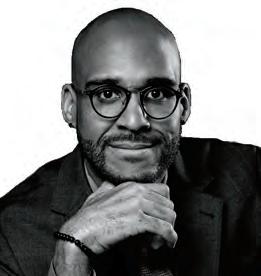
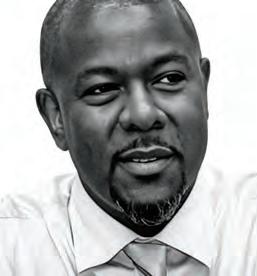
“One thing I notice about this generation is they like to take ownership of things,” he says. Other teachers are making similar pushes. When Pate worked in the Framingham Public Schools, he highlighted the history of African American music and its impact on other genres. Likewise, KATELYN DOWNEY M.A. ’21 , a music teacher in the Quincy Public Schools, teaches her students songs to celebrate Chinese New Year and dances from India (with the help of YouTube).
JASON PATERA ’98 , head of school at the independent Chicago Academy for the Arts, says Berklee taught him that any genre of music can be studied and pursued with rigor and integrity. He pointed out that his school’s most recent showcase featured performances in ballet, classical music, and Shakespeare as well as a finale featuring two singers—jazz and classically trained—who performed the Imagine Dragons song “Enemy,” written by JUSTIN TRANTER ’01 (Tranter is also a graduate of the Chicago Academy for the Arts).
“It was absolutely amazing,” Patera says. “And it underscored how legitimate even the study of pop music can be and at the same time how transformative for both students and the audience.”
In addition to including a variety of musical styles in their curricula, teachers and administrators are working to open music education to a wider student population.
Making music accessible to students with disabilities is the goal of the Berklee Institute for Accessible Arts Education. “A lot of the students in our graduate programs in music education and autism come to us already with a teaching job,” Bernard, who founded and directs the institute, explains. “They have been working with students with disabilities and want to do better or they love that work so much that they want to devote more time to it.” The Master of Music in Music Education (Autism Concentration) and Graduate Certificate in Music Education and Autism are the only programs of their kind.
Meeting students where they are has long been a priority for Berklee music education graduates. But the profession in general has struggled to keep up with changes in schools and students. According to a new report from the National Association for Music Education, coedited by Adderley, there is a general lack of diversity among music educators, and substantial barriers continue to prevent prospective educators from entering the field or from staying in the classroom
“Music teachers became film editors, sound engineers, recording engineers, and therapists— virtually overnight. We learned to utilize technology in ways we never had to before.”
MARKEISE RUSSELL
beyond a few years. The report offers potential ways to mitigate those barriers at various stages in a person’s career.
“The demographics of the students we serve are changing; the interests of students we serve are changing, and yet the teaching workforce isn’t necessarily changing as fast as the student population,” Adderley says. “What’s keeping people who are interested in arts education out?”
Bringing more technology, including the internet, into the classroom has also been instrumental in keeping music education relevant, engaging, and, in the case of the pandemic, possible. When COVID-related shutdowns began, Downey, like other educators across the world, had to find ways to teach—and reach—her K–8 students.
“For the first three weeks, nobody was really expecting anything of me,” she recalls. “I took it upon myself to make mini lessons on YouTube: ‘Here’s a steady beat; here’s an instrument you can make at home; sing along with these words; here’s a metronome.’”
Others also learned on the fly. “Music teachers became
film editors, sound engineers, recording engineers, and therapists—virtually overnight,”
Russell says. “We learned to utilize technology in ways we never had to before.”
Those technological resources remained a mainstay for teachers once in-person classes resumed. But the ubiquity of technology—and smartphones and social media in particular— has proved challenging as well.
“The more digital everyone’s playtime has become—as an educator, your sales pitch better be good,” Pate says with a laugh. “You’re dealing with shorter attention spans than ever before.”
Kendall says he confronts similar issues in his Florida middle school. “This technology is a part of their lives forever at this point,” he says. “How do we find a balance so that we can actually get something done?”
SONJAH HAWKINS B.M. ’88 has been teaching at the Renaissance High School for the Arts in Long Beach, California, since 2005. She says she thinks the pandemic heightened a shift in which students are more introverted in person, even if they lead very active online lives.
“We have a lot more visual artists,” she says. “We still have performing artists, but not as many. Students prefer to draw and not have to communicate with people. They have this fa-
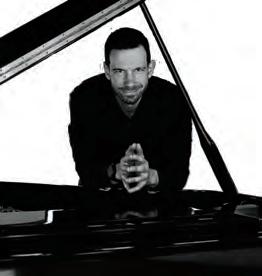
cade of who they are—they’d much rather be online talking with people.”
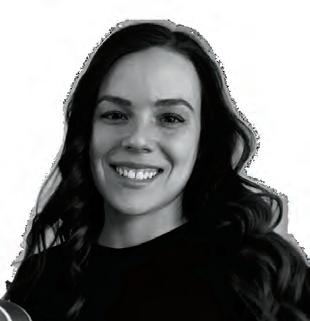
Just as pre-K–12 music curricula varies across districts, so does funding. In Sarasota County, Florida, where Kendall teaches, arts are broadly supported throughout the community (the school district has a partnership with the John F. Kennedy Center for the Performing Arts).
“Funding has never been an issue,” he says. “‘Let’s think about cutting arts’ is something you would never say in this district if you want to stay in this district.”
Russell, on the other hand, spent time in the Chicago Public Schools, where he regularly had to solicit grants to fund his students’ instruments and efforts.
“I grew up Catholic—I know how to fund-raise,” he jokes. “But there came a point in my career as a classroom teacher and band director where I was trying to give my kids experiences and I thought, ‘The more I do this, the more there’s going to be an expectation of me to fund my own existence.’”
Russell says one reason he became an administrator is to have a seat at the table where funding decisions are made.
“My voice was not loud enough from my classroom,” he says. “I had to constantly fight and beg for every resource I had. I’m excited to be in the administrative world [to help others see] that arts education is central” to education in general.
For all the challenges and changes, the rewards of teaching music in elementary and secondary schools remain the same: the chance to have an impact on children’s lives.
Kendall says he can remember his elementary school music teacher bringing in a Moog synthesizer as part of a unit on popular music, a rare offering at the time.
“It changed my life,” he says.
Now, Kendall regularly hears from former students who tell him he changed theirs. Their comments, he says, make him feel like “I must be doing something right.”
Russell was also drawn to the power of music to influence young people’s lives. He describes his childhood as “rough” and says he would not be where he is today—studying for a doctorate, helping lead his alma mater—if it weren’t for music, and, especially, music teachers. They “saw something in me that I did not see in myself” at the time, he says. “I am living proof of the transformative power of music education.”
PROFESSOR BRUNO RÅBERG RELEASED A CRITICALLY ACCLAIMED RECORDING FOR SOLO BASS CALLED LOOK INSIDE
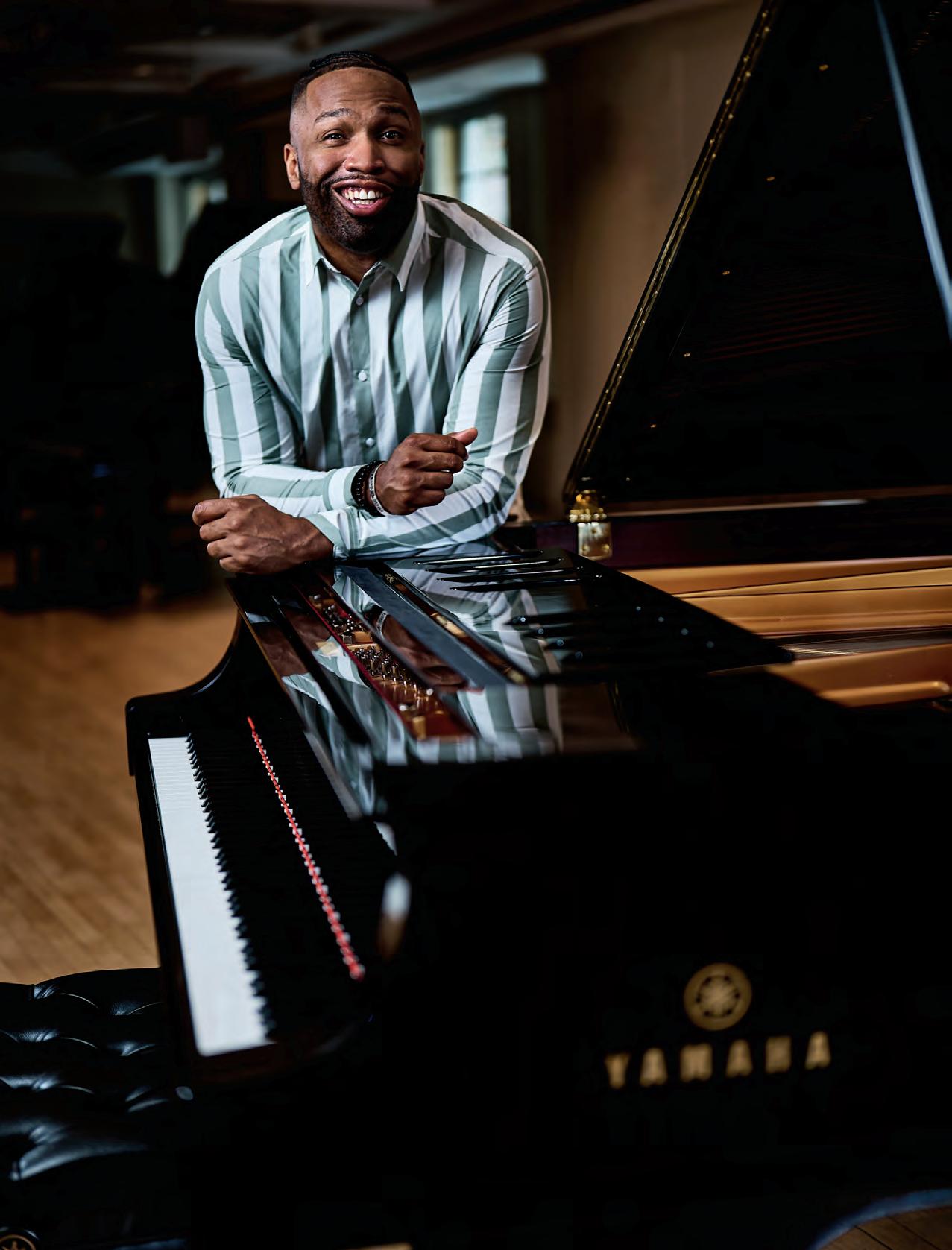
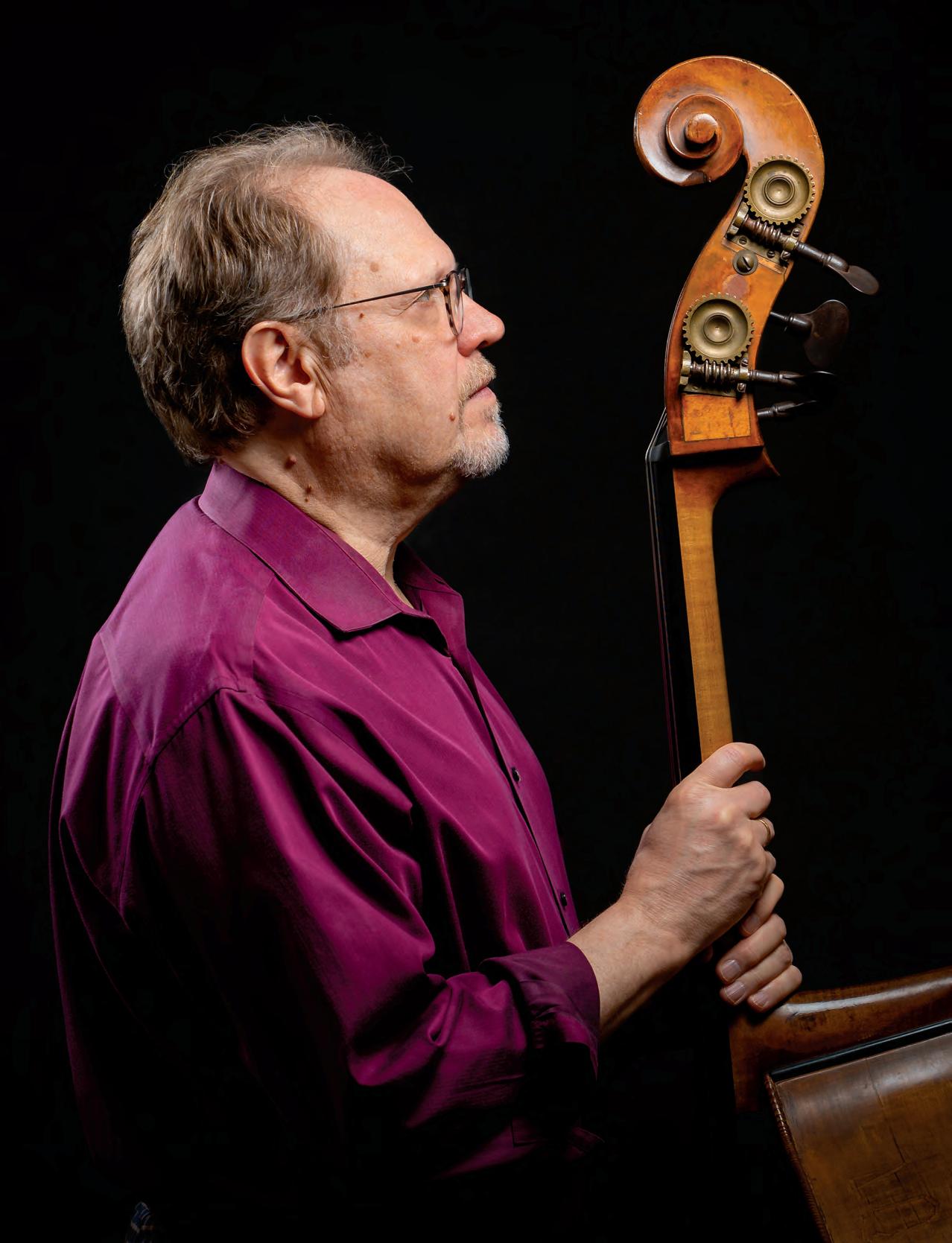
The Pedagogy Arts Collective helps Berklee faculty stay at the forefront of effective teaching strategies.
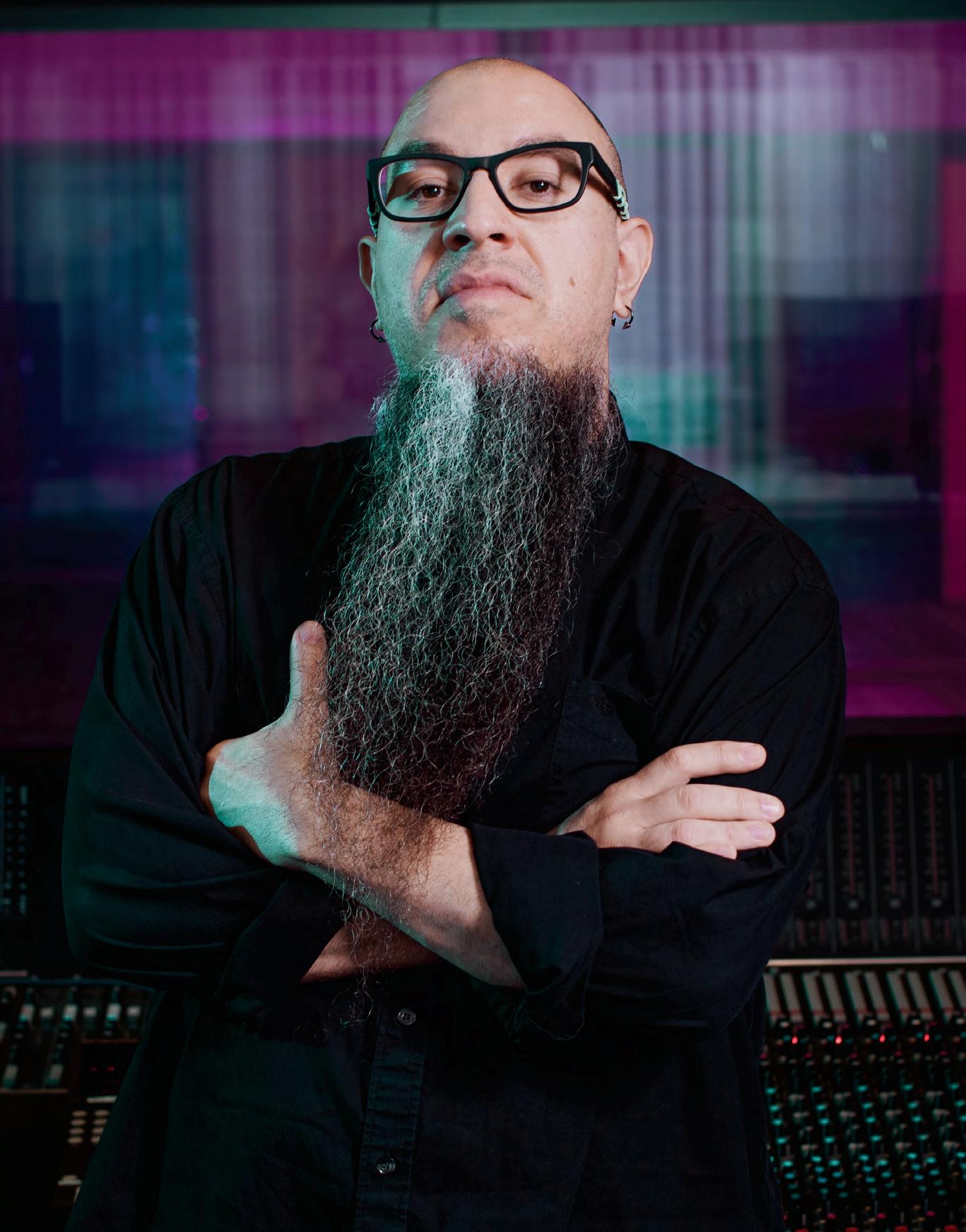
ASSOCIATE PROFESSOR ENRIQUE GONZALEZ MÜLLER IN A RECORDING STUDIO IN THE 160 MASSACHUSETTS AVENUE BUILDING THIS FALL.
Associate Professor ENRIQUE GONZALEZ MÜLLER (egm) has a tendency to dive deeply into everything he does. He’s now a decade into his career as a faculty member in the Music Production and Engineering D epartment (mp&e) after a 13-year stint as a globe-trotting engineer, mixer, producer, and arranger. He worked in the studio with major-label artists such as Metallica, the Dave Matthews Band, Nine Inch Nails, and Tina Turner, as well as with international acts, before focusing on education. He takes teaching seriously and has studied psychology of education at Boston University, pedagogy at Purdue Global, leadership at Harvard, and more.
A year and a half ago, egm began pouring his efforts into founding the Pedagogy Arts Collective (pac) at Berklee. A vehicle for sharing both cutting-edge and time-tested ideas on teaching, PAC offers seminars with experts from prestigious institutions and outstanding in-house faculty presenters as part of Berklee’s ongoing mission to prepare students for careers in the music industry.
Growing up in Caracas, Venezuela, egm was passionate about music and came to Berklee, where he earned his degree majoring in music production and engineering and in electronic production and design. Upon graduating, in 1999, he started his career in Sausalito, California, at The Plant Studios. As his professional reputation grew, he began receiving offers to work in Venezuela and Italy. Notwithstanding his success in the studio, he sought new inspiration and began taking psychology courses at the University of California, Berkeley, and thinking about education.
A chance meeting with a professor from Berklee brought an invitation to return to the college as a visiting artist. “I felt a surge of passion and creativity from the students and realized I had missed some of that in my work,” egm says. Not long afterward, he was hired to fill a faculty position in mp&e
While egm possessed deep production knowledge, he felt trepidation about his teaching skills. “I felt a lot of stress over trying to do the very best to train my students for their careers,” he says.
“I was exerting so much energy that I began feeling things weren’t sustainable, which propelled me to study how to make pedagogy more efficient.”
ENRIQUE GONZALEZ MÜLLER
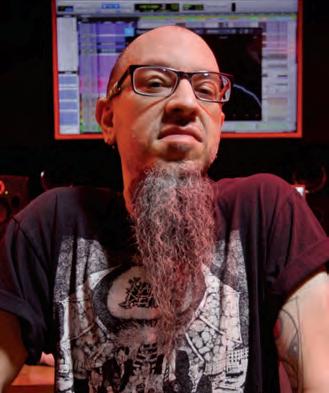
“But I was exerting so much energy that I began feeling things weren’t sustainable, which propelled me to study how to make pedagogy more efficient.”
Working with Roya Hu and Robert Lagueux in the Office of Faculty Development, egm developed his idea to form the Pedagogy Arts Collective to help faculty members who, like him, have incredible résumés as music professionals, but want to strengthen their training as educators. He proposed a pilot program involving casual meetings with speakers offering presentations and follow-up discussions.
egm’s aspiration is for pac to “serve as a robust, pan-college nucleus for all faculty and staff to collaboratively explore, share, and deepen our knowledge of innovative and effective pedagogy, educational psychology, and technology. pac would help onboard new faculty and staff as well as provide continued support and thought-provoking stimulus for experienced educators in the ever-evolving pursuit of pedagogy innovation.”
For the inaugural spring 2022 lecture series, egm enlisted Berklee faculty members to address such topics as how to succeed as an educator, how course design can help prepare students for careers, and what to consider for meaningful and effective grading. For the fall 2022 series, faculty presenters chose their own topics. The embrace of pac
by faculty and staff from Berklee’s Boston, Valencia, and New York campuses and Berklee Online prompted him to invite presenters from outside institutions.
The nine-week spring 2023 series included Appalachian State University’s Lillian Nave, who addressed culturally relevant pedagogy; Stanford University’s Drew Schrader, who spoke about strategies to authentically engage students; and Harvard University’s David Dockterman, who offered insights on how the brain changes as specialists gain expertise and ways to best support novices on their journeys to mastery.
Assistant Professor DAVID CARDONA says that pac has been an important resource for his growth as an educator: “It’s a space to share knowledge, techniques, disciplines, and details pertaining to teaching and learning. The sessions and discussions have enabled me to design robust curricula that keep accessibility and diversity at heart.”
The pac revisits proven educational concepts while also staying abreast of innovations, such as how to use principles of Universal Design for Learning (udl), which helps faculty members create a learning environment that accommodates the needs of Berklee’s diverse student population.
“ udl has raised awareness of the great and rich diversity of learners we encounter in and outside of our classrooms,” egm says. “Understanding and anticipating how to prepare for the various ways in which our students capture, retain, and creatively use information not only enriches the teaching and learning experience, but bolsters empathy and compassion, creating a unified sense of community.”
The nine-week series planned for fall 2023 will take up another evolving issue: artificial intelligence. “This advance in technology isn’t going away and for a lot of us, it’s new and uncertain, egm says. “Faculty members need to embrace it or our students—who are fearless about jumping into the deep end of the pool— won’t be well served.” By keeping faculty ahead of the pedagogical curve, egm and the pac are helping students make that leap.”
BERKLEE BOSTON
Associate Professor TSUNENORI “LEE” ABÉ wrote a 365-page arranging book published by Yamaha, and traveled to Japan for a promotional tour. The book, in Japanese, is called Popular Ongaku Henkyoku Taizen. The equivalent English title is Arranging for Contemporary Music
CECIL ADDERLEY, chair of the Music Education Department, co-edited the National Association for Music Education report A Blueprint for Strengthening the Music Teacher Profession.
Assistant Professor POOJA AGARWAL was a keynote speaker at SXSW EDU and was featured in an article by the popular news website Vox. Visit poojaagarwal. com.
Professor PRINCE CHARLES ALEXANDER was noted in a Grammy. com article about CHARLIE PUTH B.M. ’13: “Puth told the crowd he still thinks about Alexander’s advice when he’s making his own records all these years later.”
Assistant professors DAVID ALEXIS and ORLANDO CELA performed together during the Arlington Philharmonic Orchestra’s annual Pops Concert. The works were jazz standards arranged by Cela specifically for Alexis.
ESIN AYDINGOZ, who was assistant chair of the Screen Scoring Department until August 1, conducted live-to-picture performances of Disney Pixar’s Coco on tour. In addition, her original piece “Wondrous Journey” was premiered by the Royal Bangkok Symphony Orchestra.
3 Associate Professor CHRIS BERGSON toured in Europe this spring and summer with acclaimed soul singer Ellis Hooks, headlining France’s Talant International Blues Festival and Nuits Blues de Marnaz as well as Holland’s Blues on the River in Rotterdam.
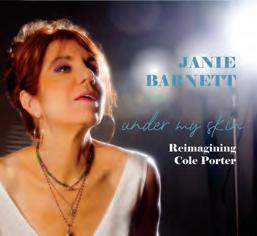
1 Associate Professor JANIE BARNETT released the album Under My Skin: Reimagining Cole Porter. The album features all-star musicians from Nashville to New York who contributed to these shimmering arrangements.
Professor LARRY THOMAS BELL
wrote music for the stop-action video A Brief History of Brooklyn, which ran for seven weeks in a Brooklyn Waterfront Artists Coalition’s show. His ballet Hansel and Gretel had two performances by the Hanover Theatre and Conservatory with the Worcester Chamber Music Society.
Associate Professor SERGIO BELLOTTI scored the soundtrack for Il Vecchio e il Muro, a short movie for which he won an award for best soundtrack at the Italian festival Tulipani di Seta Nera.
RHODA BERNARD, assistant chair of the Music Education Department, wrote an article about preparing music educators to teach students with disabilities for an international journal, and a chapter on how to foster the creativity of neurodivergent people in arts education settings for the Oxford Handbook on Creativity and Education.
Associate Professor SAUL BITRAN, is first violinist in the two-time Latin Grammy–winning group Cuarteto Latinoamericano, which released a new album, Pi-
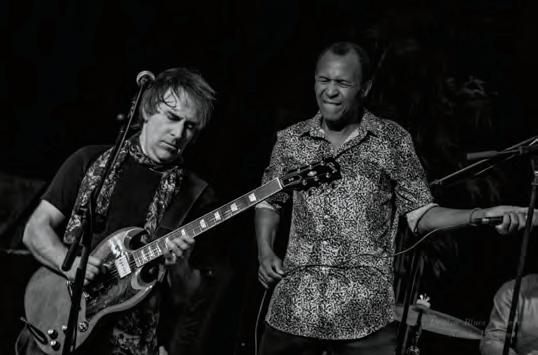
ano Quintets by Miguel del Aguila, with Sally Pinkas on piano.
Professor JOANNE BRACKEEN received the Jazz Gallery’s Lifetime Achievement Award in May. She also performed at Dizzy’s Club with her quartet. She’ll have a concert with other NEA Jazz Masters in Flushing, NY, in December.
Professor FERNANDO BRANDÃO performed and taught at the 2023 ABRAF (Brazilian Flute Association) Festival in Paraty, Brazil, in July. He also performed at the Jazz Night Series at Mandarim Gávea, Rio de Janeiro.
Assistant Professor PETER BUFANO is scoring the reality series Circus Town.
Associate Professor DANIEL CANTOR finished a new Dolby ATMOS
5 Assistant Professor DAVID CARDONA was the installation designer for DisOrgan, a sound sculpture featured at the Smithsonian’s Hirshhorn Museum. The installation celebrates how disabilities have transformed the landscape of innovation.
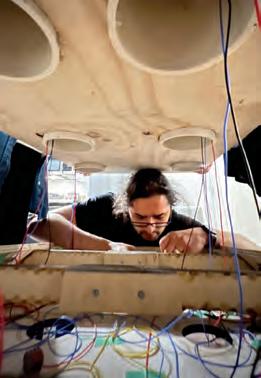
9.1.4 Genelec monitoring system at his Neve-based studio, Notable Productions. He also designed and installed a multicam PTZ Broadcast NDI and Midas/ Bose digital multitrack system at Roxbury Presbyterian Church.
RICHARD CARRICK, chair of the Composition Department, composed music for the concert Beyond Borders: An American Composer’s Korean Music Diary, performed at Harvard University, and for Sea, a work for music and dance performed with New Chamber Ballet in Brooklyn, NY.
Associate Professor ALEXANDER CLEMENTS collaborated with Mexican award-winning choreographer Ana Cuellar Ivanova, writing 45 minutes of Latin and world music for her contemporary dance show EnMi. It premiered in June in Orlando, FL.
KRIS DAVIS, associate program director of creative development for the Berklee Institute of Jazz and Gender Justice, released the album Live at the Village Vanguard. She’s one of a handful of female instrumentalists to record a live album at the historic venue. In September, she was on the cover of DownBeat.
Trombonist and Professor STEVE DAVIS performed with his wife, vocalist Abena Koomson-Davis, and Natalie Merchant on Good Morning America. The couple also appears on Merchant’s album Keep Your Courage and are recording Koomson-Davis’s debut album, Where Is Love.
Professor DAVE DICENSO had his third method book, Fluid Fills and Musical Phrasing, published. It was nominated in Modern Drummer’s 2023 Reader’s Poll as one of the year’s best educational products.
Associate Professor NOMI EPSTEIN released an album; had a CD-length single-movement composition entitled “cubes” commissioned; and went to London to record her third composer portrait album. Epstein’s experimental music ensemble, a•pe•ri•od•ic, celebrated its 50th concert.
Assistant Professor DEREK FAWCETT cowrote “Glass,” by Tommy Kim, and “Juggler,” by Pule, B3nte, and Jessica Chertock. He’s cowriting “Embers,” by Mari Kimenker; “Little Miss NYC,” by Jude Maloy; and his song “Every Time the Seasons Change.” He also hosted a live taping of The MusicAnswers Podcast at the APME Conference.
Professor TOMO FUJITA had a very special gig on August 10 at the Bitter End in New York City. It featured WILL LEE B.M. ’17, Associate Professor OZ NOY, and SHAWN PELTON
Professor LASZLO GARDONY is a voting member of the Recording
Academy. He’s also featured on Christian Artmann’s album The Middle of Life; teaches piano in Harvard’s Jazz Combo Initiative; and was featured in a tribute concert to the late WGBH jazz radio host Eric Jackson.
Professor BRUCE GERTZ’s song “For Burt” was a finalist in the 19th annual IAMA (International Acoustic Music Awards) competition.
MATT GLASER, artistic director of the Center for American Roots Music, gave the keynote address “Hiding in Plain Sight: Musical Threads that Bluegrass Shares with Its Stylistic Relatives” at the National Conference of the International Bluegrass Music Association in September.
Professor GABRIELLE GOODMAN released the album Jazz Life, which boasts six of the singer’s straight-ahead jazz compositions as well as jazz classics. Goodman also delivered the speech at Berklee’s honorary doctorate ceremony for ROBER-

3 Professor JERRY LEAKE and Assistant Professor BERTRAM LEHMANN recorded their latest album with the Indo-African jazz band Natraj, Ragmala Paintings Alive! It also features Phil Scarff, Rohan Gregory, and MIKE RIVARD B.M. ’18.
TA FLACK ’23H. Goodman was a backing vocalist for Flack on and off for 20 years.
Professor ANA GUIGUI was quoted in an article in RAMPD newsletter, which focuses on music industry professionals dealing with disabilities, about RAMPD Vice President PRECIOUS PEREZ B.M. ’22. Guigui was Perez’s private voice student for four years.
Instructor LYDIA HARRELL sang background vocals for Jon Batiste with the Boston Pops in September 2022, released the single “Don’t Let It” in March, and performed in Ragtime: The Symphonic Concert with the Boston Pops in May and July.
Assistant Professor RALPH JACCODINE spent a week in London with the BBC Concert Orchestra in BBC Maida Vale Studios. The recording session was conducted by Tony Award–winner Bill Elliott with Livingston Taylor, both former Berklee faculty members. It will be released in early 2024.
Professor HEY RIM JEON’s trio performed selections from her album Groovitude, which was in the top 20 on JazzWeek charts, at the Birdland Jazz Club. A billboard of her image was in Times Square, and she’s been a guest on several major TV, radio, and social media programs.
Professor JULIEN KASPER released his eponymously titled EP, which features ZAC CASHER B.M. ’90 (drums) and Jesse Williams (bass). Associate Professor MATT JENSON is featured on Hammond B-3 organ.
Associate Professor MANUEL KAUFMANN was commissioned to write an arrangement of “Peace,” by Horace Silver, for Eric Jackson’s memorial concert for a

live audience concert at WGBH’s Calderwood Studio in April. It featured several Berklee faculty members.
Professor KAYE KELLY was named a Commonwealth Heroine for 2023 for her dedication to arts and diversity within her community. Her faculty band, SheGrooves, was awarded over $8,000 from the Massachusetts Cultural Council to do a minitour. SheGrooves also received Berklee’s Chalk Hill Artist Residency in May.
Assistant Professor KIMBERLY KHARE, along with youth living with serious illness supported by her music therapy program Song Studio, performed two original pieces with Kendall Square Orchestra at its Symphony for Science at Symphony Hall. Her program also partnered with Pfizer for Rare Disease Day.
Assistant Professor JULIE KINSCHECK is continuing to teach vocal workshops based on her recent book release, Vocal Training for Praise Singers. She also plans to release the Vocal Training for Praise Singers Online Singing Course.
Associate Professor STEVEN KIRBY performed original compositions and arrangements at the most recent Jazz Educators Network (JEN) conference in Orlando, FL. His band included many Berklee alumni and current and former Berklee faculty members.
Professor TEODROS KIROS is publishing his 22nd book, Conversations with Noam Chomsky and the forthcoming Zara Yacob’s Inauguration of Modernity: Cardiocentrism, and will appear on Black History in Two Minutes with Henry Louis Gates Jr. He also had
several articles published in FUSION Magazine.
Professor BARBARA LAFITTE was named the Copland Chamber Music Librarian at the Tanglewood Music Center in Lenox, MA, for the second summer in a row. She prepares chamber music of all styles for the Tanglewood fellows and coaches and organizes the library’s great holdings from the past and present.
Assistant Professor CLAIRE MARIE LIM was awarded the Queens Art Fund grant from the New York Foundation for the Arts in support of an album of electronic music, Light: Songs of the Sisterhood, which is being created with female-identifying and nonbinary youth of Asian descent in Queens. It will premiere this fall.
Professor ELENA ROUSSANOVA LUCAS had two of her pieces written for symphony orchestra: The Great Chaplin, a three-movement suite; and The Legend of Babylon, a tone poem, recorded by the Prague Radio Symphony Orchestra, conducted by Professor JULIUS P. WILLIAMS. The pieces will be released on a new album.
Professor ED LUCIE performed on the last three albums by JOHN STEIN B.M. ’84 , and on Professor JOE MULHOLLAND’S recent album. He also performed in March with the Boston Symphony Orchestra at Symphony Hall, and in July at Tanglewood.
Assistant Professor AUSTIN MCMAHON released an EP, Things Are Looking Up, after more than a decade since his last recording as a bandleader. It features Troy Roberts, Associate Professor NATE RADLEY, and Assistant Professor ANA PETROVA.
Associate Professor YOKO MIWA
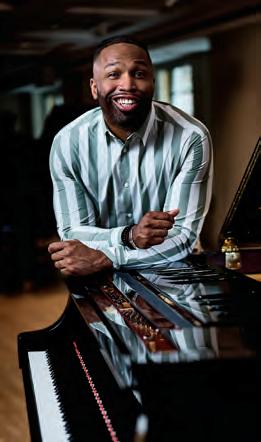
1 JOHN PAUL MCGEE, assistant chair of the Piano Department, received an endorsement by Yamaha Artist Services and joined the Yamaha Artist family in May. This is an invitation-only designation bestowed by Yamaha to musical artists considered to be critically acclaimed in their instruments or genres.
was nominated for the second year in a row for a Rising Star award for piano in the DownBeat Critics Poll. The Yoko Miwa Trio performed at Deer Head Inn in August and Scullers Jazz Club.
Professor JOE MULHOLLAND recorded a collection of original compositions and reharmonizations, including 14 solo piano pieces: eight for quartet and and six for sextet, featuring several Berklee faculty members. He also gave master classes at the JZ School in Shanghai, China.
Assistant Professor KEMAL OKSAL produced Earthquake Relief Project for Türkiye in response to the March 6 earthquake in the country. As the project’s music director, he produced, orchestrated, and conducted a song with Berklee students and faculty. More than 100 musicians were involved.
Associate Professor GEORGE OLDZIEY did orchestration work for the Netflix show Spy Kids: Armageddon. The orchestrations were recorded at AIR Studios in London.
Instructor SARPAY ÖZÇAĞATAY played flute on the track “View from Corcovado” from trumpeter Arturo Sandoval’s album Rhythm & Soul. The album was nominated for a Grammy Award.
Professor APOSTOLOS PARASKEVAS released two recordings: The Romantic Bach, on which he plays guitar, and Apostolos Paraskevas, 24 Essays for Guitar, featuring his original compositions. In 2022, the Boston Civic Symphony performed his work Santiago in the Stream. During his sabbatical this spring, Paraskevas worked on his book.
Professor LAUREN PASSARELLI released the album Snowcake, featuring Mike Bishop, Mary Douyard, Kate Chadbourne, LEAH BLUESTEIN B.M. ’20, and MIKE DUTKO B.M. ’20. She also launched the podcast Creative Conversations with Lauren Passarelli.
JONATHAN PERKINS, assistant chair of the Songwriting Department, was a songwriter on the Big Time Rush album BTR, which went RIAA-certified platinum, and a programmer and performer on the Chainsmokers’ single “Young,” which went gold.
Assistant Professor ANASTASSIYA PETROVA did a residency in Chris Potter’s band at Smoke Jazz Club in NYC and Side Door Jazz in Connecticut. She also brought Berklee Jazz and Gender Justice Institute students to perform at Charles River Jazz Festival and finished a residency at the Isabella Stewart Gardner Museum.
Assistant Professor RENE PFISTER debuted and directed his musical adaptation of Alice in Wonderland at the Poly Theatre in Beijing, China. It is on tour through the end of December. This fall, he will present at the 2024 Musical Theater Congress in Argentina.
Assistant Professor DEBORAH PIERRE, also known as Debo Ray, is performing five concerts as part of her residency at Regent Theatre in Arlington, MA. The first was a tribute to Stevie Wonder, celebrating the 50th anniversary of his record Innervisions. She also made her operatic debut with the Nashville Symphony.
MARCO PIGNATARO, managing director of the Berklee Global Jazz Institute, is releasing his fourth album as a leader, Chant for Our Planet. He also received an award at the Panama Jazz Festival, served as musical director of the JazzBoston appreciation concert Love Notes, and went on tour in Israel.
Professor MIMI RABSON’s newest book, Berklee Violin Chords, Arpeggios and Etudes, was published by Berklee Press. It includes updated classical pedagogy and jazz chord progressions. Her work “Construction,” was premiered by the Jazz Composers Alliance Orchestra.
Associate Professor MIKAEL RINGQUIST performed the composition La Pasión Segun San Marcos as a soloist for two nights with the Gateway Chamber Orchestra in Clarksville, TN. Ringquist has also been a collaborator for the creation of this classical work.
Assistant Professor BROOKS ROBERTSON released the album Pickin’ All Day Long. In addition
to releasing new original music, he performed solo concerts and taught workshops in Nashville, Oregon, California, and Colorado.
Professor WENDY ROLFE performed with Boston Baroque, Handel and Haydn Society, Cape Symphony, and at Lincoln Center with the American Classical Orchestra. In March, she gave flute recitals and master classes in five cities in Ecuador.
Professor NED ROSENBLATT’s Advanced Vocal Jazz Ensemble performed at the Jazz Education Network (JEN) conference and with New York Voices, and will perform at the Eastern Region ACDA Conference. The ensemble also won its third straight DownBeat Student Music Award.
Associate Professor KELLY SAVAGE performed two concerts, with Mystic River Baroque and Suore Project, in the 2023 SoHIP early music series. She presented a fringe concert at the 2023 Boston Early Music Festival with SIREN Baroque.
Associate Professor DANIELA SCHÄCHTER was at Jaffa Jazz Festival in Israel in October and is featuring her original music at Berk Hall in November with her quintet. She will also present a clinic at the 2024 Jazz Education Network (JEN) conference.
Associate Professor JACQUES SCHWARZ-BART released his 11th album, The Harlem Suite, featuring TERRI LYNE CARRINGTON, artistic director of the Berklee Institute of Jazz and Gender Justice. DownBeat wrote that it “bursts with artistic freshness and emotional conviction.”
Professor DAVID SCOTT (electric bass) and Associate Professor MARK SHILANSKY (piano) were
5 Professor JOHN ROBERTS has been playing with artists in the jazz arena, including Norman Brown, JEFF LORBER ’71, and Jonathan Butler, as well as soul and R&B artist Rahsaan Patterson, on top of producing records with WALTER BEASLEY B.M. ’84 and vocalist Lindsey Webster.
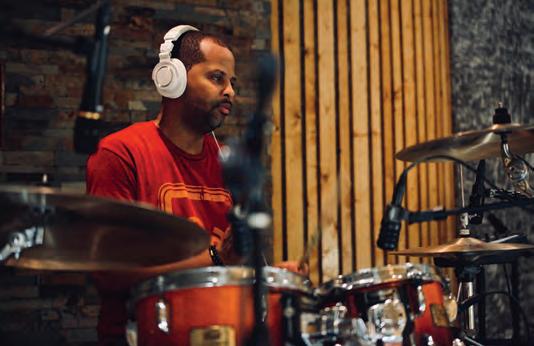
the opening act for BILL FRISELL ’77, ’17H, Tony Scherr, and Rudy Royston at the Spotlight Series at the Center for the Arts at the Armory in Somerville in June.
Assistant Professor RAY SEOL presented his leadership framework, called SWITCH and Embedded Leadership, at the 2023 NASPA conference in Boston and the Henley Business School Leadership Festival in London.
Assistant Professor ADRIAN SICAM completed his first 10 years teaching at Berklee and participated in a tribute to BURT BACHARACH ’09H. Videos of the live performances will be available by the end of 2023.
SEAN SKEETE, interim dean of the Professional Performance Division, serves as the Caribbean music consultant for the new animated series Disney Junior’s Ariel, inspired by Halle Bailey‘s Ariel and based on The Little Mermaid
Associate Professor MATTHEW STEVENS produced the album I Am a Pilgrim, celebrating Doc Watson’s centennial. The album features artists performing songs written by, or associated
with, WATSON ’10H. They include Dolly Parton, ROSANNE CASH ’18H, and BILL FRISELL ’77, ’17H
Professor LOUIS STEWART’s latest recording, Cambodia Agonistes, was released on the Denouement label. It’s an off-Broadway musical theater work that premiered in 1992 by Pan Asian Repertory Theatre with the Royal Scottish National Orchestra.
5 Assistant Professor
JOSE SOTO released his album
The Ancestral Call, which was influenced by the ancestral knowledge of the Bribri. The album’s launch concert was at Lincoln Center’s David Atrium. NPR named the album a “notable Alt.Latino favorite,” and it made Jazziz’s Editors’ Choice list.

Assistant Professor ALPER TUZCU released the single “Espírito,” which was featured on World Cafe’s Best New LatinX Playlist on NPR Music. It was mixed by mixing engineer Ricardo Mosca and mastered by CARLOS FREITAS ‘91.
Associate Professor NICHOLAS URIE wrote arrangements for the Fourth of July Boston Pops Fireworks Spectacular featuring the band LOCASH; Yazmin Lacey with the Metropole Orkest; and STEVE VAI ’79, ’00H with the Tampere Philharmonic Orchestra.
Associate Professor BORA USLUSOY engineered and produced artist Kalelio’s latest single, “Yalnizken Golgeyim.” Associate Professor TOM APPLEMAN also performed on the record.
Professor VICTOR WALLIS received the Charles A. McCoy Career Achievement Award from the Critical Political Science section of the American Political Science Association.
Professor JULIA WERNTZ’s released a microtonal and vocal music album, Someone Who Loves You Throws Me at You, features Associate Professor SARAH BRADY and assistant professors RANE MOORE and JEFFREY MEANS, as well as ROSE HEGELE M.M. ’18
Associate Professor IAN WIESE had his piece Adagio for Orchestra premiered in June by the Mostly Modern Orchestra at the Mostly Modern Festival 2023 in Saratoga Springs, NY.
Professor JULIUS P. WILLIAMS was recognized by the city of Newark, NJ, for his talent in the field of music. He was a guest conductor at the Isabella Stewart Gardner Museum and at the Monteux School and Music
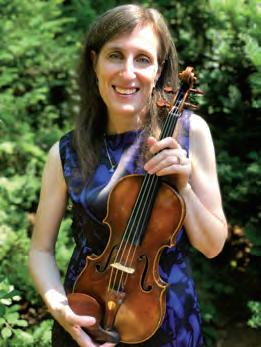
1 Professor FRANCINE TRESTER’s composition “In Her Element” will be premiered by the Kendall Square Orchestra in Sanders Theater as part of the Cambridge Science Festival. The premiere will be March 8, 2024, which is International Women’s Day, and will honor four pioneering women scientists.
Festival, and recorded with the Prague Radio Symphony Orchestra.
Assistant Professor JASON YEAGER premiered his album Unstuck in Time: The Kurt Vonnegut Suite at the Birdland Jazz Club. He also returned to Carnegie Hall’s Weill Recital Hall for an evening of improvised piano duets, and, with the help of a Berklee Faculty Recording Grant, recorded the album Sanctuary.
BOSTON CONSERVATORY AT BERKLEE
Professor KATE KOHLER ARMORY served as associate director, along with founding artistic director Tina Packer, of The Contention (Henry VI, Part II) from
Shakespeare & Company in Lenox, MA, this summer.
Associate Professor NAOMI BAILIS taught on the theater faculty of BUSTI (Boston University Summer Theater Institute) for five weeks this summer.
Associate Professor CANDICE BROWN played Hazel in The Children at the Gamm Theatre; contributed to the book Building Embodiment Integrating Acting, Voice and Movement to Illuminate Poetic Text; and taught acting in an intensive workshop at Ohana Arts in Hawaii.
Associate Professor ALISSA CARDONE performed at Boston’s Institute of Contemporary Art with Sandbox Percussion and Gandini Juggling as part of a work-inprogress piece combining music, dance, and juggling and presented by Summer Stages Dance @ ICA.
Professor JIM DALTON presented the paper “Privileging Interval Over Scale: Using Free-Style Just Intonation to Achieve Scaleless Bohlen-Pierce” at the conference Mikrotöne: Small is Beautiful Symposium 2023, in Salzburg, Austria.
Associate Professor SARA GOLDSTEIN spoke at the Music and Medicine Seminar at UMass Chan Medical School about her work on injury prevention for singers and instrumentalists in her Conservatory Alexander Technique workshops.
Professor LARRY ISAACSON conducted his 23rd patriotic concert at the Aspen Music Festival. This year’s soloists included performers from Dance Aspen and bagpipers from the National Piping Centre in Scotland.
Associate Professor PAUL LARAIA was featured in The Strad magazine’s master class series.
Associate Professor EUN YOUNG LEE was awarded a 2023 Guggenheim Fellowship. This fellowship will support the composition of a new work for bassoon and string quartet, to be premiered by bassoonist Adrian Morejon and the Momenta String Quartet.
Assistant Professor TIMOTHY MCCORMACK’s new 50-minute piece for voice and ensemble, titled yours in the process of being absorbed, premiered at Austria’s Klangspuren Schwaz festival.
Professor RHONDA RIDER spent the summer performing and teaching at the Harvard Music Festival, Green Mountain Chamber Music Festival, Music from Salem, Shelter Music Boston, Tanglewood, and Yellow Barn.
Associate Professor ANGELA FARR SCHILLER was invited to speak at Boston Symphony Orchestra’s Tanglewood Learning Institute and Festival. Her talk, “Ragtime: Where the 20th Century Meets
the 21st,” spoke to the social politics of ragtime.
Associate Professor DAVID VALDES’s is releasing a young adult novel, Finding My Elf (Harper Collins). His book Spin Me Right Round (Bloomsbury) was named to the American Library Association Rainbow List, and Brighter than the Moon (Bloomsbury) got starred reviews from Booklist and School Library Journal
Associate Professor ELIZABETH WONG, a member of the Writers Guild of America, picketed since May 2. She’s also writing a poetry collection with five-time Bram Stoker Award recipient Linda Addison and artist Elizabeth King, as well as writing a TV pilot called Bingo Babes
Professor PERICO SAMBEAT released his last album Roneando. It features Sambeat, Instructor ALBERT SANZ, MIQUEL ÁLVEREZ M.M. ’21, Assistant Professor SERGIO MARTÍNEZ, and Tico Porcar.
5 Professor KAREN WALWYN joined Berklee in the spring. She received a Faculty Development Travel Grant and a Faculty Recording Grant, and was granted an award through the Faculty/ Chair Private Lessons Program.
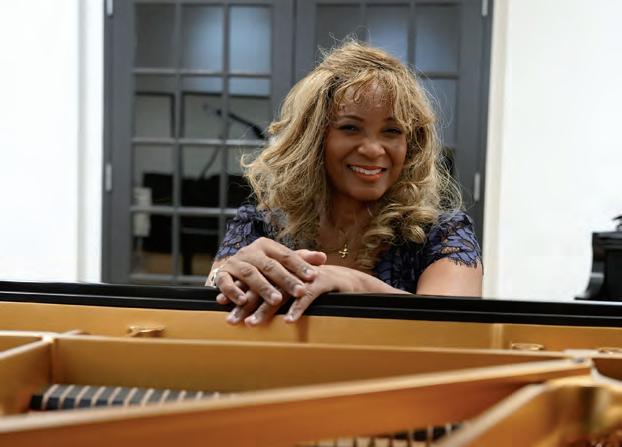
DUC B.M. ’17 of London, England, was the orchestrator for the movie Gran
. He has also written additional msuic and arrangements for multiple TV shows and films, including His Dark Materials, Man vs. Bee, and A Town Called Malice.
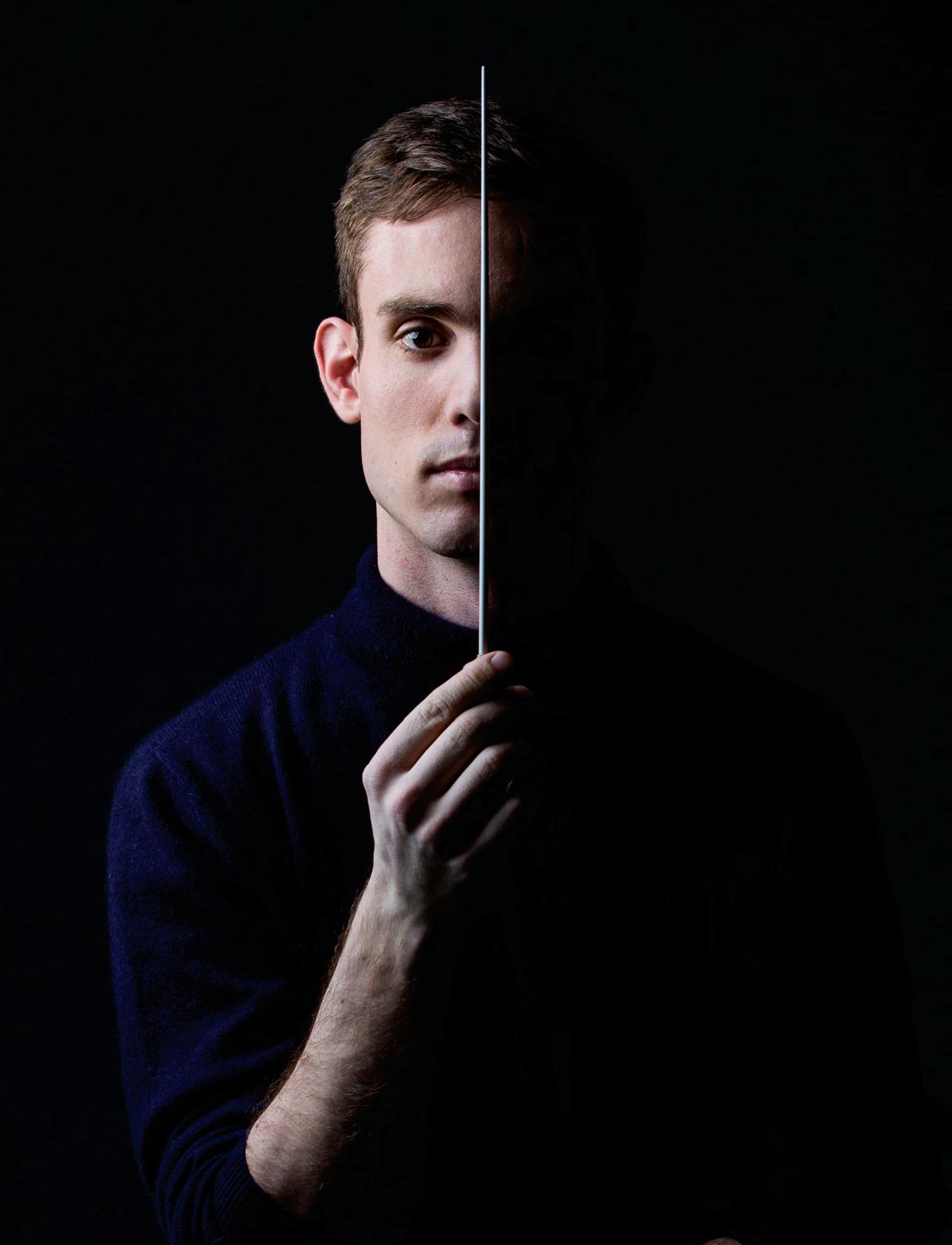
1965
DÀMARIS GELABERT FERNÁNDEZ of Barcelona, Spain, cofounded Grow Up Singing with the aim of enriching the lives of children with music.
1968
ROBERT FRITZ B.M. ’66 and M.M. of Newfane, VT, wrote and directed the film POEM, which was shown at the Tokyo Lift-Off Film Festival.
1970
HARVIE SWARTZ B.M. of Bronx, NY, is the bassist and recording engineer for, and producer of, three recordings by ALAN BROADBENT ’79
1971
KAZZRIE JAXEN of Callicoon, NY, was featured in an in-depth article for All About Jazz, “Kazzrie Jaxen: The Impulse of Creation.”
RANDY KLEIN of New York, NY, was a finalist in the Best Instrumental category of the International Acoustic Music awards.
1974
DENISE DECARO B.M. of Camarillo, CA, has a new album, The Very Thought of You and Other Love Letters
DAVID ALAN NEWMAN B.M. of Lititz, PA, performed with the late TIM PRICE ’73 for the last decade at clubs, festivals, and more.
1975
BOBBY DEITCH of Upper Nyack, NY, toured with Forever Ray, a Ray Charles tribute band, and performed Stevie Wonder songs with the Wonder Trio.
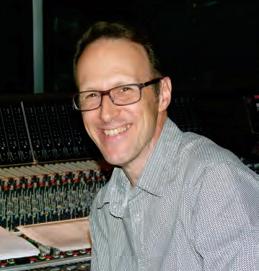
CARL FRITSCHE of Eatontown, NJ, is studying online at University of Dubuque Theological Seminary to become a pastor.
1977
RICHARD GIBBS B.M. of Malibu, CA, was elected governor of the Motion Picture Academy.
HARRISON ROBERT GOLDBERG of Gualala, CA, wrote the young adult novel Once Upon a Tune: One Young Man’s Quest to Become a Jazz Saxophonist.
1978
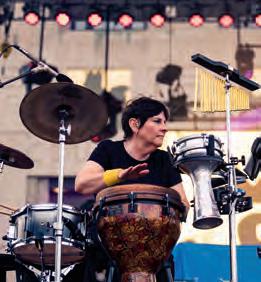
1
1980
MICHAEL J. PERSICO B.M. of Sandwich, MA, produced and directed “Classic Jazz Visions: The Photography of Jack Bradley,” a multimedia presentation of Bradley’s work with Louis Armstrong.
1982
HEIDI KNOWLTON LANGAN B.M. of Austin, TX, retired after 27 years of teaching, mostly at Austin Independent School District, where she taught elementary music.
7 LENNIE MOORE B.M. ’83 of Santa Rosa, CA, scored and implemented music for the video game Outcast 2: A New Beginning. He also released an album, Mentors.
5 CARL HOLZAPFEL ‘73 of Centennial, CO, stopped gigging after 45 years to focus on his online session drummer business.

1983
KRIS S. CHESKY B.M. of Denton, TX, joined Johns Hopkins University as a professor, investigating issues involving music and health.
JENNY HILL of Croton-on-Hudson, NY, plays saxophone and flute with Liquid Horn, which won a 2023 Performance Plus grant from Chamber Music America.
1984
SCOTT GERSHIN B.M. of Stevenson Ranch, CA, won a Children’s and Family Emmy Award for Outstanding Sound Mixing and Sound Editing for an Animated Program.
JOEL GOODMAN B.M. of Topanga, CA, released the album An Exquisite Moment, coproduced by JOE MARDIN B.M. ‘85 and recorded partly at Power Station at Berklee NYC.
DAN MOCKENSTURM of Clearwater, FL, recorded automated dialogue replacement for all three Guardians of the Galaxy movies.
MICHAEL NICKOLAS of Holden, MA, has written music for RuPal’s Drag Race, Married at First Sight, and Tyler Perry’s Bruh.
BARRY ROCKLIN of Revere, MA, spent 3,364 nights at sea performing both solo piano and vocal shows, and dueling pianos.
MICHAEL E. RUSSO B.M. of Doylestown, PA, is an audiobook narrator with 13 books to his credit, including I Was Playing Their Song, the autobiography of orchestrator Larry Blank.
1987
TONY DIMITO B.M. of Burbank, CA, is a music editor for MICDI Production in Burbank and NBC’s Lopez vs Lopez.
1988
THOMAS ALEXANDER STEIN B.M. of Gloucester, MA, is the inaugural department head for the School of Culture and Creativity at United International College in Zhuhai, China.
1989
DAVID BONDELEVITCH B.M. of Denver, CO, retired as a tenured associate professor after 30 years at the University of Colorado Denver and University of Southern California.
ANTHONY DEC of Southampton,
NY, is an independent podcast architect, strategist, and content developer.
DIMOS DIMITRIADIS B.M. of Corfu, Greece, is dean of the faculty of music and audiovisual arts at the Ionian University.
BOB FOLSE B.M. of Weston, FL, was a finalist in the Best Instrumental category of the International Acoustic Music Awards.
DAVE MULLEN B.M. of North Arlington, NJ, was the touring saxophonist with Gloria Gaynor. His his new jazz album, Solace, has garnered airplay internationally.
1990
JOHN BALDWIN of Elizabeth City, NC, was nominated for nine Trop Rock Music Association awards and had six top 40 songs on indie trop rock radio.
STEVIE BLACKE B.M. of Sherman Oaks, CA, arranged for Air Supply and Miley Cyrus: Endless Summer Vacation.
KEVIN JOSEPH GALIE M.M. of Maltignano, Italy, has 9 million streams for his re-orchestrations of Le Corsaire, La Bayadere, Laurencia, and Sleeping Beauty
KEVIN RAPILLO B.M. of Nashville, TN, is the drummer and bandleader for country artist Rodney Atkins.
1991
CRISTINA ABAROA of Sherman Oaks, CA, released Danilo & Chapis’s Vamos Al Zoo, an children’s album to raise awareness about species conservation.
1992
KEN VAN DRUTEN of Dallas, TX, is
the front-of-house live sound engineer for Jay-Z, Travis Scott, Justin Bieber, and many more.
JASON ECKHARDT B.M. of Kerhonkson, NY, was promoted to distinguished professor, the highest faculty honor at the City University of New York.
ANDREW GERMAIN B.M. of Calabasas, CA, authored Harmonious Mind of the Child
JASON JENNINGS B.M. of Burbank, CA, was the supervising sound editor for The Nun 2, by New Line Cinema and Warner Bros.
ADAM WAKE of London, England, signed an administration deal with Primary Wave publishing; cofounded the Disruptiv; and set up the Adam Wake Music Production Scholarship at Berklee.
ELIZA POLLACK ZEBERT B.M. of Encino, CA, was a supervising automated dialogue replacement or dialogue editor for films Ghosted, Flamin’ Hot, Silver Linings Playbook, and Frozen.
1993
STEVE MCALLISTER B.M. of Pflugerville, TX, released a new album, I Hope You Are Okay, featuring Dave Gregory (XTC) and Mike Keneally (Frank Zappa).
1996
ALEJANDRO MARTINEZ CASAMADA B.M. of Barcelona, Spain, cofounded the organization Grow Up Singing.
DEANNA DELLACIOPPA COLÓN B.M. of Las Vegas, NV, is lead actor in a Jardiance commercial and is in a Pepsi ad with Bad Bunny.
MICHAEL DREXLER of New York,
3 JULIE KINSCHECK B.M. ’87 of Billerica, MA, published the book Vocal Training for Praise Singers and graduated with a master’s degree in voice pedagogy from Westminster Choir College.
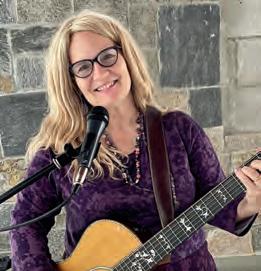
NY, senior vice president of business development Verifi Media.
JULIAN GRACIANO of Buenos Aires, Argentina, released a new album, Immersive Tango, with his group Graciano 4.
BETO HALE B.M. of Woodland Hills, CA, produced a classical album, Kairos, which was submitted for a 2023 Latin Grammy Award.
FRED HEDEMARK B.M. of Belmont, NC, won his second Sports Emmy Award for Outstanding Live Event Audio/Sound for his work at the Beijing Olympics.
MILTON MERMIKIDES B.M. of London, England, is the 37th professor of music at Gresham College, London’s oldest educational institution.
JUSTIN BALLARD B.M. of Hanover, MA, is the frontman and rhythm guitarist for the Chris Cornell
5 GEILA ZILKHA B.M. ’91 of Tokyo, Japan, released two albums, Covers and Originals, and was nominated for the Music Pen Graph Award in Japan.
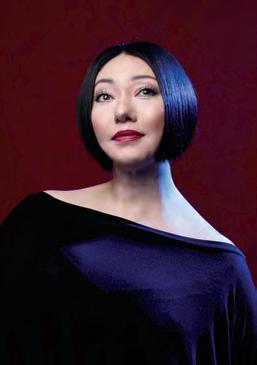
tribute band Song Garden.
STEVE HASS of Los Angeles, CA, toured and/or recorded with Ravi Coltrane, JOHN SCOFIELD ’73 ’97H, and Manhattan Transfer.
SHIE ROZOW B.M. of Valencia, CA, released a book about film music titled Every Note Tells a Story.
1998
BRYAN COOK B.M. of Los Angeles, CA, produced, recorded, and mixed Jeff Goldlbum’s jazz album Plays Well with Others
1999
DAVID W. COLLINS of North Hollywood, CA, was nominated for Emmys for sound design (The Mandalorian) and sound editing (The Book of Boba Fett).
RICHARD FURCH B.M. of Woodland Hills, CA, mixed the score for Assassin’s Creed Mirage for Ubisoft.
DAVE JOHNSTONE of Burbank, CA, is house band drummer and music director for Dave Koz & Friends at Sea.
2001
JOCELYN MEDINA B.M. of Boulder, CO, is on the voice faculty at the University of Colorado Denver and Metro State University of Denver.
DARCIE NICOLE B.M. of Ganei Modi’in, Israel, is a Berklee Career Network mentor and Grammy U mentor.
2002
JON P. DE LUCIA B.M. of Brooklyn, NY, has a full-time lectureship at Borough of Manhattan Community College.
PHILIPPINE DUCHATEAU B.M. of Vienna, Austria, is a jazz faculty member at JAM MUSIC LAB University.
MONICA GIRALDO B.M. of Bogotá, Columbia, performed at City Winery Boston.
SHAUN CUNNINGHAM B.M. of West Hills, CA, is the rerecording mixer for Family Guy, Futurama, American Dad!, and more
ALEJANDRO LOPEZ MACIEL B.M. of Vancouver, Canada, signed to Padre Records and released a single as El Parna Lopez.
JONATHAN HART PRICE B.M. of Forest Hills, TN, is vice president of supply chain operations for the Americas and Australia at BMG: The New Music Company.
2004
ADAM KESHEN B.M. of Los Angeles, CA, is the head of content administration at Hawk Inc., creating song placements for TV.
DANNY SULLIVAN B.M. of San Francisco, CA, designs and teaches
5
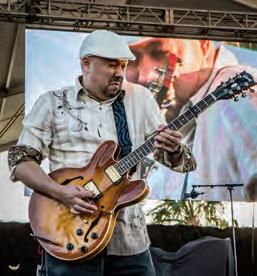
3 JUAN ANDRES OSPINA
B.M. ‘07 of Bogotá, Columbia, produced Karol G’s hit “Mientras Me Curo del Cora.”
music classes at San Francisco Ballet School.
MARK BYERS B.M. of Los Angeles, CA, was a music producer for RuPaul’s Drag Race and produced the new version of the theme song.
ZACHARY RAY of Randolph, MA, has had his music highlighted in Rolling Stone India and Vogue India, and is working alongside singers in India.
GIOVANNI ROTONDO B.M. of London, England, released his album 8-Bit Time Capsule in music-card format (Magic Deck Records), which offers a novel immersive listening experience.
AARON JACKSON B.M. of New York, NY, wrote the novel The Astonishing Life of August March, published by HarperCollins.
CHRISTOPHER JAMES VAZQUEZ B.M. of Los Angeles, CA, is program director and founding partner of SoundLife Music Academy, and tours as a guitarist for Air Supply.
2009
DAVID MICHAEL CELIA of Altadena, CA, co-composed music for the BBC hit show Death in Paradise
2010
SCOTT GASAWAY B.M. of Centerville, OH, directs Centerville High School’s high school band, which performed in the 2021 Macy’s Thanksgiving Day Parade.
TAVONNA MILLER B.M. of Brooklyn, NY, is an adjunct professor in the Theatre, Dance, and Arts Management Department at Long
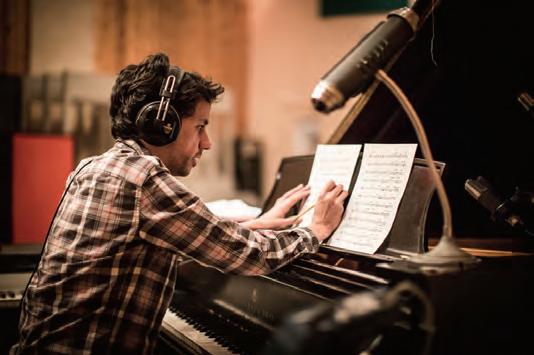
Island University Post.
JUSSI REIJONEN B.M. of Amsterdam, Netherlands, released the album Three Seconds | Kolme Toista with nine artists who were selected out of 576 ensembles.
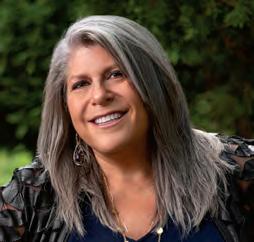
1 JESSICA SARIN-PERRY B.M. of Swampscott, MA, became the interim assistant chair of Berklee’s Professional Music Department.
JORDAN SEIGEL B.M. of Reseda, CA, arranged and performed a version of the song “Long, Long Time” for the HBO’s The Last of Us.
2011
SIERRA HULL of Nashville, TN, was nominated for two awards from the International Bluegrass Music Association.
AARON JAY MYERS M.M. of Arlington, MA, released an album of chamber music, Late Night Banter
CHARLIE ROSEN of Brooklyn, NY, won a 2023 Tony Award for Best Orchestration for Some Like It Hot.
BHRIGU SAHNI B.M. of Pune, India, released “Everytime” with music producer Karsh Kale and Bollywood singer Shalmali Kholgade.
MARCO SCORSOLINI B.M. of Rome, Italy, composes music for the
2012
SHANNON ALLEN B.M. of New York, NY, is the deputy general manager at the Lyric Theatre on Broadway.
JOSEPH CAPALBO B.M. of Fort Lauderdale, FL, had songs placed in ads for Coca-Cola and U.S. Bank.
IVAN CHOPIK B.M. of Los Angeles, CA, is the chief operating officer of Abasi Concepts.
BRIAN DILLON B.M. of Jersey City, NJ, joined the Broadway company of Disney’s Aladdin.
BRONWYN KEITH-HYNES of Madison, TN, was nominated for a International Bluegrass Music Association award.
SAM LUDDY B.M. of Methven, New Zealand, is the head of music at Mount Hutt College.
2013
GREY ARNEY B.M. of Boston, MA, makes Chinese-language songs about freedom and democracy, and has been featured on Radio Free Asia and Voice of America.
XIAO’AN LI B.M. of Allston, MA, is the composer for the new Tetris mobile game. He created the main theme for the game myVEGAS, which has 90 million users.
ZENIBA NOW B.M. of Brooklyn, CA, released the EP Wholly Chill with RODNEY BUSH B.M. ’11.
2014
DANIEL A. ALBA B.M. of Brooklyn, NY, is the engineer and producer at Zampol Productions.
JASNA GARA B.M. of Los Angeles,
Just two years after graduating, the alumna breaks record for the biggest debut of a jazz album on Spotify. BY
CHESTON KNAPP
Back in the spring of 2020, on the day before Berklee’s campus was shuttered because of the pandemic, LAUFEY (pronounced “Lay-vay”) recorded her first song. She was 19 and nursing a broken heart, and had been trying to write something that might free her of its hold on her psyche. After weeks of dead ends, something finally clicked and “Street by Street” came pouring out. It’s an intimate, confessional song about young love gone wrong and about taking back the reins of your life. Sung in a smoky vocal timbre and accom-
panied by minimalist jazz guitar, it dares you not to bob your head while listening to it. In the lonely and frightening weeks that followed, she released the song, more or less on a lark. And then she watched, with quiet awe, as it rose like a Chinese lantern, buoyed by the resilient light inside it. Soon enough, “Street by Street” was at the top of the charts in her home country of Iceland and she was on her way to becoming an international star. In many ways, she’s been preparing for this heady trip her entire young life.
Alumni Spotlight
Laufey
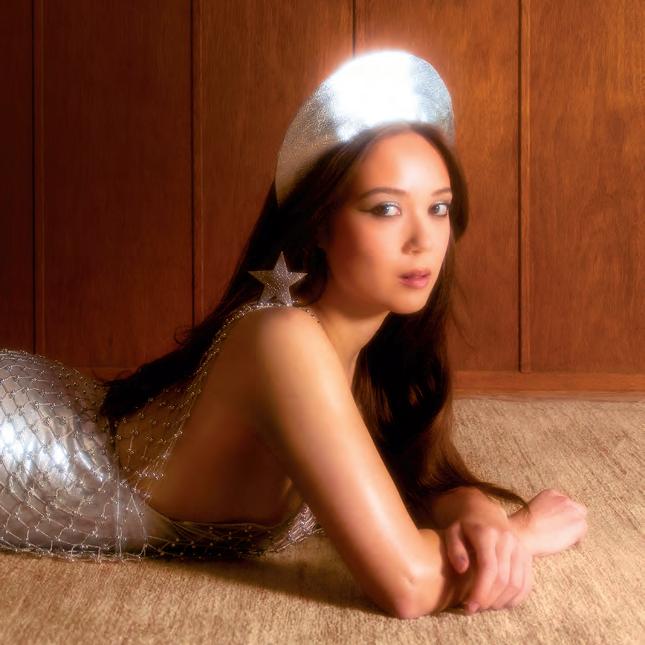
The daughter of a Chinese mother and Icelandic father, Laufey Lín Jónsdóttir B.M. ’21 grew up surrounded by music in Reykjavik and Washington, D.C., in an environment that sounds like a souped-up Baby Einstein program. Her mother is a worldclass violinist and her grandfather taught the instrument back in China. Laufey was studying violin and piano at an age when most kids can’t pronounce those words and, by 15, was playing cello solos with the Iceland Symphony Orchestra and appearing on Iceland Got Talent. (She finished in a humbling second place.)
Though trained as a classical musician, she’s always nourished a love of jazz singers like Billie Holiday, Ella Fitzgerald, and Chet Baker and had a fondness for the Great American Songbook. When it came time for college, she received a prestigious Presidential Scholarship to attend Berklee, where she found a way to harness all of her influences and pursue all of her interests.
“My whole goal as a musician is to bring these older styles of music to a new audience and frame it as something that’s new and relevant and cool,” she said with a guileless charm.
Success on the order she’s achieved—she’s amassed over 450 million streams across all platforms—can be disorienting for an artist at any age and disastrous for one so young. But Laufey has managed it with all the aplomb you’d expect from an old soul. She seems to know that success’s truest blessing is more work. In September she released Bewitched, her second studio album in two years, and the biggest debut for a jazz album on Spotify. It features elaborate and playful arrangements that honor her classical background—a couple of tracks feature London’s Philharmonia Orchestra—and her voice sounds as mature and seasoned as ever. And while she’s still mining the vein of young love, her lyrics have a knowing, wry wisdom to them, as when she sings, “It hurts to be something / It’s worse to be nothing with you.” Bottom line is, everything Laufey touches bears the thumbprint of authenticity, which is exceedingly rare to find. A true gift.

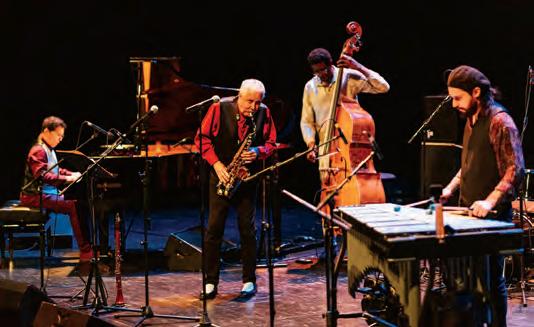
1 SEBASTIAN LAVERDE M.M. ’13 of Valencia, Spain, is a vibraphonist in the Paquito D’Rivera Sextet.
CA, is the production manager for LA Opera.
CAITLIN HEBB B.M. of Haverhill, MA, runs MedRhythms Therapy and joined the advisory council for the Academy of Neurologic Music Therapy.
TALI RUBENSTEIN B.M. of Boston, MA, released Memoire, which incorporates Hebrew melodies, classical harmonies, and improvisational jazz fragments.
IAN MOLINARO-THOMPSON B.M. of New Orleans, LA, toured with Terrance Simien and is a founding member of the New Orleans band Funk Griot.
MOLLY TUTTLE of Nashville, TN, was nominated for five awards from the International Bluegrass Music Association.
2015
ROBERTO HERMOSILLO M.M. of Santa Monica, CA, cocreated Fender Play guitar lessons in Spanish and was named Fender Play’s Latin music expert.
CHRISTOPHER CALEB HSU B.M. of Van Nuys, CA, is doing music production for Walt Disney Animation Studios.
TIMOTHY LEONELLI B.M. ’12 and M.M. of Abington, MA, is marching band director and director of music at Abington Public Schools.
SHANE SAGER of Boston, MA, has been on tour with STING ’94H as his featured soloist since 2019.
SMINOA SMIRNOVA of Astoria, NY, published a sheet music book, Kanklės in New York
SHERMAN DEWAYNE WOOD B.F.A. of Los Angeles, CA, toured with The Lion King’s Rafiki National Tour.
2016
NICOLE MARIE DILLMAN B.M. of Madrid, Spain, is the international sync manager at Alondra Music.
JULIAN HARRIS and JULIA CAMAYD B.M. of Miami, FL, are cofounders of the R&B band Soulpax, which will perform with the Killers and
the Chainsmokers.
2017
SAMANTHA ELLIOTT B.M. of Worcester, MA, facilitates music therapy groups for adults in recovery.
JENNIFER MCMAHON M.M. of Dublin, Ireland, founded Irish Women in Jazz, an organization championing female musicians.
DAVID MURILLO R. B.M. of South Pasadena, CA, scored music for Leguizamo Does America and Netflix’s Who Killed Sara?
MATT SCUTCHFIELD B.M. of Plymouth, IN, won an Indiana Arts Commission On-Ramp Creative Entrepreneur Accelerator Fellowship.
JOHN VARKADOS B.M. of Marietta, GA, won Best Student Video at the 27th Annual Webby Awards.
2018
ANDREW ANDRAOS of Boston, MA, released his song “Amore Mio,” which garnered over 2 million streams within a week.
5 NIKI GIERMASINSKI B.M. ‘15 of Lambertville, NJ, is the principal flutist of the revolutionary all-women’s Firdaus Orchestra of Dubai.
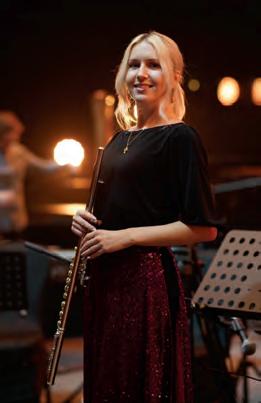
7 ELENA BONOMO B.M. ‘14 of Astoria, NY, is the drummer for SIX, the musical on Broadway.
ALAN HSIAO B.M. of Branchburg, NJ, is working on the third EP in his little songs series. The first got over 1.5 million streams.
NATHALIE BONIN of Burbank, CA, was named the 2023 Screen Composer of the Year by SOCAN.
MIKE CASEY M.M. of Los Angeles, CA, was selected by the Recording Academy for the Grammys NEXT Class of 2023.
SAMUEL ARTHUR SICILIA B.M. of Linz, Austria, is a soloist dancer with TANZ LINZ.
DI WU B.M. of Shenzhen, China, won first place in a national guitar competition.
ALEX HALLORAN M.M. of New York, NY, is an A&R representative at Missing Link Music.
MAMI MATSUURA of Roosevelt Island, NY, was a pianist and keyboardist on the North American tour of Cats.
TOMMY PEDRINI B.M. ’06, M.M. ’20 of Los Angeles, CA, worked on Nintendo’s Advance Wars 1+2: Re-Boot Camp as composer and core member of the music team.
AUTUMN MARIA REED of Delafield, WI, is a bassist and cellist with the Black String Triage Ensemble, which was featured in the documentary Black Strings.
2021
AHMAD ALJARRAH M.M. of Amman, Jordan, is a music instructor at Saudi National Orchestra.
ALEXIA BOBROWSKI B.M. of Man-
The fortuitous acquisition of a guitar opened up a path to success for Edward Moreta. BY DARRY MADDEN
In his early 20s, EDWARD MORETA SR. B.M. ’11 dropped out of Franklin Institute of Technology and started spending his time kicking around Boston’s Mission Hill neighborhood. He recalls his social circle at the time as being “very rough,” marked by guns and drugs.
One day, when a friend was unable to pay a debt, Moreta took the friend’s guitar as repayment. “That guitar saved my life,” he says. Until that moment, Moreta had not played a single note in his life, but the instrument forever changed his priorities.
“When I got the guitar, I remember [my buddies] calling me, ‘We’re going to a nightclub, we’re going to pick you up.’ And I’m like, ‘No. I’m practicing.’” Before long, he got serious about learning how to play, and a guitar teacher encouraged him to apply to Berklee. He thought getting in was such a long shot that he moved back home to the Dominican Republic after reluctantly submitting his application to the college. He received news of his acceptance during his first week in the DR—and promptly turned around and came back to Boston. Moreta worked full time at the Hilton near Berklee’s campus while also managing a full course load. A lot of days involved working a few hours at the hotel,
running to class, then heading back to work. It was hard, but he loved it. “I learned so much at Berklee. I would need two lifetimes to be able to use all the knowledge,” he says.
After completing his contemporary writing and production major, Moreta set out to find work as a producer, mixer, and mastering engineer. This was not
an easy path at first. “I knocked on so many doors after graduation, so many doors. I made so many calls and everybody was like, ‘Nope, nope,’” he remembers. But he was persistent and creative, and eventually built a studio in Roxbury, E7 Studios, where he happily worked on music he loved until 2020, when the pandemic shut
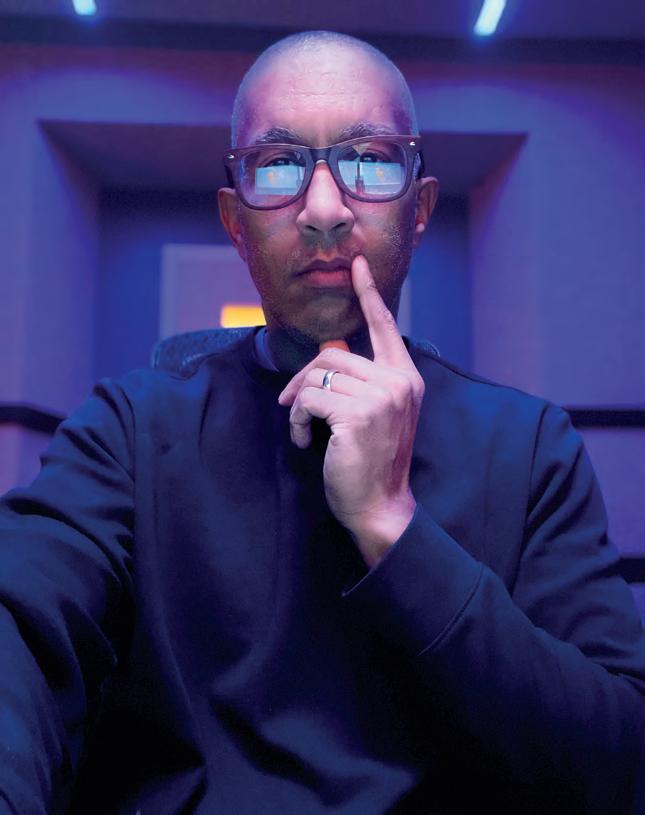
everything down. For a long year, there was no music in his studio, and he didn’t know what would become of all his dreams and hard work.
Then a request came in for a project that was small and low-budget: mixing a pop song by Guatemalan superstar Ricardo Arjona and reworking it into a bachata, a type of Dominican dance rhythm. When Arjona heard it, everything changed for Moreta. “Arjona came to us, said, ‘Oh my God, this bachata sound is amazing. I need to work with you guys.’”
Arjona shared the song on Instagram, where it went viral, garnering over a million views. This was a game-changer for the studio. As the world began slowly opening back up, E7 Studios came blazing back to life; since then, Moreta has been busier than ever.
Today, he works with clients such as Univision Boston, Aqui y Alla, and Hablemos on music as varied as merengue, bachata, salsa, rap, and dembow, a Dominican genre that borrows from Jamaican dancehall and Dominican folkloric traditions.
“I’m in constant motion and working with these different genres,” he said. “And there is so much energy in the Spanish-language music I’m encountering. It’s exciting. The sky’s the limit.”
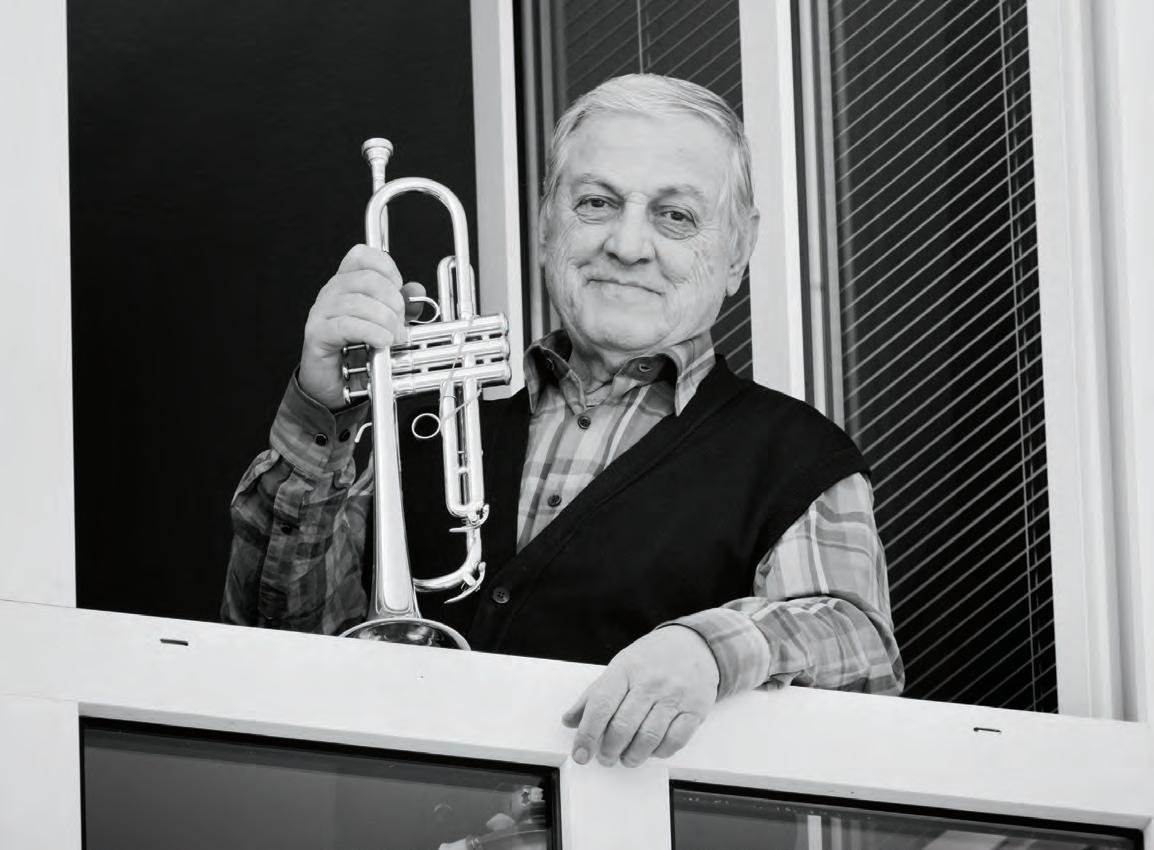
JOHN MORIARTY of Fall River, MA, died January 5, 2022. He was 91. A graduate of New England Conservatory, Moriarty formed an intensive opera training program at Boston Conservatory, where he was a faculty member. He was survived by his partner of 53 years, James T. Bynum; sisters, Frances and Helen; and several nieces and nephews.
JAMES T. BYNUM of Fall River, MA, died September 8, 2022. He was 77. Bynum worked at Boston Conservatory for many years, eventually becoming the dean of financial aid before retiring. He leaves several nieces and nephews.
JOSEPH KOO ’62 of Vancouver, Canada, died January 3. He was 91. Born in China, Koo became a leading music composer during Hong Kong cinema’s golden era. His first film composition was for the movie Love Without End,
which proved so successful the movie’s producer paid for Koo to study at Berklee. He received the Life Achievement Award at the Hong Kong Arts Development Awards in 2010.
NICHOLAS “NICKY” HOFFMAN
BEECHKO ’75 of Lindenhurst, NY, died January 14. He was 69. A musician at heart, he shared his talents with high school students as a special education teacher of math, science, and music in Boston and New York for 35 years. He leaves his wife, Joanne; son, Julian; daughter, Alexandra; and brother, AJ.
STEVEN ECKELS B.M. ’77 of Kalispell, MT, died April 3. He was 67. A teacher at Berklee from 1984 to 1985, Eckels spent the last 22 years of his career teaching guitar at Kalispell public schools. He also recorded 12 albums and authored 20 guitar textbooks. He leaves his wife,
JoAnn; son, Tyler; and sister, Deanna.
1 DUŠKO GOJKOVIĆ ’62 of Munich, Germany, died April 5. He was 91. The second recipient of Berklee’s Master of Global Jazz Award, in 2021, Gojković was a legendary jazz trumpeter, composer, and arranger. He was a major figure on the jazz scene on both sides of the Atlantic, playing and recording with DIZZY GILLESPIE ’71H, Stan Getz, SONNY ROLLINS ’03H, Chet Baker, and countless others. Though known for his melodic phrasing and high-class ballad renditions on the trumpet, Gojković played in many musical styles, from big band to bebop to Brazilian.
SARAH BODGE of Merrimac, MA, died June 21. She was 87. A graduate of Cambridge College, Bodge served as Berklee’s assistant director of Alumni Affairs throughout the
1990s. She leaves her son, Juan; daughter, Trae; sisters, Elizabeth, Gail, and Doris; brother, Hank; grandchildren; and great-grandson.
Student JARIN COLE of Killeen, TX, died suddenly on August 2 as a result of a medical condition. He was 22. Known as JC Stringz, Cole was a guitar performance major who came to Berklee after graduating from Temple College. He leaves his parents, Darron and Tina; grandparents, Oliver and Bernice; siblings; and many others.
CORLISS LEE CHING YI B.M. ’16 of Kuala Lumpur, Malaysia, died August 17. She was 30. She had been a double major in music business and contemporary writing and production while at Berklee. She leaves her husband, King Fai; brother, Bevan; and many others.
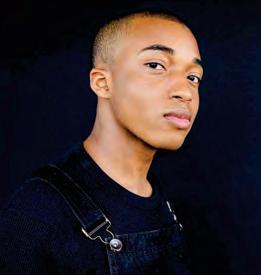
chester, CT, is a dance instructor at a performing arts high school and company member at IMMIX.
RICCARDO GRESINO of Los Angeles, CA, will be the music director and keyboardist for the 2024 North American tour The Life and Music of George Michael.
AARON HARRIS B.M. of New Bern, NC, launched the production company Future Soundwave.
STAN LEWIS B.M. of Peoria, AZ, was the music director for PATTI LABELLE ’96H and keyboardist for Seal and Kendrick Lamar.
RICKY ROMANO M.M. of Goshen, NY, is manager of rights management at the Orchard.
MATT SANGIOVANNI B.M. ’14, M.M. ’21 of New York, NY, played for Broadway and off-Broadway shows, including 1776, Dear Evan Hansen, and Chicago
AUBREY RUBY ROSAULI SITUMORANG B.M. of Los Angeles, CA, toured with The Life and Music of George Michael.
SAYRE HENLEY BAKER B.M. of Murfreesboro, TN, is the management coordinator at Make Wake Artists in Nashville.
ROGER M. BUSFIELD OF B.M. Sacramento, CA, opened the Sofia, a venue for theater and music.
ANNIE DICKINSON of Brooklyn, NY, signed Chris James (BTS, Jimin), PEGGY ’23, and others to record deals as an A&R representative at Nettwerk Music Group.
JAYEN DISLA B.M. of Miami, FL, released his debut album, Ultra Max (Universal Music).
7 CHE BUFORD B.M. ’22 of Brooklyn, NY, premiered When the Spirits Dance, a performance/installation piece in Berlin, Germany.
SEBASTIAN OLAYA B.M. of Brooklyn, NY, is the cofounder of the award-winning music production company Biscuit Head Collective.
WILLIAM PAZDZIORA M.M. of Rocky Hill, CT, co-owns the Voice Collective, a studio that specializes in lessons for contemporary and musical theater singers.
2023
SPENCER DENNIS M.M. of Mooresville, NC, was the recording engineer for Li Uzi Vert’s Pink Tape, which hit no. 1 on Billboard 200.
VARSHA KRISHNAMOORTHY B.M. of Boston, MA, was a finalist in the Best Female Artist category at the International Acoustic Music Awards.
ELEAZAR MORA M.M. of Miami, FL, won the gold medal in the Latin Music–Male Vocalist category at the 2022 Global Music Awards.
5 FELIX HERBST ‘18 of Boston, MA, was the violinist in the pit orchestra for Fiddler on the Roof during its national tour.
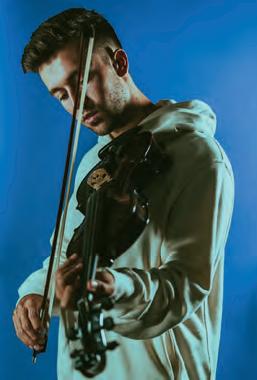
(CONTINUED FROM P. 56)
their male-identified counterparts, and looks at differences in job titles and primary teaching responsibilities. It found an overwhelming gender disparity among jazz faculty members in the United States, with men outnumbering women by six to one. Further, women are outnumbered in nearly every conceivable category: there are fewer women than men instructing popular jazz instruments and leading ensembles, as well as teaching academic subjects such as music history, theory, and composition. Also, women typically occupy a lower faculty rank.
While many in jazz education will not be surprised at the study’s findings, it offers critical information and presents a great opportunity to better address key systemic factors contributing to gender inequity in our institutions, such as hiring practices, course assignments, division of labor, and departmental leadership. The study can serve as a starting point from which we can come together to do the corrective work needed to modify the way jazz is perceived and presented. In doing so, the future of jazz can thrive without rendering invisible many of the art form’s contributors, among whom educators have always been included.
As the study makes clear, we have a ways to go as a cultural community. At the same time, we are further along than we have ever been. In colleges and universities with over 30 jazz faculty members, Berklee was among the schools with the most female-identified faculty, along with California Jazz Academy and the New School’s School of Jazz and Contemporary Music.
As JGJ grows and develops its ongoing “Jazz Without Patriarchy” initiatives, we are encouraged by Dr. Pellegrinelli’s much-needed expert study. A monumental cultural shift is occurring that will lead to more equitable conditions for all who seek to pursue careers in jazz and in music overall.
TERRI LYNE CARRINGTON
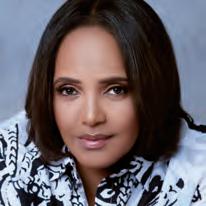
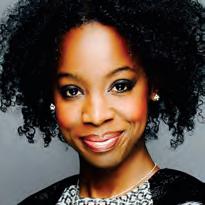
TERRI LYNE CARRINGTON & AJA BURRELL WOOD
The Berklee Institute of Jazz and Gender Justice (JGJ) was founded in 2018 with the aim to support and sustain a cultural transformation in jazz. The institute’s mission is to recruit, teach, mentor, and advocate for musicians seeking to study or perform jazz, using both gender justice and racial justice as guiding principles. Over the last five years, JGJ’s work has continued to make strides in the areas of jazz education, performance, and advocacy in the arts. However, there is still much to be done toward the goal of a more socially and politically progressive, more equitable “jazz space” where players, composers, teachers, writers, and other creative contributors represent a wider range of the gender spectrum. A cultural transformation has been needed for a long time, and though we are not there yet, we are experiencing noticeable momentum toward just-mindedness. In working toward this vision, it has been important for the institute to collaborate, amplify, and support the work of our colleagues across dis-
ciplines, as sustainable change can happen only through collective work.
Recently, we have been honored and grateful to support the work of Dr. Lara Pellegrinelli in the publishing of her new study, Jazz Counts: Measuring the Jazz Faculty Gender Gap in Higher Education. One of the many areas where gender disparity still persists, unfortunately, is on college and university campuses across our nation. Sometimes doing transformative work in jazz and gender means shedding light on inequities within different areas of jazz and jazz education in order to establish an undeniable baseline from which we can all improve, creating a better future for artists and the artform itself.
Dr. Pellegrinelli’s study collected publicly available information from over 200 colleges, conservatories, and universities, resulting in the first quantitative data of gender representation among faculty members who teach jazz. Her study considers the number of female-identified jazz educators in comparison to
(CONTINUED ON P. 55)
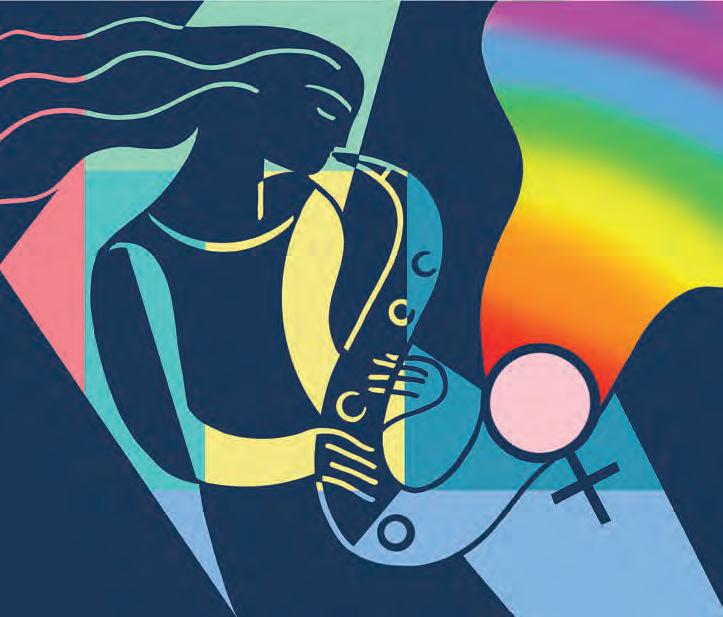
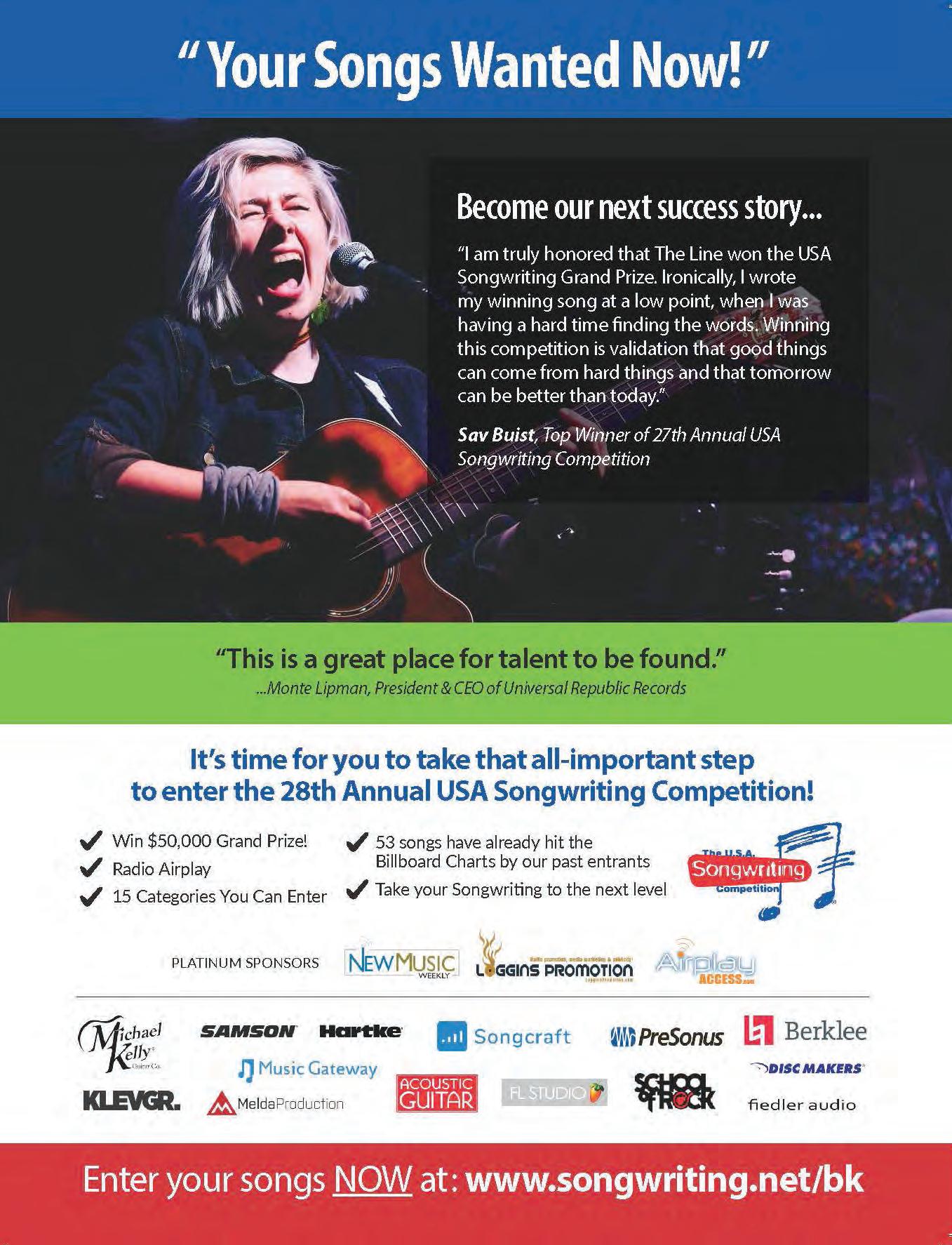

“As AI-generated music becomes— while not necessarily equal to human-made music—sufficient, in certain cases, we can’t be putting our heads in the sand.”
SEE PAGE 18